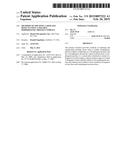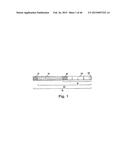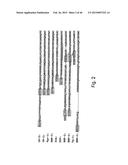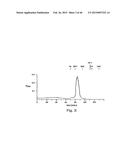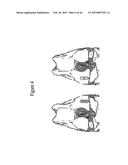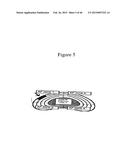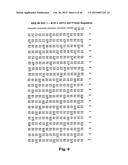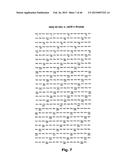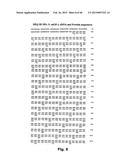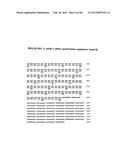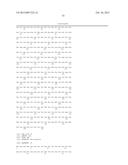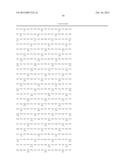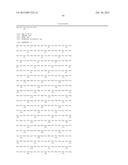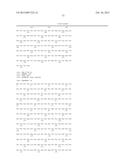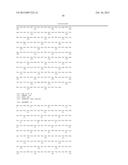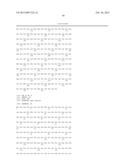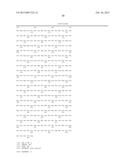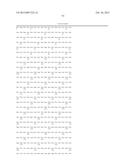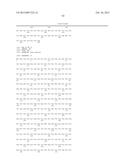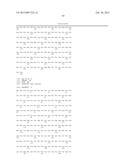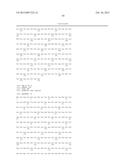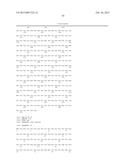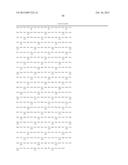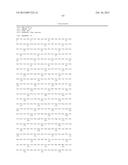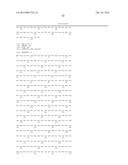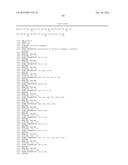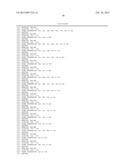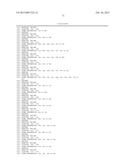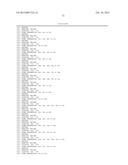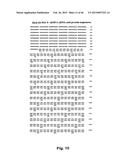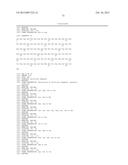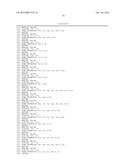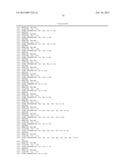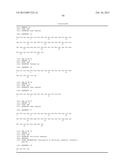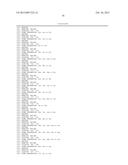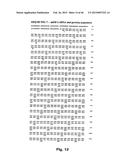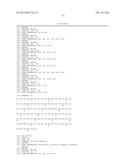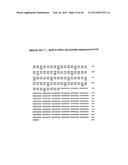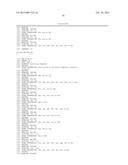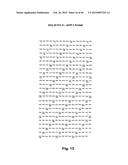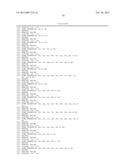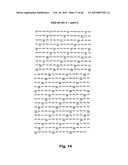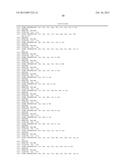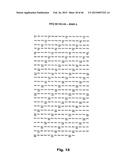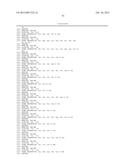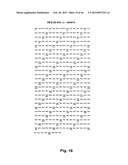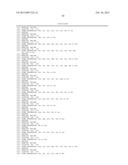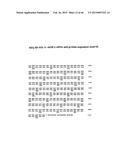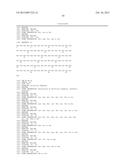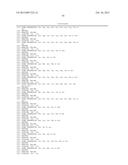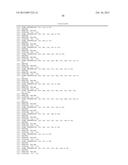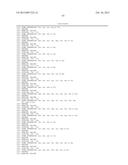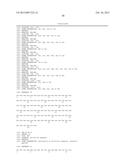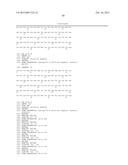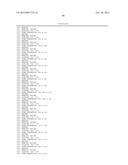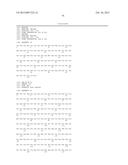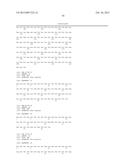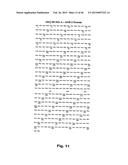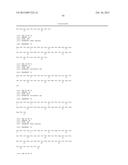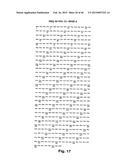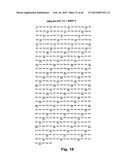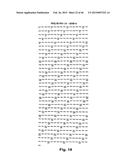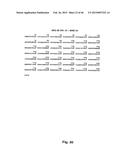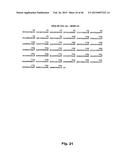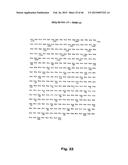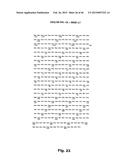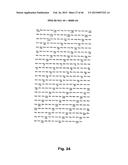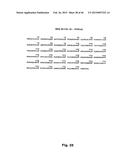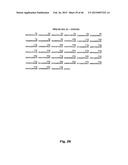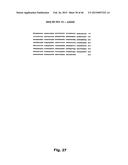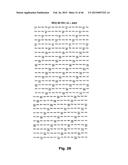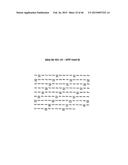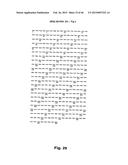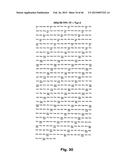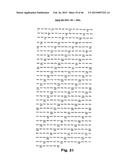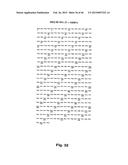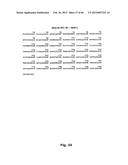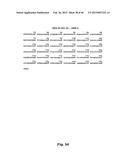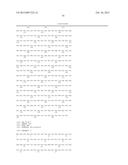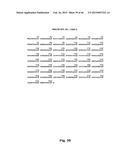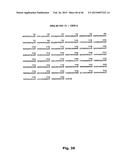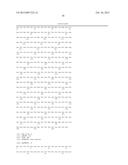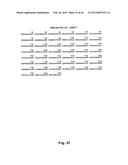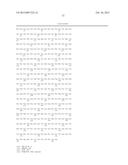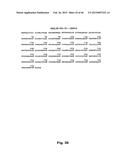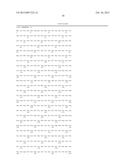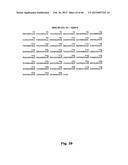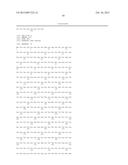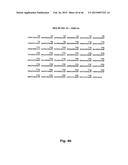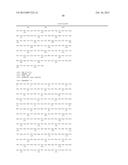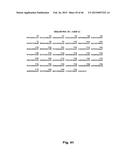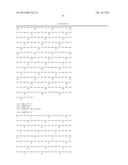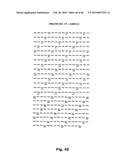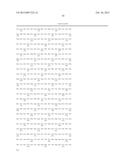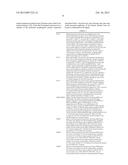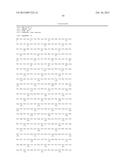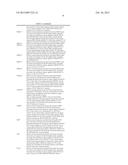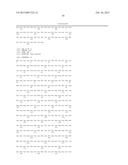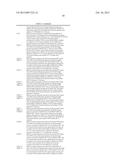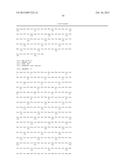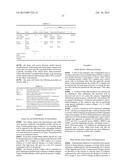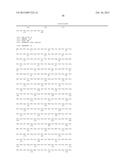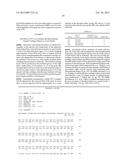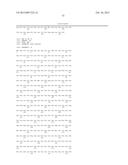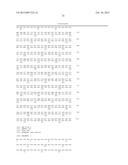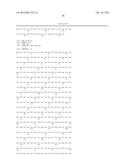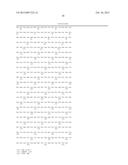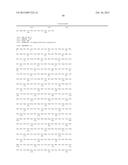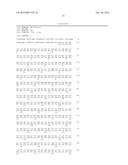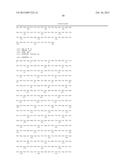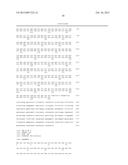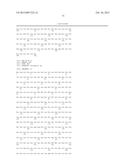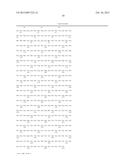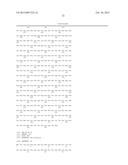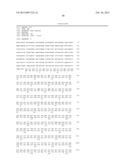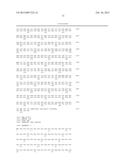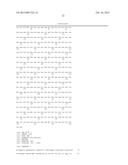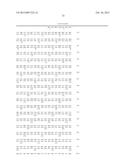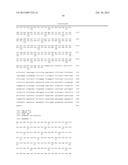Patent application title: METHODS OF TREATING CARTILAGE DEFECTS USING A SOLUBLE MORPHOGENIC PROTEIN COMPLEX
Inventors:
Donald Engelman (Guilford, CT, US)
IPC8 Class: AA61K3818FI
USPC Class:
514 88
Class name: Peptide (e.g., protein, etc.) containing doai growth factor or derivative affecting or utilizing bone morphogenic protein (bmp) or derivative
Publication date: 2015-02-26
Patent application number: 20150057222
Abstract:
The present invention provides methods of repairing and regenerating
cartilage tissue using a soluble morphogenic protein complex comprising
(a) a morphogenic protein; and (b) a morphogenic protein pro region
isolated from a morphogenic protein, or a conservative substitution
variant or a fragment of said pro region, wherein said pro region or
variant or fragment is noncovalently linked to the morphogenic protein,
and wherein said complex is more soluble in an aqueous solvent than said
morphogenic protein alone.Claims:
1. A method of repairing a cartilage defect in a patient comprising the
step of administering into the cartilage or into the area surrounding the
cartilage a composition comprising a therapeutically effective amount of
an isolated soluble morphogenic protein complex comprising: (a) a
morphogenic protein; and (b) a morphogenic protein pro region isolated
from a morphogenic protein, or a conservative substitution variant or a
fragment of said pro region, wherein said pro region or variant or
fragment is noncovalently linked to the morphogenic protein, and wherein
said complex is more soluble in an aqueous solvent than said morphogenic
protein alone.
2. The method of claim 1, wherein the cartilage is selected from articular and non-articular cartilage.
3. The method of claim 2, wherein the non-articular cartilage is selected from the group consisting of a meniscus and an intervertebral disc.
4. The method of claim 1, wherein the area surrounding the cartilage is synovial fluid.
5. The method of claim 1, wherein the morphogenic protein is a dimer.
6. The method of claim 1, wherein the morphogenic protein is selected from the group consisting of OP-1, OP-2, OP-3, BMP-2, BMP-3, BMP-4, BMP-5, BMP-6, BMP-8, BMP-9, BMP-10, BMP-11, BMP-12, BMP-13, BMP-15, BMP-16, BMP-17, BMP-18, DPP, Vg1, Vgr-1, 60A protein, GDF-1, GDF-2, GDF-3, GDF-5, GDF-6, GDF-7, GDF-8, GDF-9, GDF-10, GDF-11, GDF-12, CDMP-1, CDMP-2, CDMP-3, NODAL, UNIVIN, SCREW, ADMP, NEURAL, and conservative substitution variants and fragments thereof.
7. (canceled)
8. The method of claim 6, wherein the morphogenic protein is OP-1.
9. The method of claim 1, wherein the morphogenic protein comprises an amino acid sequence having at least 70% homology with the C-terminal 102-106 amino acids, including the conserved seven cysteine domain, of human OP-1, said morphogenic protein being capable of inducing repair of the cartilage defect.
10. The method of claim 1, wherein the morphogenic protein pro region comprises a pro region amino acid sequence selected from the group consisting of OP-1, OP-2, OP-3, BMP-2, BMP-3, BMP-4, BMP-5, BMP-6, BMP-8, BMP-9, BMP-10, BMP-11, BMP-12, BMP-13, BMP-15, BMP-16, BMP-17, BMP-18, DPP, Vg1, Vgr, 60A protein, GDF-1, GDF-2, GDF-3, GDF-5, GDF-6, GDF-7, GDF-8, GDF-9, GDF-10, GDF-11, GDF-12, CDMP-1, CDMP-2, CDMP-3, NODAL, UNIVIN, SCREW, ADMP, NEURAL, and conservative substitution variants and fragments thereof.
11. (canceled)
12. The method of claim 10, wherein the morphogenic protein pro region comprises a pro region amino acid sequence of OP-1 or a conservative substitution variant and fragment thereof.
13-36. (canceled)
37. A method of preventing cartilage degradation or treating cartilage injury or degenerative disease or disorder in a patient comprising the step of administering into the cartilage or into the area surrounding the cartilage a composition comprising a therapeutically effective amount of an isolated soluble morphogenic protein complex comprising: (a) a morphogenic protein; and (b) a morphogenic protein pro region isolated from a morphogenic protein, or a conservative substitution variant or a fragment of said pro region, wherein said pro region or variant or fragment is noncovalently linked to the morphogenic protein, and wherein said complex is more soluble in an aqueous solvent than said morphogenic protein alone.
38. The method of claim 37, wherein the cartilage is selected from articular and non-articular cartilage.
39. The method of claim 38, wherein the non-articular cartilage is selected from the group consisting of a meniscus and an intervertebral disc.
40. The method of claim 37, wherein the area surrounding the cartilage is synovial fluid.
41. The method of claim 37, wherein the morphogenic protein is a dimer.
42. The method of claim 37, wherein the morphogenic protein is selected from the group consisting of OP-1, OP-2, OP-3, BMP-2, BMP-3, BMP-4, BMP-5, BMP-6, BMP-8, BMP-9, BMP-10, BMP-11, BMP-12, BMP-13, BMP-15, BMP-16, BMP-17, BMP-18, DPP, Vg1, Vgr-1, 60A protein, GDF-1, GDF-2, GDF-3, GDF-5, GDF-6, GDF-7, GDF-8, GDF-9, GDF-10, GDF-11, GDF-12, CDMP-1, CDMP-2, CDMP-3, NODAL, UNIVIN, SCREW, ADMP, NEURAL, and conservative substitution variants and fragments thereof.
43. (canceled)
44. The method of claim 42, wherein the morphogenic protein is OP-1.
45. The method of claim 37, wherein the morphogenic protein comprises an amino acid sequence having at least 70% homology with the C-terminal 102-106 amino acids, including the conserved seven cysteine domain, of human OP-1, said morphogenic protein being capable of inducing repair of the cartilage defect.
46. The method of claim 37, wherein the morphogenic protein pro region comprises a pro region amino acid sequence selected from the group consisting of OP-1, OP-2, OP-3, BMP-2, BMP-3, BMP-4, BMP-5, BMP-6, BMP-8, BMP-9, BMP-10, BMP-11, BMP-12, BMP-13, BMP-15, BMP-16, BMP-17, BMP-18, DPP, Vg1, Vgr, 60A protein, GDF-1, GDF-2, GDF-3, GDF-5, GDF-6, GDF-7, GDF-8, GDF-9, GDF-10, GDF-11, GDF-12, CDMP-1, CDMP-2, CDMP-3, NODAL, UNIVIN, SCREW, ADMP, NEURAL, and conservative substitution variants and fragments thereof.
47. (canceled)
48. The method of claim 46, wherein the morphogenic protein pro region comprises a pro region amino acid sequence of OP-1 or a conservative substitution variant and fragment thereof.
49-61. (canceled)
Description:
FIELD OF THE INVENTION
[0001] The present invention relates to orthopaedic tissue repair. More particularly, it relates to methods of repairing or regenerating cartilage.
BACKGROUND OF THE INVENTION
[0002] Cartilage repair and regeneration is one of the major obstacles in current orthopaedics. The importance is enormous because cartilage injury and degenerative disorders such as osteoarthritis, intervertebral disc degeneration and meniscal tears are a major cause of disability among the adult population in the United States.
[0003] Cartilage is connective tissue composed of chondrocytes embedded in an extracellular matrix of collagen fibers, proteoglycans, and other non-collagenous proteins. There are two forms of cartilage--articular and non-articular. Articular cartilage is a thin layer of connective tissue, which covers the ends of bones in joints. Non-articular cartilage includes fibrocartilage and elastic cartilage and includes intervertebral discs, meniscus, trachea, larynx, nose, ear and ribs.
[0004] The function of cartilage is to cushion load bearing, resist wear, and allow for almost frictionless movement of joints. Defects in cartilage tissue, often caused by trauma, abnormal wear or disease, can lead to pain and stiffness, and if left untreated, may progress and ultimately require replacement of the entire joint. For example, articular cartilage defects often lead to early degradation of the articular surface and may eventually result in osteochondral defects, osteoarthritis or both.
[0005] Osteoarthritis is considered a process of attempted, but gradually failing, repair of damaged cartilage extracellular matrix, as the balance between synthesis and breakdown of matrix components is disturbed and shifted toward catabolism.
[0006] The ability of cartilage tissue to regenerate on its own is severely limited due to its avascular nature. Repair of osteochondral defects, which involves both the cartilage tissue and the underlying bone, occurs to a limited extent promoted by the presence of both stem cells and growth and differentiation factors brought into the defect by the blood and/or marrow. In animal studies, these defects undergo some repair with formation of a new layer of bone and cartilage, but the macromolecular organization and the biochemical characteristics of the cartilage matrix are imperfect. Type I collagen, rather than Type II collagen, and proteoglycans that are not cartilage specific, such as dermatan sulfate containing proteoglycans, make up the repair tissue and result in fibrillations and degenerative changes over time. And, repair of cartilage defects that do not penetrate into the subchondral bone does not occur, even to a limited extent.
[0007] Moreover, surgical treatment of cartilage defects is complex and has been demonstrated to have only limited success. For example, articular cartilage defects are treated with an arthroscopic approach where loose bodies are debrided and transition areas are smoothed. However, this method alone frequently does not provide long lasting relief of the symptoms. Knee replacements often require resecting significant amounts of bone and often require multiple surgeries.
[0008] The meniscus is a small horseshoe shaped tissue located between the bone ends inside the knee joint, which acts as a shock absorber. There are two menisci in each knee on either side of the knee. They are usually strong in young people and with age become more brittle and tear more easily. Tears are extremely common with anterior cruciate ligament (ACL) injuries. Meniscal fibrocartilage, like articular hyaline cartilage, has a limited capacity to heal, particularly in the middle and inner avascular regions. The current treatment for small tears is to leave them alone if they do not cause much trouble. Surgical options for treating meniscal tears depend on a number of factors including the nature and extent of the injury and most importantly, its location. Tears in the vascularized region, which is integrated with the highly vascularized synovium have been successfully repaired by suturing. Partial or total meniscectomy is the normal surgical treatment for symptomatic tears within the avascular two thirds of the meniscus. Tears in the latter meniscus regions are the most common types seen clinically. Irrespective of whether open, arthroscopic, total or partial meniscectomy are employed, osteoarthritis is a frequent sequela in these patients within a few years post surgery. Therefore, the common form of repair is to only partially remove the torn bits and to repair the cartilage by stapling it. Unfortunately, the healing process following this procedure is slow. Moreover, if the repair is not successful, then the entire torn meniscus must subsequently be removed.
[0009] The major cause of persistent and often debilitating back pain is intervertebral disc (IVD) degeneration. As discs degenerate, they cause the adjoining vertebrae to become compressed, often resulting in severe pain.
[0010] The IVD as a syndesmosis provides articulation between adjoining vertebral bodies and acts as a weight bearing cushion which dissipates axially applied spinal loads. These biomechanical functions are made possible by the unique structure of the IVD which is composed of an outer collagen-rich annulus fibrosus surrounding a central hydrated proteoglycan rich gelatinous nucleus pulposus. Superior and inferior cartilaginous endplates, thin layers of hyaline-like cartilage covers the interfaces of the vertebral bodies within the disc.
[0011] Lumbar disc degeneration represents a substantial social and economic burden to the community which is manifest principally as low back pain (LBP). It is estimated that as much as 80% of the population experience at least one significant episode of LBP during life, and approximately 2.5% of the working population will take some sick leave during the year as a result of LBP. The direct costs of LBP in modern Western countries has been estimated at $9 billion, most of which is spent on consulting general practitioners, physical therapists and other conservative practitioners (Williams D A et al., (1998) Health care and indemnity costs across the natural history of disability in occupational low back pain, Spine 23:2329-36). Total indirect expenditure, including surgical management may be ten times higher (Maetzel and L1 (2002) The economic burden of low back pain: a review of studies published between 1996 and 2001, Best Prac Res Clin Rheumatol 16:23-30; Walker et al., (2003) The economic burden, Proceedings of the Spine Society of Australia Annual Scientific Meeting, Canberra, Australia).
[0012] Disc degeneration is a natural phenomenon that occurs, in most instances, from the time of skeletal maturity (Vernon-Roberts (1992) Age-related and degenerative pathology of intervertebral discs and apophyseal joints, In: The lumbar spine and back pain. Fourth edition, Jayson M I V, Ed. Churchill Livingstone, Edinburgh, Chapter 2, 17-41). It is consistent with advancing age but in many cases is also associated with pain, particularly in the lumbar spine, and restricted mobility. Symptoms of LBP often resolve spontaneously over time as patients modify their lifestyles to accommodate restricted mobility. In many cases however, it remains a significant factor that requires surgical intervention. The traditional "gold standard" surgical treatment for chronic LBP has been spinal fusion to immobilize the one or more painful level. Fusion is expensive because it requires prolonged hospitalization and specialist surgical expertise, and although most of these patients will experience short-term pain relief there is evidence now that fusion does not provide the best outcome. Long-term studies suggest that spinal fusion actually promotes degeneration at levels adjacent to the fusion site (Lee (1988) Accelerated degeneration of the segment adjacent to a lumbar fusion, Spine 13:375-7). In the same way that artificial prostheses were developed 50 years ago to restore function to arthritic and fractured hips and knees, prostheses are now being developed with the aim of restoring full mechanical function to discs that have become painful and arthritic due to chronic degeneration (Szpaal ski et al (2002) V Spine arthroplasty: a historical review, Eur Spine J 11:565-S84). It is however too early to know if any of the myriad models undergoing trials will provide long-term benefit.
[0013] A class of proteins known as "osteogenic proteins" or "morphogenic proteins" or "morphogens," are competent to act as true bone and cartilage tissue morphogens, able, on their own, to induce the proliferation and differentiation of progenitor cells into functional bone, cartilage, tendon, and/or ligamentous tissue. These proteins, include members of the family of bone morphogenetic proteins (BMPs) which were initially identified by their ability to induce ectopic, endochondral bone morphogenesis. The osteogenic proteins generally are classified in the art as a subgroup of the TGF-β superfamily of growth factors (Hogan (1996) Genes & Development 10:1580-1594). Members of the morphogen family of proteins include the mammalian osteogenic protein-1 (OP-1, also known as BMP-7, and the Drosophila homolog 60A), osteogenic protein-2 (OP-2, also known as BMP-8a), osteogenic protein-3 (OP-3, also known as BMP-8b), BMP-2 (also known as BMP-2A or CBMP-2A, and the Drosophila homolog DPP), BMP-3, BMP-4 (also known as BMP-2B or CBMP-2B), BMP-5, BMP-6 and its murine homolog Vgr-1, BMP-9, BMP-10, BMP-11, BMP-12, GDF3 (also known as Vgr2), GDF8, GDF9, GDF10, GDF11, GDF12, BMP-13, BMP-14, BMP-15, BMP-16, BMP-17, BMP-18, GDF-5 (also known as CDMP-1 or MP52), GDF-6 (also known as CDMP-2), GDF-7 (also known as CDMP-3), the Xenopus homolog Vg1, NODAL, UNIVIN, SCREW, ADMP, and NEURAL. Members of this family encode secreted polypeptide chains sharing common structural features, including processing from a precursor "pro-form" to yield a mature polypeptide chain competent to dimerize, and containing a carboxy terminal active domain of approximately 97-106 amino acids. All members share a conserved pattern of cysteines in this domain and the active form of these proteins can be either a disulfide-bonded homodimer of a single family member, or a heterodimer of two different members (see, e.g., Massague (1990) Annu. Rev. Cell Biol. 6:597; Sampath, et al. (1990) J. Biol. Chem. 265:13198). See also, U.S. Pat. No. 5,011,691; U.S. Pat. No. 5,266,683, Ozkaynak et al. (1990) EMBO J. 9: 2085-2093, Wharton et al. (1991) PNAS 88:9214-9218, Ozkaynak (1992) J. Biol. Chem. 267:25220-25227 and U.S. Pat. No. 5,266,683; Celeste et al. (1991) PNAS 87:9843-9847; Lyons et al. (1989) PNAS 86:4554-4558; Wozney et al. (1988) Science 242:1528-1534; WO93/00432; Padgett et al. (1987) Nature 325:81-84; Weeks (1987) Cell 51:861-867.
[0014] In their mature dimeric forms, the morphogenic proteins typically are fairly insoluble under physiological conditions. It has been discovered that morphogenic proteins secreted into cultured medium from mammalian cell expression systems contain as a significant fraction of the secreted protein a soluble form of the protein. This soluble form, also referred to as "soluble morphogenic protein complex" comprises the mature dimeric species, including truncated forms thereof, noncovalently associated with at least one, and preferably two pro domains. See e.g., U.S. Pat. No. 6,395,883.
[0015] The currently preferred methods of repairing cartilage defects include debridement, microfracture, autologous cell transplantation, mosaicplasty and joint replacement. However, none of these methods, result in actual repair and replacement of cartilage tissue. These methods result in imperfect repair tissue with scar-like characteristics.
[0016] Therefore, there remains a need for compositions and methods for repairing and regenerating cartilage defects which overcome the problems associated with the currently available methods and compositions.
SUMMARY OF THE INVENTION
[0017] The present invention provides methods of repairing and regenerating cartilage tissue using a soluble morphogenic protein complex. In some embodiments, the present invention provides a method of repairing a cartilage defect in a patient comprising the step of administering into the cartilage or into the area surrounding the cartilage a composition comprising a therapeutically effective amount of an isolated soluble morphogenic protein complex comprising: (a) a morphogenic protein; and (b) a morphogenic protein pro region isolated from a morphogenic protein, or a conservative substitution variant or a fragment of said pro region, wherein said pro region or variant or fragment is noncovalently linked to the morphogenic protein, and wherein said complex is more soluble in an aqueous solvent than said morphogenic protein alone.
[0018] In some embodiments, the invention provides a method of regenerating or producing cartilage in a patient comprising the step of administering into the cartilage or the area surrounding the cartilage a composition comprising a therapeutically effective amount of an isolated soluble morphogenic protein complex comprising: (a) a morphogenic protein; and (b) a morphogenic protein pro region isolated from a morphogenic protein, or a conservative substitution variant or a fragment of said pro region, wherein said pro region or variant or fragment is noncovalently linked to the morphogenic protein, and wherein said complex is more soluble in an aqueous solvent than said morphogenic protein alone.
[0019] In other embodiments, the invention provides a method of promoting cartilage growth or accelerating cartilage formation in a patient comprising the step of administering into the cartilage or into the area surrounding the cartilage a composition comprising a therapeutically effective amount of an isolated soluble morphogenic protein complex comprising: (a) a morphogenic protein; and (b) a morphogenic protein pro region isolated from a morphogenic protein, or a conservative substitution variant or a fragment of said pro region, wherein said pro region or variant or fragment is noncovalently linked to the morphogenic protein, and wherein said complex is more soluble in an aqueous solvent than said morphogenic protein alone.
[0020] In yet other embodiments, the invention provides a method of preventing cartilage degradation or treating cartilage injury or degenerative disease or disorder in a patient comprising the step of administering into the cartilage or into the area surrounding the cartilage a composition comprising a therapeutically effective amount of an isolated soluble morphogenic protein complex comprising: (a) a morphogenic protein; and (b) a morphogenic protein pro region isolated from a morphogenic protein, or a conservative substitution variant or a fragment of said pro region, wherein said pro region or variant or fragment is noncovalently linked to the morphogenic protein, and wherein said complex is more soluble in an aqueous solvent than said morphogenic protein alone.
[0021] The present invention also provides a method of treating cartilage tissue injury in a patient comprising the step of administering to the patient a composition comprising a therapeutically effective amount of an isolated soluble morphogenic protein complex comprising: (a) a morphogenic protein; and (b) a morphogenic protein pro region isolated from a morphogenic protein, or a conservative substitution variant or a fragment of said pro region, wherein said pro region or variant or fragment is noncovalently linked to the morphogenic protein, and wherein said complex is more soluble in an aqueous solvent than said morphogenic protein alone. In some embodiments the tissue injury includes but is not limited to meniscus tears, chondral voids or defects, osteochondral voids or defects or ACL injury.
[0022] The present invention also provides a method of treating cartilage tissue degenerative disease or disorder in a patient comprising the step of administering to the patient a composition comprising a therapeutically effective amount of an isolated soluble morphogenic protein complex comprising: (a) a morphogenic protein; and (b) a morphogenic protein pro region isolated from a morphogenic protein, or a conservative substitution variant or a fragment of said pro region, wherein said pro region or variant or fragment is noncovalently linked to the morphogenic protein, and wherein said complex is more soluble in an aqueous solvent than said morphogenic protein alone. In some embodiments, the cartilage tissue degenerative disease or disorder includes but is not limited to osteoarthritis and disc degeneration. In some embodiments, the composition of this invention is administered into the osteoarthritic or disc degeneration defect site or into the area surrounding the osteoarthritic or disc degeneration defect site.
[0023] In some embodiments, the cartilage is articular cartilage. In some embodiments, the articular cartilage is within an articular joint. In other embodiments, the cartilage is non-articular cartilage. In some embodiments, the non-articular cartilage is a meniscus or an intervertebral disc.
[0024] In some embodiments, the composition is administered into the cartilage. In some embodiments, the composition is administered into a meniscus or an intervertebral disc. In some embodiments, the composition is administered into the areas surrounding the cartilage. In some embodiments, the area surrounding the cartilage is synovial fluid.
[0025] In some embodiments, the morphogenic protein in the composition used in the methods of this invention includes but is not limited to OP-1, OP-2, OP-3, BMP-2, BMP-3, BMP-4, BMP-5, BMP-6, BMP-8, BMP-9, BMP-10, BMP-11, BMP-12, BMP-13, BMP-15, BMP-16, BMP-17, BMP-18, DPP, Vg1, Vgr, 60A protein, GDF-1, GDF-2, GDF-3, GDF-5, GDF-6, GDF-7, GDF-8, GDF-9, GDF-10, GDF-11, GDF-12, CDMP-1, CDMP-2, CDMP-3, NODAL, UNIVIN, SCREW, ADMP, NEURAL, and conservative substitution variants and fragments thereof. In a preferred embodiment, the morphogenic protein is selected from OP-1, BMP-5, BMP-6, GDF-5, GDF-6, GDF-7, CDMP-1, CDMP-2, CDMP-3, BMP-12, and BMP-13. In a more preferred embodiment, the morphogenic protein is OP-1. In other embodiments, the morphogenic protein comprises an amino acid sequence having at least 70% homology with the C-terminal 102-106 amino acids, including the conserved seven cysteine domain, of human OP-1, said morphogenic protein being capable of inducing repair of the cartilage defect. In some embodiments, the morphogenic protein in the composition used in the methods of this invention is a dimer. In some embodiments, the morphogenic protein in the composition of this invention is a non-covalent dimer, including, for example, monomers in which the cysteine residue responsible for interchain disulfide bond formation has been replaced with another amino acid residue.
[0026] In some embodiments, the morphogenic protein pro region comprises a pro region amino acid sequence of OP-1, OP-2, OP-3, BMP-2, BMP-3, BMP-4, BMP-5, BMP-6, BMP-8, BMP-9, BMP-10, BMP-11, BMP-12, BMP-13, BMP-15, BMP-16, BMP-17, BMP-18, DPP, Vg1, Vgr, 60A protein, GDF-1, GDF-2, GDF-3, GDF-5, GDF-6, GDF-7, GDF-8, GDF-9, GDF-10, GDF-11, GDF-12, CDMP-1, CDMP-2, CDMP-3, NODAL, UNIVIN, SCREW, ADMP, NEURAL, or conservative substitution variants or fragments thereof. In other embodiments, the morphogenic protein pro region comprises a pro region amino acid sequence of OP-1, BMP-5, BMP-6, GDF-5, GDF-6, GDF-7, CDMP-1, CDMP-2, CDMP-3, BMP-12, BMP-13, or conservative substitution variants or fragments thereof. In yet another preferred embodiment the morphogenic protein pro region comprises a pro region amino acid sequence of OP-1 or a conservative substitution variant or fragment thereof.
BRIEF DESCRIPTION OF THE DRAWINGS
[0027] FIG. 1 is a schematic representation of a morphogen polypeptide chain as expressed from a nucleic acid encoding the sequence, wherein the cross-hatched region represents the signal sequence; the stippled region represents the pro domain; the hatched region represents the N-terminus ("N-terminal extension") of the mature protein sequence; and the open region represents the C-terminal region of the mature protein sequence defining the conserved seven cysteine domain, the conserved cysteines being indicated by vertical hatched lines.
[0028] FIG. 2 lists the sequences of the N-terminal extensions of the mature forms of various morphogens OP-2, OP-1, Vgr-1, BMP-5, 60A, DPP, BMP-2, BMP-4, Vg-1, BMP-3, respectively.
[0029] FIG. 3 is a gel filtration column elution profile of a soluble morphogen (OP-1) produced and purified from a mammalian cell culture by IMAC, S-Sepharose and S-200HR chromatography in TBS (Tris-buffered saline), wherein Vo is the void volume, ADH is alcohol dehydrogenase (MW 150 kDa), BSA is bovine serum albumin (MW 67 kDa), CA is carbonic anhydrase (MW 29 kDa) and CytC is cytochrome C (MW 12.5 kDa).
[0030] FIG. 4 is a schematic of a joint showing the site of the bilateral impact injuries.
[0031] FIG. 5 depicts the zonal dissection scheme to separate the disc into annulus fibrosus (AF) quadrants and the nucleus pulposus (NP) and the location and extent of the anterolateral annular lesion in quadrant 1 in horizontal and vertical sections through lumbar ovine intervertebral discs.
[0032] FIG. 6 depicts human OP-1 cDNA and protein sequences (SEQ ID NO:1).
[0033] FIG. 7 depicts a human OP-1 protein sequence (SEQ ID NO:2).
[0034] FIG. 8 depicts murine OP-1 cDNA and protein sequences (SEQ ID NO:3).
[0035] FIG. 9 depicts a murine protein sequence (SEQ ID NO:4).
[0036] FIG. 10 depicts human OP-2 cDNA and protein sequences (SEQ ID NO:5).
[0037] FIG. 11 depicts a human OP-2 protein sequences (SEQ ID NO:6).
[0038] FIG. 12 depicts murine OP-2 cDNA and protein sequences (SEQ ID NO:7).
[0039] FIG. 13 depicts a murine OP-2 protein sequence (SEQ ID NO:8).
[0040] FIG. 14 depicts a murine OP-3 protein sequence (SEQ ID NO:9).
[0041] FIG. 15 depicts a BMP-2 protein sequence (SEQ ID NO:10).
[0042] FIG. 16 depicts a BMP-4 protein sequence (SEQ ID NO:11).
[0043] FIG. 17 depicts a BMP-3 protein sequence (SEQ ID NO:12).
[0044] FIG. 18 depicts a BMP-5 protein sequence (SEQ ID NO:13).
[0045] FIG. 19 depicts a BMP-6 protein sequence (SEQ ID NO:14).
[0046] FIG. 20 depicts a BMP-10 protein sequence (SEQ ID NO:15).
[0047] FIG. 21 depicts a BMP-15 protein sequence (SEQ ID NO:16).
[0048] FIG. 22 depicts a BMP-16 protein sequence (SEQ ID NO:17).
[0049] FIG. 23 depicts a BMP-17 protein sequence (SEQ ID NO:18).
[0050] FIG. 24 depicts a BMP-18 protein sequence (SEQ ID NO:19).
[0051] FIG. 25 depicts a NODAL protein sequence (SEQ ID NO:20).
[0052] FIG. 26 depicts a UNIVIN protein sequence (SEQ ID NO:21).
[0053] FIG. 27 depicts a ADMP protein sequence (SEQ ID NO:22).
[0054] FIG. 28 depicts a DPP protein sequence (SEQ ID NO:23).
[0055] FIG. 29 depicts a VG-1 protein sequence (SEQ ID NO:24).
[0056] FIG. 30 depicts a Vgr-1 protein sequence (SEQ ID NO:25).
[0057] FIG. 31 depicts a 60A protein sequence (SEQ ID NO:26).
[0058] FIG. 32 depicts a GDF-1 protein sequence (SEQ ID NO:27).
[0059] FIG. 33 depicts a GDF-2 protein sequence (SEQ ID NO:28).
[0060] FIG. 34 depicts a GDF-3 protein sequence (SEQ ID NO:29).
[0061] FIG. 35 depicts a GDF-5 protein sequence (SEQ ID NO:30).
[0062] FIG. 36 depicts a GDF-6 protein sequence (SEQ ID NO:31).
[0063] FIG. 37 depicts a GDF-7 protein sequence (SEQ ID NO:32).
[0064] FIG. 38 depicts a GDF-8 protein sequence (SEQ ID NO:33).
[0065] FIG. 39 depicts a GDF-9 protein sequence (SEQ ID NO:34).
[0066] FIG. 40 depicts a GDF-10 protein sequence (SEQ ID NO:35).
[0067] FIG. 41 depicts a GDF-11 protein sequence (SEQ ID NO:36).
[0068] FIG. 42 depicts a GDF-12 protein sequence (SEQ ID NO:37).
DETAILED DESCRIPTION OF THE INVENTION
[0069] In order that the invention herein described may be fully understood, the following detailed description is set forth.
[0070] Unless defined otherwise, all technical and scientific terms used herein have the same meaning as those commonly understood by one of ordinary skill in the art to which this invention belongs. Although methods and materials similar or equivalent to those described herein can be used in the practice or testing of the present invention, suitable methods and materials are described below. The materials, methods and examples are illustrative only, and are not intended to be limiting. All publications, patents and other documents mentioned herein are incorporated by reference in their entirety.
[0071] Throughout this specification, the word "comprise" or variations such as "comprises" or "comprising" will be understood to imply the inclusion of a stated integer or groups of integers but not the exclusion of any other integer or group of integers.
[0072] In order to further define the invention, the following terms and definitions are provided herein.
[0073] The term "cartilage" refers to a type of connective tissue that contains chondrocytes or chondrocyte-like cells (having many, but not all characteristics of chondrocytes) and intercellular material (e.g., Types I, II, IX and XI collagen), proteoglycans (e.g., chondroitin sulfate, keratan sulfate, and dermatan sulfate proteoglycans) and other proteins. Cartilage includes articular and non-articular cartilage.
[0074] "Articular cartilage," also referred to as hyaline cartilage, refers to an avascular, non-mineralized connective tissue, which covers the articulating surfaces of bones in joints and serves as a friction reducing interface between two opposing bone surfaces. Articular cartilage allows movement in joints without direct bone-to-bone contact. Articular cartilage has no tendency to ossification. The cartilage surface appears smooth and pearly macroscopically, and is finely granular under high power magnification. Articular cartilage derives nutrients partly from the vessels of the neighboring synovial membrane and partly from the vessels of the bone it covers. Articular cartilage is associated with the presence of Type II and Type IX collagen and various well-characterized proteoglycans, and with the absence of Type X collagen, which is associated with endochondral bone formation. For a detailed description of articular cartilage microstructure, see, for example, Aydelotte and Kuettner, Conn. Tiss. Res., 18, p. 205 (1988); Zanetti et al., J. Cell Biol., 101, p. 53 (1985); and Poole et al., J. Anat., 138, p. 13 (1984).
[0075] "Non-articular cartilage" refers to cartilage that does not cover articulating surfaces and includes fibrocartilage (including interarticular fibrocartilage, fibrocartilaginous disc, connecting fibrocartilage and circumferential fibrocartilage) and elastic cartilage. In fibrocartilage, the micropolysaccharide network is interlaced with prominent collagen bundles, and the chondrocytes are more widely scattered than in hyaline or articular cartilage. Interarticular fibrocartilage is found in joints which are exposed to concussion and subject to frequent movement, e.g., the meniscus of the knee. Examples of such joints include but are not limited to the temporo-mandibular, sterno-clavicular, acromio-clavicular, wrist and knee joints. Secondary cartilaginous joints are formed by discs of fibrocartilage. Such fibrocartilaginous discs, which adhere closely to both of the opposed surfaces, are composed of concentric rings of fibrous tissue, with cartilaginous laminae interposed. An example of such fibrocartilaginous disc is the intervertebral disc of the spine. Connecting fibrocartilage is interposed between the bony surfaces of those joints, which allow for slight mobility as between the bodies of the vertebrae and between the pubic bones. Circumferential fibrocartilage surrounds the margin of some of the articular cavities, such as the cotyloid cavity of the hip and the glenoid cavity of the shoulder.
[0076] Elastic cartilage contains fibers of collagen that are histologically similar to elastin fibers. Such cartilage is found in the auricle of the external ear, the eustachian tubes, the cornicula laryngis and the epiglottis. As with all cartilage, elastic cartilage also contains chondrocytes and a matrix, the latter being pervaded in every direction, by a network of yellow elastic fibers, branching and anastomosing in all directions except immediately around each cell, where there is a variable amount of non-fibrillated, hyaline, intercellular substance.
[0077] The term "synovial fluid" refers to a thin, lubricating substance within the synovial cavity that reduces friction within the joint.
[0078] The term "defect" or "defect site", refers to a disruption of chondral or osteochondral tissue. A defect can assume the configuration of a "void", which is understood to mean a three-dimensional defect such as, for example, a gap, cavity, hole or other substantial disruption in the structural integrity of chondral or osteochondral tissue. A defect can also be a detachment of the cartilage from its point of attachment to the bone or ligaments. In certain embodiments, the defect is such that it is incapable of endogenous or spontaneous repair. A defect can be the result of accident, disease, and/or surgical manipulation. For example, cartilage defects may be the result of trauma to a joint such as a displacement of torn meniscus tissue into the joint. Cartilage defects may be also be the result of degenerative joint diseases such as osteoarthritis.
[0079] The term "repair" refers to new cartilage formation which is sufficient to at least partially fill the void or structural discontinuity at the defect site. Repair does not, however, mean, or otherwise necessitate, a process of complete healing or a treatment, which is 100% effective at restoring a defect to its pre-defect physiological/structural/mechanical state.
[0080] The term "therapeutically effective amount" refers to an amount effective to repair, regenerate, promote, accelerate, prevent degradation, or form cartilage tissue.
[0081] The term "patient" refers to an animal including a mammal (e.g., a human).
[0082] The term "pharmaceutically acceptable carrier of adjuvant" refers to a non-toxic carrier or adjuvant that may be administered to a patient, together with a soluble morphogenic protein complex of this invention, and which does not destroy the pharmacological activity thereof.
[0083] The term "morphogenic protein" refers to a protein having morphogenic activity. Preferably a morphogenic protein of this invention comprises at least one polypeptide belonging to the BMP protein family. Morphogenic proteins include osteogenic proteins. Morphogenic proteins may be capable of inducing progenitor cells to proliferate and/or to initiate differentiation pathways that lead to cartilage, bone, tendon, ligament or other types of tissue formation depending on local environmental cues, and thus morphogenic proteins may behave differently in different surroundings. For example, a morphogenic protein may induce bone tissue at one treatment site and cartilage tissue at a different treatment site.
[0084] The term "bone morphogenic protein (BMP)" refers to a protein belonging to the BMP family of the TGF-β superfamily of proteins (BMP family) based on DNA and amino acid sequence homology. A protein belongs to the BMP family according to this invention when it has at least 50% amino acid sequence identity with at least one known BMP family member within the conserved C-terminal cysteine-rich domain, which characterizes the BMP protein family. Preferably, the protein has at least 70% amino acid sequence identity with at least one known BMP family member within the conserved C-terminal cysteine rich domain. Members of the BMP family may have less than 50% DNA or amino acid sequence identity overall. Osteogenic protein as defined herein also is competent to induce articular cartilage formation at an appropriate in vivo avascular locus.
[0085] The term "amino acid sequence homology" is understood to include both amino acid sequence identity and similarity. Homologous sequences share identical and/or similar amino acid residues, where similar residues are conservative substitutions for, or "allowed point mutations" of, corresponding amino acid residues in an aligned reference sequence. Thus, a candidate polypeptide sequence that shares 70% amino acid homology with a reference sequence is one in which any 70% of the aligned residues are either identical to, or are conservative substitutions of, the corresponding residues in a reference sequence. Certain particularly preferred morphogenic polypeptides share at least 60%, and preferably 70% amino acid sequence identity with the C-terminal 102-106 amino acids, defining the conserved seven-cysteine domain of human OP-1 and related proteins.
[0086] Amino acid sequence homology can be determined by methods well known in the art. For instance, to determine the percent homology of a candidate amino acid sequence to the sequence of the seven-cysteine domain, the two sequences are first aligned. The alignment can be made with, e.g., the dynamic programming algorithm described in Needleman et al., J. Mol. Biol., 48, pp. 443 (1970), and the Align Program, a commercial software package produced by DNAstar, Inc. The teachings by both sources are incorporated by reference herein. An initial alignment can be refined by comparison to a multi-sequence alignment of a family of related proteins. Once the alignment is made and refined, a percent homology score is calculated. The aligned amino acid residues of the two sequences are compared sequentially for their similarity to each other. Similarity factors include similar size, shape and electrical charge. One particularly preferred method of determining amino acid similarities is the PAM250 matrix described in Dayhoff et al., Atlas of Protein Sequence and Structure, 5, pp. 345-352 (1978 & Supp.), which is incorporated herein by reference. A similarity score is first calculated as the sum of the aligned pair wise amino acid similarity scores. Insertions and deletions are ignored for the purposes of percent homology and identity. Accordingly, gap penalties are not used in this calculation. The raw score is then normalized by dividing it by the geometric mean of the scores of the candidate sequence and the seven-cysteine domain. The geometric mean is the square root of the product of these scores. The normalized raw score is the percent homology.
[0087] The term "conservative substitutions" refers to residues that are physically or functionally similar to the corresponding reference residues. That is, a conservative substitution and its reference residue have similar size, shape, electric charge, chemical properties including the ability to form covalent or hydrogen bonds, or the like. Preferred conservative substitutions are those fulfilling the criteria defined for an accepted point mutation in Dayhoff et al., supra. Examples of conservative substitutions are substitutions within the following groups: (a) valine, glycine; (b) glycine, alanine; (c) valine, isoleucine, leucine; (d) aspartic acid, glutamic acid; (e) asparagine, glutamine; (f) serine, threonine; (g) lysine, arginine, methionine; and (h) phenylalanine, tyrosine. The term "conservative variant" or "conservative variation" also includes the use of a substituting amino acid residue in place of an amino acid residue in a given parent amino acid sequence, where antibodies specific for the parent sequence are also specific for, i.e., "cross-react" or "immuno-react" with, the resulting substituted polypeptide sequence.
[0088] The term "osteogenic protein (OP)" refers to a morphogenic protein that is capable of inducing a progenitor cell to form cartilage and/or bone. The bone may be intramembraneous bone or endochondral bone. Most osteogenic proteins are members of the BMP protein family and are thus also BMPs. As described elsewhere herein, the class of proteins is typified by human osteogenic protein (hOP-1). Other osteogenic proteins useful in the practice of the invention include osteogenically active forms of OP-1, OP-2, OP-3, BMP-2, BMP-3, BMP-4, BMP-5, BMP-6, BMP-8, BMP-9, BMP-10, BMP-11, BMP-12, BMP-13, BMP-15, BMP-16, BMP-17, BMP-18, DPP, Vg1, Vgr-1, 60A protein, GDF-1, GDF-2, GDF-3, GDF-5, GDF-6, GDF-7, GDF-8, GDF-9, GDF-10, GDF-11, GDF-12, CDMP-1, CDMP-2, CDMP-3, UNIVIN, NODAL, SCREW, ADMP or NEURAL, or conservative substitution variants or fragments thereof. Osteogenic proteins suitable for use with applicants' invention can be identified by means of routine experimentation using the art-recognized bioassay described by Reddi and Sampath (Sampath et al., Proc. Natl. Acad. Sci., 84, pp. 7109-13, incorporated herein by reference).
Methods and Compositions for Cartilage Growth and Repair
[0089] The morphogenic compositions of this invention may be used for cartilage repair (e.g., at a joint, meniscus or intervertebral disc). The morphogenic compositions comprising a soluble morphogenic protein complex disclosed herein will permit the physician to treat a variety of tissue injuries, tissue degenerative or disease conditions and disorders that can be ameliorated or remedied by localized, stimulated tissue regeneration or repair.
[0090] The invention provides methods and compositions for treating cartilage tissue injuries and cartilage degenerative diseases or disorders including but not limited to osteoarthritis, chondral defects, osteochondral defects, meniscus tears, ACL injuries and disc degeneration.
[0091] In some embodiments, the invention provides methods and compositions for repairing or regenerating cartilage in a patient. The invention also provides methods and compositions for producing cartilage, promoting cartilage growth accelerating cartilage formation and preventing cartilage degradation in a patient.
[0092] In some embodiments, the methods of the present invention comprise the step of administering into the cartilage a composition comprising a therapeutically effective amount of a soluble morphogenic protein complex. This method involves contacting the cartilage tissue with the soluble morphogenic protein complex. For example, in one embodiment, the soluble morphogenic protein complex composition is administered directly into the cartilage tissue (e.g., an injection into the cartilage tissue). For example, the soluble morphogenic protein complex composition may be injected into a meniscus or an intervertebral disc. In some embodiments, the methods of the present invention comprise the step of administering the soluble morphogenic protein complex composition directly into a joint, for example, an articular joint, such as a knee, hip, shoulder, ankle, elbow, or knuckle. For example, a therapeutically effective amount of a soluble morphogenic protein complex can be administered into the synovial fluid surrounding the cartilage in a joint. In some embodiments, the cartilage is articular cartilage. In other embodiments, the cartilage is non-articular cartilage. In some embodiments, the non-articular cartilage includes but is not limited to intervertebral disc, interarticular meniscus, trachea, ear, nose, rib and larynx. In a preferred embodiment the non-articular cartilage is an intervertebral disc. In another preferred embodiment, the non-articular cartilage is a meniscus. In some embodiments, the area surrounding the cartilage is synovial fluid.
[0093] In some embodiments, the morphogenic protein in the composition used in the methods of the present invention includes but is not limited to OP-1, OP-2, OP-3, BMP-2, BMP-3, BMP-4, BMP-5, BMP-6, BMP-8, BMP-9, BMP-10, BMP-11, BMP-12, BMP-13, BMP-15, BMP-16, BMP-17, BMP-18, DPP, Vg1, Vgr, 60A protein, GDF-1, GDF-2, GDF-3, GDF-5, GDF-6, GDF-7, GDF-8, GDF-9, GDF-10, GDF-11, GDF-12, CDMP-1, CDMP-2, CDMP-3, NODAL, UNIVIN, SCREW, ADMP, NEURAL, or conservative substitution variants or fragments thereof. In a preferred embodiment, the morphogenic protein is OP-1, BMP-5, BMP-6, GDF-5, GDF-6, GDF-7, CDMP-1, CDMP-2 or CDMP-3. In a more preferred embodiment, the morphogenic protein is OP-1.
[0094] In other embodiments, the morphogenic protein comprises an amino acid sequence having at least 70% homology with the C-terminal 102-106 amino acids, including the conserved seven cysteine domain, of human OP-1, said morphogenic protein being capable of inducing repair of the cartilage defect.
Useful Soluble Morphogenic Protein Complexes--Protein Considerations
[0095] Among the morphogenic proteins useful in this invention are the BMPs (BMP-1 to BMP-18), which were isolated primarily based on sequence homology. All but BMP-1 remain classified as members of the BMP family of morphogenic proteins (Ozkaynak et al., EMBO J., 9, pp. 2085-93 (1990)). Other useful morphogenic proteins are amino acid sequence-related proteins such as DPP (from Drosophila), Vg1 (from Xenopus), Vgr-1 (from mouse, see U.S. Pat. No. 5,011,691 to Oppermann et al.), GDF-1 (from mouse, see Lee (1991) PNAS 88:4250-4254), 60A protein (from Drosophila, Seq. ID No. 24, see Wharton et al. (1991) PNAS 88:9214-9218), and OP-3. (See, e.g., Massague, Annu. Rev. Cell Biol., 6, pp. 597-641 (1990), incorporated herein by reference).
[0096] The C-terminal domains of BMP-3, BMP-5, BMP-6, and OP-1 (BMP-7) are about 60% identical to that of BMP-2, and the C-terminal domains of BMP-6 and OP-1 are 87% identical. BMP-6 is likely the human homolog of the murine Vgr-1 (Lyons et al., Proc. Natl. Acad. Sci. U.S.A., 86, pp. 4554-59 (1989)); the two proteins are 92% identical overall at the amino acid sequence level (U.S. Pat. No. 5,459,047, incorporated herein by reference). BMP-6 is 58% identical to the Xenopus Vg-1 product.
[0097] The members of this family, which are a subclass of the TGF-β super-family of proteins, share characteristic structural features, represented schematically in FIG. 1, as well as substantial amino acid sequence homology in their C-terminal domains, including a conserved seven cysteine structure. As illustrated in the figure, the proteins are translated as a precursor polypeptide sequence 10, having an N-terminal signal peptide sequence 12, (the "pre pro" region, indicated in the figure by cross-hatching), typically less than about 30 residues, followed by a "pro" region 14, indicated in the figure by stippling, and which is cleaved to yield the mature sequence 16. The mature sequence comprises both the conserved C-terminal seven cysteine domain 20, and an N-terminal sequence 18, referred to herein as an N-terminal extension, and which varies significantly in sequence between the various morphogenic proteins. Cysteines are represented in the figure by vertical hatched lines 22. The polypeptide, chains dimerize and these dimers typically are stabilized by at least one interchain disulfide bond linking the two polypeptide chain subunits.
[0098] The signal peptide is cleaved rapidly upon translation, at a cleavage site that can be predicted in a given sequence using the method of Von Heijne ((1986) Nucleic Acids Research 14:4683-4691.) The "pro" form of the protein subunit, 24, in FIG. 1, includes both the pro domain and the mature domain, peptide bonded together. Typically, this pro form is cleaved while the protein is still within the cell, and the pro domain remains noncovalently associated with the mature form of the subunit to form a soluble species that appears to be the primary form secreted from cultured mammalian cells. Typically, previous purification techniques utilized denaturing conditions that disassociated the complex.
[0099] Another characteristic of the BMP protein family members is their apparent ability to dimerize. Several bone-derived osteogenic proteins (OPs) and BMPs are found as homo- and heterodimers in their active forms. The ability of OPs and BMPs to form heterodimers may confer additional or altered morphogenic inductive capabilities on morphogenic proteins. Heterodimers may exhibit qualitatively or quantitatively different binding affinities than homodimers for OP and BMP receptor molecules. Altered binding affinities may in turn lead to differential activation of receptors that mediate different signaling pathways, which may ultimately lead to different biological activities or outcomes. Altered binding affinities could also be manifested in a tissue or cell type-specific manner, thereby inducing only particular progenitor cell types to undergo proliferation and/or differentiation.
[0100] Other soluble forms of morphogenic proteins secreted from mammalian cells include dimers of the pro forms of these proteins, wherein the pro region is not cleaved from the mature domain, and "hemi-dimers", wherein one subunit comprises a pro form of the polypeptide chain subunit and the other subunit comprises the cleaved mature form of the polypeptide chain subunit (including truncated forms thereof), preferably noncovalently associated with a cleaved pro domain.
[0101] The isolated pro domain typically has a substantial hydrophobic character, as determined both by analysis of the sequence and by characterization of its properties in solution. The isolated pro regions alone typically are not significantly soluble in aqueous solutions, and require the presence of denaturants, e.g., detergents, urea, guanidine HCl, and the like, and/or one or more carrier proteins. Accordingly, without being limited to any given theory, the non-covalent association of the cleaved pro region with the mature morphogenic protein dimeric species likely involves interaction of a hydrophobic portion of the pro region with a corresponding hydrophobic region on the dimeric species, the interaction of which effectively protects or "hides" an otherwise exposed hydrophobic region of the mature dimer from exposure to aqueous environments, enhancing the affinity of the mature dimer species for aqueous solutions.
[0102] Useful pro domains include the full length pro regions described below, as well as various truncated forms hereof, particularly truncated forms cleaved at proteolytic Arg-Xaa-Xaa-Arg cleavage sites. For example, in OP-1, possible pro sequences include sequences defined by residues 30-292 (full length form); 48-292; and 158-292. Soluble OP-1 complex stability is enhanced when the pro region comprises the full length form rather than a truncated form, such as the 48-292 truncated form, in that residues 30-47 show sequence homology to the N-terminal portions of other morphogenic proteins, and are believed to have particular utility in enhancing complex stability for all morphogenic proteins. Accordingly, currently preferred pro sequences are those encoding the full length form of the pro region for a given morphogenic protein (see below). Other pro sequences contemplated to have utility include biosynthetic pro sequences, particularly those that incorporate a sequence derived from the N-terminal portion of one or more morphogenic protein pro sequences.
[0103] Table 1, below, describes the various preferred morphogenic proteins identified to date, including their nomenclature as used herein, the sequences defining the various regions of the subunit sequences, their SEQ ID references, and publication sources for their nucleic acid and amino acid sequences. The disclosure of these publications is incorporated herein by reference. The mature protein sequences defined are the longest anticipated forms of these sequences. As described above, shorter, truncated forms of these sequences also are contemplated. Preferably, truncated mature sequences include at least 10 amino acids of the N-terminal extension. FIG. 2 lists the N-terminal extensions for a number of the preferred morphogenic protein sequences described below. Arg-Xaa-Xaa-Arg cleavage sites that may yield truncated sequences of the mature subunit form are boxed or underlined in the figure.
TABLE-US-00001 TABLE 1 "OP-1" Refers generically to the group of morphogenically active proteins expressed from part or all of a DNA sequence encoding OP-1 protein, including allelic and species variants thereof, e.g., human OP-1 ("hOP-1"), or mouse OP-1 ("mOP-1"). The cDNA sequences and the amino acids encoding the full length proteins are provided in SEQ ID NOs. 1 and 2 (hOP1) and SEQ ID NOs. 3 and 4 (mOP1.) The mature proteins are defined by residues 293-431 (hOP1) and 292-430 (mOP1), wherein the conserved seven cysteine skeleton is defined by residues 330-431 and 329-430, respectively, and the N-terminal extensions are defined by residues 293-329 and 292-329, respectively. The "pro" regions of the proteins, cleaved to yield the mature, morphogenically active proteins, are defined essentially by residues 30-292 (hOP1) and residues 30-291 (mOP1). "OP-2" Refers generically to the group of active proteins expressed from part or all of a DNA sequence encoding OP-2 protein, including allelic and species variants thereof, e.g., human OP-2 ("hOP-2") or mouse OP-2 ("mOP-2".) The full length proteins are provided in SEQ ID NOs. 5 and 6 (hOP2) and SEQ ID NOs. 7 and 8 (mOP2). The mature proteins are defined essentially by residues 264-402 (hOP2) and 261-399 (mOP2), wherein the conserved seven cysteine skeleton is defined by residues 301-402 and 298-399, respectively, and the N-terminal extensions are defined by residues 264-300 and 261-297, respectively. The "pro" regions of the proteins, cleaved to yield the mature, morphogenically active proteins likely are defined essentially by residues 18-263 (hOP2) and residues 18-260 (mOP2). (Another cleavage site also occurs 21 residues upstream for both OP-2 proteins). "OP-3" Refers generically to the group of active proteins expressed from part or all of a DNA sequence encoding OP-3 protein, including allelic and species variants thereof, e.g., mouse OP-3 ("mOP-3"). The full length protein is provided in SEQ ID NO: 9. The mature protein is defined essentially by residues 261-399 or 264-399, where in the conserved seven cysteine skeleton is defined by residues 298-399 and the N-terminal extension is defined by residues 264-297 or 261-297. The "pro" region of the protein, cleaved to yield the mature, morphogenically active proteins likely is defined essentially by residues 20-262. "BMP2/BMP4" Refers to protein sequences encoded by the human BMP2 and BMP4 genes. The amino acid sequence for the full length proteins, referred to in the literature as BMP2A and BMP2B, or BMP2 and BMP4, appear in SEQ ID NOs. 10 and 11, respectively, and in Wozney, et al. (1988) Science 242: 1528-1534. The pro domain for BMP2 (BMP2A) likely includes residues 25-248 or 25-282; the mature protein, residues 249-396 or 283-396, of which residues 249-296/283-296 define the N- terminal extension and 295-396 define the C-terminal domain. The pro domain for BMP4 (BMP2B) likely includes residues 25-256 or 25-292; the mature protein, residues 257-408 or 293-408, of which 257-307/293-307 define the N-terminal extension, and 308-408 define the C-terminal domain. "BMP3" Refers to protein sequences encoded by the human BMP3 gene. The amino acid sequence for the full length protein, including the mature form and the pro region, appears in SEQ ID NO: 12 and in Wozney et al. (1988) Science 242: 1528-1534. The pro domain likely extends from the signal peptide cleavage site to residue 290; the mature protein likely is defined by residues 291- 472, wherein residues 291-370 define the N-terminal extension and residues 371-472 define the C-terminus. "BMP5" Refers to protein sequences encoded by the human BMP5 gene. The amino acid sequence for the full length protein, including the mature form and the pro region, appears in SEQ ID NO: 13 and in Celeste, et al. (1990) PNAS 87: 9843-9847. The pro domain likely extends from the signal peptide cleavage site to residue 316; the mature protein likely is defined by residues 317-454, where residues 317-352 define the N-terminus and residues 352-454 define the C-terminus. "BMP6" Refers to protein sequences encoded by the human BMP6 gene. The amino acid sequence for the full length protein, including the mature form and the pro region, appears in SEQ ID NO: 14 and in Celeste, et al. (1990) PNAS 87: 9843-5847. The pro domain likely includes extends from the signal peptide cleavage site to residue 374; the mature sequence likely includes residues 375-513, where residues 375-411 define the N-terminus and residues 412-513 define the C-terminus. "BMP10" Refers to protein sequences encoded by the human BMP10 gene. The amino acid sequence for the full length protein, including the mature form and the pro region, appears in SEQ ID NO: 15 and in WO94/26893. The pro domain likely includes extends from the signal peptide cleavage site to residue 316; the mature sequence likely includes residues 317-424, where residues 317-321 define the N-terminus and residues 322-424 define the C-terminus. "BMP15" Refers to protein sequences encoded by the human BMP15 gene. "GDF-9b" The amino acid sequence for the full length protein, including the mature form and the pro region, appears in SEQ ID NO: 16 and in WO96/36710. The pro domain likely includes extends from the signal peptide cleavage site to residue 267; the mature sequence likely includes residues 268-392, where residues 268-290 define the N-terminus and residues 291-392 define the C-terminus. "BMP16" Refers to protein sequences encoded by the human BMP16 gene. The amino acid sequence for the full length protein, including the mature form and the pro region, appears in SEQ ID NO: 17 and in WO98/12322. "BMP17" Refers to protein sequences encoded by the human BMP17 gene. The amino acid sequence for the full length protein, including the mature form and the pro region, appears in SEQ ID NO: 18 and in U.S. Pat. No. 6,027,917. "BMP18" Refers to protein sequences encoded by the human BMP18 gene. The amino acid sequence for the full length protein, including the mature form and the pro region, appears in SEQ ID NO: 19 and in U.S. Pat. No. 6,027,917. "NODAL" Refers to protein sequences encoded by the human NODAL gene. The amino acid sequence for the full length protein, including the mature form and the pro region, appears in SEQ ID NO: 20 and in http://www.expasy.org/uniprot/Q96S42. The pro domain likely includes extends from the signal peptide cleavage site to residue 237; the mature sequence likely includes residues 238-347, where residues 238-247 define the N-terminus and residues 239-347 define the C-terminus. "UNIVIN" Refers to protein sequences encoded by the Strongylcentrotus purpuratus UNIVIN gene. The amino acid sequence for the full length protein, including the mature form and the pro region, appears in SEQ ID NO: 21 and in http://ca.expasy.org/uniprot/P48970. The pro domain likely includes extends from the signal peptide cleavage site to residue 272; the mature sequence likely includes residues 273-395, where residues 273-294 define the N-terminus and residues 295-395 define the C-terminus. "ADMP" Refers to protein sequences encoded by the Xenopus ADMP gene. The amino acid sequence for the full length protein, including the mature form and the pro region, appears in SEQ ID NO: 22 and in Moos, et al., Development 121, 4293-4301 (1995). The pro domain likely includes extends from the signal peptide cleavage site to residue 278; the mature sequence likely includes residues 279-390, where residues 279-287 define the N- terminus and residues 288-390 define the C-terminus. "DPP" Refers to protein sequences encoded by the Drosophila DPP gene. The amino acid sequence for the full length protein, including the mature form and the pro region, appears in SEQ ID NO. 23 and in Padgett, et al (1987) Nature 325: 81-84. The pro domain likely extends from the signal peptide cleavage site to residue 456; the mature protein likely is defined by residues 457- 588, where residues 457-586 define the N-terminal extension and 487-588 define the C-terminal domain. "Vgl" Refers to protein sequences encoded by the Xenopus Vgl gene. The amino acid sequence for the full length protein, including the mature form and the pro region, appears in SEQ ID NO. 24 and in Weeks (1987) Cell 51: 861-867. The pro domain likely extends from the signal peptide cleavage site to residue 246; the mature protein likely is defined by residues 247-360, where residues 247-258 define the N-terminal extension, and residues 259-360 define the C-terminal domain. "Vgr-1" Refers to protein sequences encoded by the murine Vgr-1 gene. The amino acid sequence for the full length protein, including the mature form and the pro region, appears in SEQ ID NO: 25 and in Lyons, et al, (1989) PNAS 86: 4554-4558. The pro domain likely extends from the signal peptide cleavage site to residue 299; the mature protein likely is defined by residues 300- 438, where residues 300-336 define the N-terminal extension and residues 337-438 define the C-terminus. "60A" Refers to protein sequences encoded by the Drosophila 60A gene. The amino acid sequence for the full length protein appears in SEQ ID NO: 26 and in Wharton et al. (1991) PNAS 88: 9214-9218) The pro domain likely extends from the signal peptide cleavage site to residue 324; the mature protein likely is defined by residues 325-455, wherein residues 325-353 define the N- terminal extension and residues 354-455 define the C-terminus. "GDF-1" Refers to protein sequences encoded by the human GDF-1 gene. The cDNA and encoded amino sequence for the full length protein is provided in SEQ ID NO: 27 and Lee (1991) PNAS 88: 4250-4254. The pro domain likely extends from the signal peptide cleavage site to residue 214; the mature protein likely is defined by residues 215-372, where residues 215-256 define the N-terminal extension and residues 257-372 define the C- terminus. "GDF-2" Refer to protein sequences encoded by the human GDF-2 gene. "BMP-9" The cDNA and encoded amino sequence for the full length protein is provided in SEQ ID NO: 28 and WO95/33830. The pro domain likely extends from the signal peptide cleavage site to residue 319; the mature protein likely is defined by residues 320-429, where residues 320-326 define the N-terminal extension and residues 327-429 define the C-terminus. "GDF-3" Refers to protein sequences encoded by the human GDF-3 gene. The cDNA and encoded amino sequence for the full length protein is provided in SEQ ID NO: 29. The pro domain likely extends from the signal peptide cleavage site to residue 250; the mature protein likely is defined by residues 251-364, where residues 251-259 define the N-terminal extension and residues 260-364 define the C-terminus. "GDF-5" Refer to protein sequences encoded by the human GDF-5 gene. "CDMP-1" The cDNA and encoded amino sequence for the full length "BMP-14" protein is provided in SEQ ID NO: 30 and in WO94/15949, WO96/14335 and WO93/16099. The pro domain likely extends from the signal peptide cleavage site to residue 381; the mature protein likely is defined by residues 382-501, where residues 382-399 define the N-terminal extension and residues 400-501 define the C-terminus. "GDF-6" Refers to protein sequences encoded by the human GDF-6 gene. "CDMP-2" The cDNA and encoded amino sequence for the full length "BMP-13" protein is provided in SEQ ID NO: 31 and in WO95/01801, WO96/14335 and WO95/10635. The pro domain likely extends from the signal peptide cleavage site to residue 335; the mature protein likely is defined by residues 336-455, where residues 336-353 define the N-terminal extension and residues 354-455 define the C-terminus. "GDF-7" Refers to protein sequences encoded by the human GDF-7 gene. "BMP-12" The cDNA and encoded amino sequence for the full length "CDMP-3" protein is provided in SEQ ID NO: 32 and WO95/10802 and WO95/10635. The pro domain likely extends from the signal peptide cleavage site to residue 321; the mature protein likely is defined by residues 322-450, where residues 322-348 define the N-terminal extension and residues 349-450 define the C- terminus. "GDF-8" Refers to protein sequences encoded by the human GDF-8 gene. The cDNA and encoded amino sequence for the full length protein is provided in SEQ ID NO: 33 and in WO94/21681. The pro domain likely extends from the signal peptide cleavage site to residue 266; the mature protein likely is defined by residues 267-375, where residues 267-271 define the N-terminal extension and residues 272-375 define the C-terminus. "GDF-9" Refers to protein sequences encoded by the human GDF-9 gene. The cDNA and encoded amino sequence for the full length protein is provided in SEQ ID NO: 34 and in WO94/15966. The pro domain likely extends from the signal peptide cleavage site to residue 319; the mature protein likely is defined by residues 320-456, where residues 320-352 define the N-terminal extension and residues 353-455 define the C-terminus. "GDF-10" Refers to protein sequences encoded by the human GDF-10 "BMP-3b" gene. The cDNA and encoded amino sequence for the full length protein is provided in SEQ ID NO: 35 and in WO95/10539. The pro domain likely extends from the signal peptide cleavage site to residue 368; the mature protein likely is defined by residues 369-478, where residues 369-375 define the N-terminal extension and residues 376-478 define the C-terminus. "GDF-11" Refers to protein sequences encoded by the human GDF-11 gene. The cDNA and encoded amino sequence for the full length protein is provided in SEQ ID NO: 36 and in WO96/01845. The pro domain likely extends from the signal peptide cleavage site to residue 298; the mature protein likely is defined by residues 299-407, where residues 299-303 define the N-terminal extension and residues 304-407 define the C-terminus. "GDF-12" Refers to protein sequences encoded by the human GDF-12 gene. The cDNA and encoded amino sequence for the full length protein is provided in SEQ ID NO: 37 and in U.S. Pat. No. 5,929,213. The pro domain likely extends from the signal peptide cleavage site to residue 231; the mature protein likely is defined by residues 232-350, where residues 232-239 define the N-terminal extension and residues 240-350 define the C-terminus.
[0104] Note that the OP-2 and OP-3 proteins have an additional cysteine residue in the C-terminal region (e.g., see residue 338 in these sequences), in addition to the conserved cysteine skeleton in common with the other proteins in this family. The GDF-1 protein has a four amino acid insert within the conserved skeleton ("Gly-Gly-Pro-Pro") but this insert likely does not interfere with the relationship of the cysteines in the folded structure. In addition, the CBMP2 proteins are missing one amino acid residue within the cysteine skeleton.
[0105] The dimeric morphogenic protein species are inactive when reduced, but are active as oxidized homodimers and when oxidized in combination with other morphogenic proteins of this invention. Thus, in one embodiment, a morphogenic protein useful in a soluble morphogenic protein complex is a dimeric protein comprising a pair of polypeptide chains, wherein each polypeptide chain has less than 200 amino acids and comprises at least the C-terminal six, preferably seven cysteine skeleton defined by residues 335-431 of OP-1 SEQ ID NO: 2, including functionally equivalent arrangements of these cysteines (e.g., amino acid insertions or deletions which alter the linear arrangement of the cysteines in the sequence but not their relationship in the folded structure), such that, when the polypeptide chains are folded, the dimeric protein species comprising the pair of polypeptide chains has the appropriate three-dimensional structure, including the appropriate intra- or inter-chain disulfide bonds such that the protein is capable of acting as a morphogen as defined herein. The solubility of these structures is improved when the mature dimeric form of a morphogen, in accordance with the invention, is complexed with at least one, and preferably two, pro domains.
[0106] Functionally equivalent sequences include functionally equivalent arrangements of cysteine residues disposed within the reference sequence, including amino acid insertions or deletions which alter the linear arrangement of these cysteines, but do not materially impair their relationship in the folded structure of the dimeric morphogenic protein, including their ability to form such intra- or inter-chain disulfide bonds as may be necessary for morphogenic activity.
[0107] Functionally equivalent sequences further include those wherein one or more amino acid residues differs from the corresponding residue of a reference sequence, e.g., the C-terminal seven cysteine domain (also referred to herein as the conserved seven cysteine skeleton) of human OP-1, provided that this difference does not destroy bone morphogenic activity. Accordingly, conservative substitutions of corresponding amino acids in the reference sequence are preferred. Amino acid residues that are conservative substitutions for corresponding residues in a reference sequence are those that are physically or functionally similar to the corresponding reference residues, e.g., that have similar size, shape, electric charge, chemical properties including the ability to form covalent or hydrogen bonds, or the like. Particularly preferred conservative substitutions are those fulfilling the criteria defined for an accepted point mutation in Dayhoff et al., supra, the teachings of which are incorporated by reference herein.
[0108] The osteogenic protein OP-1 has been described (see, e.g., Oppermann et al, U.S. Pat. No. 5,354,557, incorporated herein by reference). Natural-sourced osteogenic protein in its mature, native form is a glycosylated dimer typically having an apparent molecular weight of about 30-36 kDa as determined by SDS-PAGE. When reduced, the 30 kDa protein gives rise to two glycosylated peptide subunits having apparent molecular weights of about 16 kDa and 18 kDa. In the reduced state, the protein has no detectable osteogenic activity. The unglycosylated protein, which also has osteogenic activity, has an apparent molecular weight of about 27 kDa. When reduced, the 27 kDa protein gives rise to two unglycosylated polypeptides, having molecular weights of about 14 kDa to 16 kDa, capable of inducing endochondral bone formation in a mammal. Osteogenic proteins may include forms having varying glycosylation patterns, varying N-termini, and active truncated or mutated forms of native protein. As described above, particularly useful sequences include those comprising the C-terminal 96 or 102 amino acid sequences of DPP (from Drosophila), Vg1 (from Xenopus), Vgr-1 (from mouse), the OP-1 and OP-2 proteins, (see U.S. Pat. No. 5,011,691 and Oppermann et al., incorporated herein by reference), as well as the proteins referred to as BMP-2, BMP-3, BMP-4 (see WO88/00205, U.S. Pat. No. 5,013,649 and WO91/18098, incorporated herein by reference), BMP-5 and BMP-6 (see WO90/11366, PCT/US90/01630, incorporated herein by reference), BMP-8 and BMP-9.
[0109] Preferred morphogenic and osteogenic proteins of this invention comprise at least one polypeptide including, but not limited to OP-1 (BMP-7), OP-2, OP-3, COP-1, COP-3, COP-4, COP-5, COP-7, COP-16, BMP-2, BMP-3, BMP-3b, BMP-4, BMP-5, BMP-6, BMP-9, BMP-10, BMP-11, BMP-12, BMP-13, BMP-14, BMP-15, BMP-16, BMP-17, BMP-18, GDF-1, GDF-2, GDF-3, GDF-5, GDF-6, GDF-7, GDF-8, GDF-9, GDF-10, GDF-11, GDF-12, MP121, CDMP-1, CDMP-2, CDMP-3, dorsalin-1, DPP, Vg-1, Vgr-1, 60A protein, NODAL, UNIVIN, SCREW, ADMP, NEURAL, and amino acid sequence variants and homologs thereof, including species homologs, thereof. More preferably, the morphogenic protein includes, but is not limited to OP-1, OP-2, OP-3, BMP-2, BMP-3, BMP-4, BMP-5, BMP-6, BMP-8, BMP-9, BMP-10, BMP-11, BMP-12, BMP-13, BMP-15, BMP-16, BMP-17, BMP-18, DPP, Vg1, Vgr, 60A protein, GDF-1, GDF-2, GDF-3, GDF-5, GDF-6, GDF-7, GDF-8, GDF-9, GDF-10, GDF-11, GDF-12, CDMP-1, CDMP-2, CDMP-3, NODAL, UNIVIN, SCREW, ADMP, NEURAL, and amino acid sequence variants thereof. Even more preferably, the morphogenic protein comprises at least one polypeptide selected from OP-1 (BMP-7), BMP-2, BMP-4, BMP-5, BMP-6, GDF-5, GDF-6, GDF-7, CDMP-1, CDMP-2 or CDMP-3; more preferably, OP-1 (BMP-7) BMP-5, BMP-6, GDF-5, GDF-6, GDF-7, CDMP-1, CDMP-2 or CDMP-3; and most preferably, OP-1 (BMP-7).
[0110] In some embodiments, the osteogenic protein comprises an amino acid sequence having at least 70% homology with the C-terminal 102-106 amino acids, including the conserved seven cysteine domain, of human OP-1, said osteogenic protein being capable of inducing repair of the cartilage defect.
[0111] Publications disclosing these sequences, as well as their chemical and physical properties, include: OP-1 and OP-2 (U.S. Pat. No. 5,011,691; U.S. Pat. No. 5,266,683; Ozkaynak et al., EMBO J., 9, pp. 2085-2093 (1990); OP-3 (WO94/10203 (PCT US93/10520)); BMP-2, BMP-3, BMP-4, (WO88/00205; Wozney et al. Science, 242, pp. 1528-1534 (1988)); BMP-5 and BMP-6, (Celeste et al., PNAS, 87, 9843-9847 (1991)); Vgr-1 (Lyons et al., PNAS, 86, pp. 4554-4558 (1989)); DPP (Padgett et al. Nature, 325, pp. 81-84 (1987)); Vg-1 (Weeks, Cell, 51, pp. 861-867 (1987)); BMP-9 (WO95/33830 (PCT/US95/07084); BMP-10 (WO94/26893 (PCT/US94/05290); BMP-11 (WO94/26892 (PCT/US94/05288); BMP-12 (WO95/16035 (PCT/US94/14030); BMP-13 (WO95/16035 (PCT/US94/14030); GDF-1 (WO92/00382 (PCT/US91/04096) and Lee et al. PNAS, 88, pp. 4250-4254 (1991); GDF-8 (WO94/21681 (PCT/US94/03019); GDF-9 (WO94/15966 (PCT/US94/00685); GDF-10 (WO95/10539 (PCT/US94/11440); GDF-11 (WO96/01845 (PCT/US95/08543); BMP-15 (WO96/36710 (PCT/US96/06540); MP-121 (WO96/01316 (PCT/EP95/02552); GDF-5 (CDMP-1, MP52) (WO94/15949 (PCT/US94/00657) and WO96/14335 (PCT/US94/12814) and WO93/16099 (PCT/EP93/00350)); GDF-6 (CDMP-2, BMP13) (WO95/01801 (PCT/US94/07762) and WO96/14335 and WO95/10635 (PCT/US94/14030)); GDF-7 (CDMP-3, BMP12) (WO95/10802 (PCT/US94/07799) and WO95/10635 (PCT/US94/14030)); BMP-17 and BMP-18 (U.S. Pat. No. 6,027,917). The above publications are incorporated herein by reference.
[0112] The family of bone morphogenic polypeptides useful in the present invention, and members thereof, can be defined by a generic amino acid sequence. For example, Generic Sequence 7 (SEQ ID NO: 5) and Generic Sequence 8 (SEQ ID NO: 6) are 96 and 102 amino acid sequences, respectively, and accommodate the homologies shared among preferred protein family members identified to date, including at least OP-1, OP-2, OP-3, CBMP-2A, CBMP-2B, BMP-3, 60A, DPP, Vg1, BMP-5, BMP-6, Vgr-1, and GDF-1. The amino acid sequences for these proteins are described herein and/or in the art, as summarized above. The generic sequences include both the amino acid identity shared by these sequences in the C-terminal domain, defined by the six and seven cysteine skeletons (Generic Sequences 7 and 8, respectively), as well as alternative residues for the variable positions within the sequence. The generic sequences provide an appropriate cysteine skeleton where inter- or intramolecular disulfide bonds can form, and contain certain critical amino acids likely to influence the tertiary structure of the folded proteins. In addition, the generic sequences allow for an additional cysteine at position 36 (Generic Sequence 7) or position 41 (Generic Sequence 8), thereby encompassing the morphogenically active sequences of OP-2 and OP-3.
TABLE-US-00002 Generic Sequence 7 (SEQ ID NO: 38) Leu Xaa Xaa Xaa Phe Xaa Xaa 1 5 Xaa Gly Trp Xaa Xaa Xaa Xaa Xaa Xaa Pro 10 15 Xaa Xaa Xaa Xaa Ala Xaa Tyr Cys Xaa Gly 20 25 Xaa Cys Xaa Xaa Pro Xaa Xaa Xaa Xaa Xaa 30 35 Xaa Xaa Xaa Asn His Ala Xaa Xaa Xaa Xaa 40 45 Xaa Xaa Xaa Xaa Xaa Xaa Xaa Xaa Xaa Xaa 50 55 Xaa Xaa Xaa Cys Cys Xaa Pro Xaa Xaa Xaa 60 65 Xaa Xaa Xaa Xaa Xaa Leu Xaa Xaa Xaa Xaa 70 75 Xaa Xaa Xaa Val Xaa Leu Xaa Xaa Xaa Xaa 80 85 Xaa Met Xaa Val Xaa Xaa Cys Xaa Cys Xaa 90 95
wherein each Xaa independently is selected from a group of one or more specified amino acids defined as follows: "res." means "residue" and Xaa at res.2=(Tyr or Lys); Xaa at res.3=Val or Ile); Xaa at res.4=(Ser, Asp or Glu); Xaa at res.6 (Arg, Gln, Ser, Lys or Ala); Xaa at res.7=(Asp or Glu); Xaa at res.8=(Leu, Val or Ile); Xaa at res. 11=(Gln, Leu, Asp, His, Asn or Ser); Xaa at res.12=(Asp, Arg, Asn or Glu); Xaa at res.13=(Trp or Ser); Xaa at res.14=(Ile or Val); Xaa at res.15=(Ile or Val); Xaa at res.16 (Ala or Ser); Xaa at res.18=(Glu, Gln, Leu, Lys, Pro or Arg); Xaa at res.19=(Gly or Ser); Xaa at res.20=(Tyr or Phe); Xaa at res.21=(Ala, Ser, Asp, Met, His, Gln, Leu or Gly); Xaa at res.23=(Tyr, Asn or Phe); Xaa at res.26=(Glu, His, Tyr, Asp, Gln, Ala or Ser); Xaa at res.28=(Glu, Lys, Asp, Gln or Ala); Xaa at res.30=(Ala, Ser, Pro, Gln, Ile or Asn); Xaa at res.31=(Phe, Leu or Tyr); Xaa at res.33=(Leu, Val or Met); Xaa at res.34=(Asn, Asp, Ala, Thr or Pro); Xaa at res.35=(Ser, Asp, Glu, Leu, Ala or Lys); Xaa at res.36=(Tyr, Cys, His, Ser or Ile); Xaa at res.37=(Met, Phe, Gly or Lou); Xaa at res.38=(Asn, Ser or Lys); Xaa at res.39=(Ala, Ser, Gly or Pro); Xaa at res.40 (Thr, Leu or Ser); Xaa at res.44=(Ile, Val or Thr); Xaa at res.45=(Val, Leu, Met or Ile); Xaa at res.46=(Gln or Arg); Xaa at res.47=(Thr, Ala or Ser); Xaa at res.48=(Leu or Ile); Xaa at res.49=(Val or Met); Xaa at res.50=(His, Asn or Arg); Xaa at res.51=(Phe, Leu, Asn, Ser, Ala or Val); Xaa at res.52=(Ile, Met, Asn, Ala, Val, Gly or Leu); Xaa at res.53=(Asn, Lys, Ala, Glu, Gly or Phe); Xaa at res.54=(Pro, Ser or Val); Xaa at res.55=(Glu, Asp, Asn, Gly, Val, Pro or Lys); Xaa at res.56=(Thr, Ala, Val, Lys, Asp, Tyr, Ser, Gly, Ile or His); Xaa at res.57=(Val, Ala or Ile); Xaa at res.58=(Pro or Asp); Xaa at res.59=(Lys, Leu or Glu); Xaa at res.60=(Pro, Val or Ala); Xaa at res.63=(Ala or Val); Xaa at res.65 (Thr, Ala or Glu); Xaa at res.66=(Gln, Lys, Arg or Glu); Xaa at res.67=(Leu, Met or Val); Xaa at res.68=(Asn, Ser, Asp or Gly); Xaa at res.69=(Ala, Pro or Ser); Xaa at res.70=(Ile, Thr, Val or Leu); Xaa at res.71=(Ser, Ala or Pro); Xaa at res.72=(Val, Leu, Met or Ile); Xaa at res.74=(Tyr or Phe); Xaa at res.75 (Phe, Tyr, Leu or His); Xaa at res.76=(Asp, Asn or Leu); Xaa at res.77=(Asp, Glu, Asn, Arg or Ser); Xaa at res.78=(Ser, Gln, Asn, Tyr or Asp); Xaa at res.79=(Ser, Asn, Asp, Glu or Lys); Xaa at res.80=(Asn, Thr or Lys); Xaa at res.82=(Ile, Val or Asn); Xaa at res.84=(Lys or Arg); Xaa at res.85=(Lys, Asn, Gln, His, Arg or Val); Xaa at res.86=(Tyr, Glu or His); Xaa at res.87=(Arg, Gln, Gln or Pro); Xaa at res.88=(Asn, Glu, Trp or Asp); Xaa at res.90=(Val, Thr, Ala or Ile); Xaa at res.92=(Arg, Lys, Val, Asp, Gln or Gln); Xaa at res.93=(Ala, Gly, Glu or Ser); Xaa at res.95=(Gly or Ala) and Xaa at res.97=(His or Arg).
[0113] Generic Sequence 8 (SEQ ID NO: 39) includes all of Generic Sequence 7 and in addition includes the following sequence (SEQ ID NO: 40) at its N-terminus:
TABLE-US-00003 SEQ ID NO: 40 Cys Xaa Xaa Xaa Xaa 1 5
Accordingly, beginning with residue 7, each "Xaa" in Generic Sequence 8 is a specified amino acid defined as for Generic Sequence 7, with the distinction that each residue number described for Generic Sequence 7 is shifted by five in Generic Sequence 8. Thus, "Xaa at res.2-(Tyr or Lys)" in Generic Sequence 7 refers to Xaa at res. 7 in Generic Sequence 8. In Generic Sequence 8, Xaa at res.2=(Lys, Arg, Ala or Gln); Xaa at res.3=(Lys, Arg or Met); Xaa at res.4=(His, Arg or Gln); and Xaa at res. 5=(Glu, Ser, His, Gly, Arg, Pro, Thr, or Tyr).
[0114] In another embodiment, useful osteogenic proteins include those defined by Generic Sequences 9 and 10, defined as follows.
[0115] Specifically, Generic Sequences 9 and 10 are composite amino acid sequences of the following proteins: human OP-1, human OP-2, human OP-3, human BMP-2, human BMP-3, human BMP-4, human BMP-5, human BMP-6, human BMP-8, human BMP-9, human BMP 10, human BMP-11, Drosophila 60A, Xenopus Vg-1, sea urchin UNIVIN, human CDMP-1 (mouse GDF-5), human CDMP-2 (mouse GDF-6, human BMP-13), human CDMP-3 (mouse GDF-7, human BMP-12), mouse GDF-3, human GDF-1, mouse GDF-1, chicken DORSALIN, dpp, Drosophila SCREW, mouse NODAL, mouse GDF-8, human GDF-8, mouse GDF-9, mouse GDF-10, human GDF-11, mouse GDF-11, human BMP-15, and rat BMP3b. Like Generic Sequence 7, Generic Sequence 9 is a 96 amino acid sequence that accommodates the C-terminal six cysteine skeleton and, like Generic Sequence 8, Generic Sequence 10 is a 102 amino acid sequence which accommodates the seven cysteine skeleton.
TABLE-US-00004 Generic Sequence 9 (SEQ ID NO: 41) Xaa Xaa Xaa Xaa Xaa Xaa Xaa Xaa Xaa Xaa 1 5 10 Xaa Xaa Xaa Xaa Xaa Xaa Pro Xaa Xaa Xaa 15 20 Xaa Xaa Xaa Xaa Cys Xaa Gly Xaa Cys Xaa 25 30 Xaa Xaa Xaa Xaa Xaa Xaa Xaa Xaa Xaa Xaa 35 40 Xaa Xaa Xaa Xaa Xaa Xaa Xaa Xaa Xaa Xaa 45 50 Xaa Xaa Xaa Xaa Xaa Xaa Xaa Xaa Xaa Xaa 55 60 Xaa Cys Xaa Pro Xaa Xaa Xaa Xaa Xaa Xaa 65 70 Xaa Xaa Leu Xaa Xaa Xaa Xaa Xaa Xaa Xaa 75 80 Xaa Xaa Xaa Xaa Xaa Xaa Xaa Xaa Xaa Xaa 85 90 Xaa Xaa Xaa Cys Xaa Cys Xaa 95
wherein each Xaa is independently selected from a group of one or more specified amino acids defined as follows: "res." means "residue" and Xaa at res. 1=(Phe, Leu or Glu); Xaa at res. 2=(Tyr, Phe, His, Arg, Thr, Lys, Gln, Val or Glu); Xaa at res. 3=(Val, Ile, Leu or Asp); Xaa at res. 4=(Ser, Asp, Glu, Asn or Phe); Xaa at res. 5=(Phe or Glu); Xaa at res. 6=(Arg, Gln, Lys, Ser, Glu, Ala or Asn); Xaa at res. 7=(Asp, Glu, Leu, Ala or Gln); Xaa at res. 8=(Leu, Val, Met, Ile or Phe); Xaa at res. 9=(Gly, His or Lys); Xaa at res. 10=(Trp or Met); Xaa at res. 11=(Gln, Leu, His, Glu, Asn, Asp, Ser or Gly); Xaa at res. 12=(Asp, Asn, Ser, Lys, Arg, Glu or His); Xaa at res. 13=(Trp or Ser); Xaa at res. 14=(Ile or Val); Xaa at res. 15=(Ile or Val); Xaa at res. 16=(Ala, Ser, Tyr or Trp); Xaa at res. 18=(Glu, Lys, Gln, Met, Pro, Leu, Arg, His or Lys); Xaa at res. 19=(Gly, Glu, Asp, Lys, Ser, Gln, Arg or Phe); Xaa at res. 20=(Tyr or Phe); Xaa at res. 21=(Ala, Ser, Gly, Met, Gln, His, Glu, Asp, Leu, Asn, Lys or Thr); Xaa at res. 22=(Ala or Pro); Xaa at res. 23=(Tyr, Phe, Asn, Ala or Arg); Xaa at res. 24=(Tyr, His, Glu, Phe or Arg); Xaa at res. 26=(Glu, Asp, Ala, Ser, Tyr, His, Lys, Arg, Gln or Gly); Xaa at res. 28=(Glu, Asp, Leu, Val, Lys, Gly, Thr, Ala or Gln); Xaa at res. 30=(Ala, Ser, Ile, Asn, Pro, Glu, Asp, Phe, Gln or Leu); Xaa at res. 31=(Phe, Tyr, Leu, Asn, Gly or Arg); Xaa at res. 32=(Pro, Ser, Ala or Val); Xaa at res. 33=(Leu, Met, Glu, Phe or Val); Xaa at res. 34=(Asn, Asp, Thr, Gly, Ala, Arg, Leu or Pro); Xaa at res. 35=(Ser, Ala, Glu, Asp, Thr, Leu, Lys, Gln or His); Xaa at res. 36=(Tyr, His, Cys, Ile, Arg, Asp, Asn, Lys, Ser, Glu or Gly); Xaa at res. 37=(Met, Leu, Phe, Val, Gly or Tyr); Xaa at res. 38=(Asn, Glu, Thr, Pro, Lys, His, Gly, Met, Val or Arg); Xaa at res. 39=(Ala, Ser, Gly, Pro or Phe); Xaa at res. 40=(Thr, Ser, Leu, Pro, His or Met); Xaa at res. 41=(Asn, Lys, Val, Thr or Gln); Xaa at res. 42
[0116] =(His, Tyr or Lys); Xaa at res. 43=(Ala, Thr, Leu or Tyr); Xaa at res. 44=(Ile, Thr, Val, Phe, Tyr, Met or Pro); Xaa at res. 45=(Val, Leu, Met, Ile or His); Xaa at res. 46=(Gln, Arg or Thr); Xaa at res. 47=(Thr, Ser, Ala, Asn or His); Xaa at res. 48=(Leu, Asn or Ile); Xaa at res. 49=(Val, Met, Leu, Pro or Ile); Xaa at res. 50=(His, Asn, Arg, Lys, Tyr or Gln); Xaa at res. 51=(Phe, Leu, Ser, Asn, Met, Ala, Arg, Glu, Gly or Gln); Xaa at res. 52=(Ile, Met, Leu, Val, Lys, Gln, Ala or Tyr); Xaa at res. 53=(Asn, Phe, Lys, Glu, Asp, Ala, Gln, Gly, Leu or Val); Xaa at res. 54=(Pro, Asn, Ser, Val or Asp); Xaa at res. 55=(Glu, Asp, Asn, Lys, Arg, Ser, Gly, Thr, Gln, Pro or His); Xaa at res. 56=(Thr, His, Tyr, Ala, Ile, Lys, Asp, Ser, Gly or Arg); Xaa at res. 57=(Val, Ile, Thr, Ala, Leu or Ser); Xaa at res. 58=(Pro, Gly, Ser, Asp or Ala); Xaa at res. 59=(Lys, Leu, Pro, Ala, Ser, Glu, Arg or Gly); Xaa at res. 60=(Pro, Ala, Val, Thr or Ser); Xaa at res. 61=(Cys, Val or Ser); Xaa at res. 63=(Ala, Val or Thr); Xaa at res. 65=(Thr, Ala, Glu, Val, Gly, Asp or Tyr); Xaa at res. 66=(Gln, Lys, Glu, Arg or Val); Xaa at res. 67=(Leu, Met, Thr or Tyr); Xaa at res. 68=(Asn, Ser, Gly, Thr, Asp, Glu, Lys or Val); Xaa at res. 69=(Ala, Pro, Gly or Ser); Xaa at res. 70=(Ile, Thr, Leu or Val); Xaa at res. 71=(Ser, Pro, Ala, Thr, Asn or Gly); Xaa at res. 2=(Val, Ile, Leu or Met); Xaa at res. 74=(Tyr, Phe, Arg, Thr, Tyr or Met); Xaa at res. 75=(Phe, Tyr, His, Leu, Ile, Lys, Gln or Val); Xaa at res. 76=(Asp, Leu, Asn or Glu); Xaa at res. 77=(Asp, Ser, Arg, Asn, Glu, Ala, Lys, Gly or Pro); Xaa at res. 78=(Ser, Asn, Asp, Tyr, Ala, Gly, Gln, Met, Glu, Asn or Lys); Xaa at res. 79=(Ser, Asn, Glu, Asp, Val, Lys, Gly, Gln or Arg); Xaa at res. 80=(Asn, Lys, Thr, Pro, Val, Ile, Arg, Ser or Gln); Xaa at res. 81=(Val, Ile, Thr or Ala); Xaa at res. 82=(Ile, Asn, Val, Leu, Tyr, Asp or Ala); Xaa at res. 83=(Leu, Tyr, Lys or Ile); Xaa at res. 84=(Lys, Arg, Asn, Tyr, Phe, Thr, Glu or Gly); Xaa at res. 85=(Lys, Arg, His, Gln, Asn, Glu or Val); Xaa at res. 86=(Tyr, His, Glu or Ile); Xaa at res. 87=(Arg, Glu, Gln, Pro or Lys); Xaa at res. 88=(Asn, Asp, Ala, Glu, Gly or Lys); Xaa at res. 89=(Met or Ala); Xaa at res. 90=(Val, Ile, Ala, Thr, Ser or Lys); Xaa at res 91=(Val or Ala); Xaa at res. 92=(Arg, Lys, Gln, Asp, Glu, Val, Ala, Ser or Thr); Xaa at res. 93=(Ala, Ser, Glu, Gly, Arg or Thr); Xaa at res. 95=(Gly, Ala or Thr); Xaa at res. 97=(His, Arg, Gly, Leu or Ser). Further, after res. 53 in rBMP3b and mGDF-10 there is an Ile; after res. 54 in GDF-1 there is a T; after res. 54 in BMP3 there is a V; after res. 78 in BMP-8 and Dorsalin there is a G; after res. 37 in hGDF-1 there is Pro, Gly, Gly, Pro.
[0117] Generic Sequence 10 (SEQ ID NO: 42) includes all of Generic Sequence 9 (SEQ ID NO: 41) and in addition includes the following sequence (SEQ ID NO: 40) at its N-terminus:
TABLE-US-00005 SEQ ID NO: 40 Cys Xaa Xaa Xaa Xaa 1 5
Accordingly, beginning with residue 6, each "Xaa" in Generic Sequence 10 is a specified amino acid defined as for Generic Sequence 9, with the distinction that each residue number described for Generic Sequence 9 is shifted by five in Generic Sequence 10. Thus, "Xaa at res. 1=(Tyr, Phe, His, Arg, Thr, Lys, Gln, Val or Glu)" in Generic Sequence 9 refers to Xaa at res. 6 in Generic Sequence 10. In Generic Sequence 10, Xaa at res. 2=(Lys, Arg, Gln, Ser, His, Glu, Ala, or Cys); Xaa at res. 3=(Lys, Arg, Met, Lys, Thr, Leu, Tyr, or Ala); Xaa at res. 4=(His, Gln, Arg, Lys, Thr, Leu, Val, Pro, or Tyr); and Xaa at res. 5=(Gln, Thr, His, Arg, Pro, Ser, Ala, Gln, Asn, Tyr, Lys, Asp, or Leu).
[0118] Non-native osteogenic proteins have been synthesized using a series of consensus DNA sequences (U.S. Pat. No. 5,324,819, incorporated herein by reference). These consensus sequences were designed based on partial amino acid sequence data obtained from natural osteogenic products and on their observed homologies with other genes reported in the literature having a presumed or demonstrated developmental function.
[0119] Several of the biosynthetic consensus sequences (called consensus osteogenic proteins or "COPs") have been expressed as fusion proteins in prokaryotes (see, e.g., U.S. Pat. No. 5,011,691, incorporated herein by reference. These include COP-1, COP-3, COP-4, COP-5, COP-7 and COP-16, as well as other proteins known in the art. Purified fusion proteins may be cleaved, refolded, implanted in an established animal model and shown to have bone- and/or cartilage-inducing activity. The currently preferred synthetic osteogenic proteins comprise two synthetic amino acid sequences designated COP-5 (SEQ. ID NO: 43) and COP-7 (SEQ. ID NO: 44).
[0120] Oppermann et al., U.S. Pat. Nos. 5,011,691 and 5,324,819, which are incorporated herein by reference, describe the amino acid sequences of COP-5 and COP-7 as shown below:
TABLE-US-00006 COP5 LYVDFS-DVGWDDWIVAPPGYQAFYCHGECPFPLAD COP7 LYVDFS-DVGWNDWIVAPPGYHAFYCHGECPFPLAD COP5 HFNSTN--H-AVVQTLVNSVNSKI-PKACCVPTELSA COP7 HLNSTN--H-AVVQTLVNSVNSKI-PKACCVPTELSA COP5 ISMLYLDENEKVVLKYNQEMVVEGCGCR COP7 ISMLYLDENEKVVLKYNQEMVVEGCGCR
[0121] In these amino acid sequences, the dashes (-) are used as fillers only to line up comparable sequences in related proteins. Differences between the aligned amino acid sequences are highlighted.
[0122] The DNA and amino acid sequences of these and other BMP family members are published and may be used by those of skill in the art to determine whether a newly identified protein belongs to the BMP family. New BMP-related gene products are expected by analogy to possess at least one morphogenic activity and thus classified as a BMP.
[0123] In one preferred embodiment of this invention, the morphogenic protein comprises a pair of subunits disulfide bonded to produce a dimeric species, wherein at least one of the subunits comprises a recombinant peptide belonging to the BMP protein family. In another preferred embodiment of this invention, the morphogenic protein comprises a pair of subunits that produce a dimeric species formed through non-covalent interactions, wherein at least one of the subunits comprises a recombinant peptide belonging to the BMP protein family. Non-covalent interactions include Van der Waals, hydrogen bond, hydrophobic and electrostatic interactions. The dimeric species may be a homodimer or heterodimer and is capable of inducing cell proliferation and/or tissue formation.
[0124] In certain preferred embodiments, morphogenic proteins useful herein include those in which the amino acid sequences comprise a sequence sharing at least 70% amino acid sequence homology or "similarity", and preferably 75%, 80%, 85%, 90%, 95%, or 98% homology or similarity, with a reference morphogenic protein selected from the foregoing naturally occurring proteins. Preferably, the reference protein is human OP-1, and the reference sequence thereof is the C-terminal seven cysteine domain present in osteogenically active forms of human OP-1, residues 330-431 of SEQ ID NO: 2. In certain embodiments, a polypeptide suspected of being functionally equivalent to a reference morphogen polypeptide is aligned therewith using the method of Needleman, at al., supra, implemented conveniently by computer programs such as the Align program (DNAstar, Inc.). As noted above, internal gaps and amino acid insertions in the candidate sequence are ignored for purposes of calculating the defined relationship, conventionally expressed as a level of amino acid sequence homology or identity, between the candidate and reference sequences. "Amino acid sequence homology" is understood herein to include both amino acid sequence identity and similarity. Homologous sequences share identical and/or similar amino acid residues, where similar residues are conservation substitutions for, or "allowed point mutations" of, corresponding amino acid residues in an aligned reference sequence. Thus, a candidate polypeptide sequence that shares 70% amino acid homology with a reference sequence is one in which any 70% of the aligned residues are either identical to, or are conservative substitutions of, the corresponding residues in a reference sequence. In a currently preferred embodiment, the reference sequence is OP-1. Morphogenic proteins useful herein accordingly include allelic, phylogenetic counterpart and other variants of the preferred reference sequence, whether naturally-occurring or biosynthetically produced (e.g., including "muteins" or "mutant proteins"), as well as novel members of the general morphogenic family of proteins, including those set forth and identified above. Certain particularly preferred morphogenic polypeptides share at least 60% amino acid identity with the preferred reference sequence of human OP-1, still more preferably at least 65%, 70%, 75%, 80%, 85%, 90%, 95%, or 98% amino acid identity therewith.
[0125] In another embodiment, useful osteogenic proteins include those sharing the conserved seven cysteine domain and sharing at least 70% amino acid sequence homology (similarity) within the C-terminal active domain, as defined herein. In still another embodiment, the osteogenic proteins of the invention can be defined as osteogenically active proteins having any one of the generic sequences defined herein, including OPX (SEQ ID NO: 45) and Generic Sequences 7 (SEQ ID NO: 38) and 8 (SEQ ID NO: 39), or Generic Sequences 9 (SEQ ID NO: 41) and 10 (SEQ ID NO: 42).
[0126] As noted above, certain currently preferred bone morphogenic polypeptide sequences useful in this invention have greater than 60% identity, preferably greater than 65%, 70%, 75%, 80%, 85%, 90%, 95%, or 98% identity, with the amino acid sequence defining the preferred reference sequence of hOP-1. These particularly preferred sequences include allelic and phylogenetic counterpart variants of the OP-1 and OP-2 proteins, including the Drosophila 60A protein. Accordingly, in certain particularly preferred embodiments, useful morphogenic proteins include active proteins comprising pairs of polypeptide chains within the generic amino acid sequence herein referred to as "OPX" (SEQ ID NO: 45), which defines the seven cysteine skeleton and accommodates the homologies between several identified variants of OP-1 and OP-2. As described therein, each Xaa at a given position independently is selected from the residues occurring at the corresponding position in the C-terminal sequence of mouse or human OP-1 or OP-2.
TABLE-US-00007 Cys Xaa Xaa His Glu Leu Tyr Val Ser 1 5 Phe Xaa Asp Leu Gly Trp Xaa Asp Trp 10 15 Xaa Ile Ala Pro Xaa Gly Tyr Xaa Ala 20 25 Tyr Tyr Cys Glu Gly Glu Cys Xaa Phe 30 35 Pro Leu Xaa Ser Xaa Met Asn Ala Thr 40 45 Asn His Ala Ile Xaa Gln Xaa Leu Val 50 His Xaa Xaa Xaa Pro Xaa Xaa Val Pro 55 60 Lys Xaa Cys Cys Ala Pro Thr Xaa Leu 65 70 Xaa Ala Xaa Ser Val Leu Tyr Xaa Asp 75 80 Xaa Ser Xaa Asn Val Ile Leu Xaa Lys 85 90 Xaa Arg Asn Met Val Val Xaa Ala Cys 95 Gly Cys His 100
wherein Xaa at res. 2=(Lys or Arg); Xaa at res. 3=(Lys or Arg); Xaa at res. 11=(Arg or Gln); Xaa at res. 16=(Gln or Leu); Xaa at res. 19=(Ile or Val); Xaa at res. 23=(Glu or Gln); Xaa at res. 26=(Ala or Ser); Xaa at res. 35=(Ala or Ser); Xaa at res. 39=(Asn or Asp); Xaa at res. 41=(Tyr or Cys); Xaa at res. 50=(Val or Leu); Xaa at res. 52=(Ser or Thr); Xaa at res. 56=(Phe or Leu); Xaa at res. 57=(Ile or Met); Xaa at res. 58=(Asn or Lys); Xaa at res. 60=(Glu, Asp or Asn); Xaa at res. 61=(Thr, Ala or Val); Xaa at res. 65=(Pro or Ala); Xaa at res. 71=(Gln or Lys); Xaa at res. 73=(Asn or Ser); Xaa at res. 75=(Ile or Thr); Xaa at res. 80=(Phe or Tyr); Xaa at res. 82=(Asp or Ser); Xaa at res. 84=(Ser or Asn); Xaa at res. 89=(Lys or Arg); Xaa at res. 91=(Tyr or His); and Xaa at res. 97=(Arg or Lys).
II. Recombinant Production of Soluble Morphogenic Protein Complexes
[0127] Soluble morphogenic protein complexes can be produced from eukaryotic host cells, preferably mammalian cells, using standard recombinant expression techniques as described in U.S. Pat. No. 6,395,883, incorporated herein by reference. An exemplary protocol currently preferred, is provided below, using a particular vector construct and chinese hamster ovary (CHO) cell line. Those skilled in the art will appreciate that other expression systems are contemplated to be useful, including other vectors and other cell systems, and the invention is not intended to be limited to soluble morphogenic protein complexes produced only by the method detailed hereinbelow. Similar results to those described herein have been observed using recombinant expression systems developed for COS and BSC cells.
[0128] Morphogenic protein DNA encoding the precursor sequence is subcloned into an insertion site of a suitable, commercially available pUC-type vector (e.g., pUC-19, ATCC #37254, Rockville, Md., along with a suitable promoter/enhancer sequences and 3' termination sequences. Useful DNA sequences include the published sequences encoding these proteins, and/or synthetic constructs. Currently preferred promoter/enhancer sequences are the CMV promoter (human cytomegalovirus major intermediate--early promoter) and the mouse mammary tumor virus promoter (mMTV) boosted by the rous sarcoma virus LTR enhancer sequence (e.g., from Clonetech, Inc., Palo Alto). Expression also may be further enhanced using transactivating enhancer sequences. The plasmid also contains DHFR as an amplifiable marker, under SV40 early promoter control (ATCC #37148). Transfection, cell culturing, gene amplification and protein expression conditions are standard conditions, well known in the art, such as are described, for example in Ausubel et al., ed., Current Protocols in Molecular Biology, John Wiley & Sons, NY (1989). Briefly, transfected cells are cultured in medium containing 0.1-0.5% dialyzed fetal calf serum (FCS) and stably transfected high expression cell lines are obtained by subcloning and evaluated by standard Western or Northern blot. Southern blots also are used to assess the state of integrated sequences and the extent of their copy number amplification.
[0129] A currently preferred expression vector contains the DHFR gene, under SV40 early promoter control, as both a selection marker and as an inducible gene amplifier. The DNA sequence for DHFR is well characterized in the art, and is available commercially. For example, a suitable vector may be generated from pMAM-neo (Clontech, Inc., Palo Alto, Calif.) by replacing the neo gene (BamHI digest) with an SphI-BamHI, or a PvuII-BamHI fragment from pSV5-DHFR (ATCC #37148), which contains the DHFR gene under SV40 early promoter control. A BamHI site can be engineered at the SphI or PvuII site using standard techniques (e.g., by linker insertion or site-directed mutagenesis) to allow insertion of the fragment into the vector backbone. The morphogenic protein DNA can be inserted into the polylinker site downstream of the MMTV-LTR sequence (mouse mammary tumor virus LTR). The CMV promoter sequence then may be inserted into the expression vector (e.g., from pCDM8, Invitrogen, Inc.) The SV40 early promoter, which drives DHFR expression, preferably is modified in these vectors to reduce the level of DHFR mRNA produced.
[0130] The currently preferred mammalian cell line is a CHO Chinese hamster ovary, cell line, and the preferred procedure for establishing a stable morphogenic protein production cell line with high expression levels comprises transfecting a stable CHO cell line, preferably CHO-DXB11, with the expression vector described above, isolating clones with high morphogenic protein expression levels, and subjecting these clones to cycles of subcloning using a limited dilution method described below to obtain a population of high expression clones. Subcloning preferably is performed in the absence of MTX to identify stable high expression clones which do not require addition of MTX to the growth media for morphogenic protein production.
[0131] In the subcloning protocol cells are seeded on ten 100 mm petri dishes at a cell density of either 50 or 100 cells per plate, with or preferably without MTX in the culture media. After 14 days of growth, clones are isolated using cloning cylinders and standard procedures, and cultured in 24-well plates. Clones then are screened for morphogenic protein expression by Western immunoblots using standard procedures, and morphogenic protein expression levels compared to parental lines. Cell line stability of high expression subclones then is determined by monitoring morphogenic protein expression levels over multiple cell passages (e.g., four or five passages).
III. Isolation of Soluble Morphogenic Protein Complex from Conditioned Media or Body Fluid
[0132] Morphogenic proteins are expressed from mammalian cells as soluble complexes. Typically, however the complex is disassociated during purification, generally by exposure to denaturants often added to the purification solutions, such as detergents, alcohols, organic solvents, chaotropic agents and compounds added to reduce the pH of the solution. Provided below is a currently preferred protocol for purifying the soluble proteins from conditioned media (or, optionally, a body fluid such as serum, cerebro-spinal or peritoneal fluid), under non-denaturing conditions. The method is rapid, reproducible and yields isolated soluble morphogenic protein complexes in substantially pure form.
[0133] Soluble morphogenic protein complexes can be isolated from conditioned media using a simple, three step chromatographic protocol performed in the absence of denaturants. The protocol involves running the media (or body fluid) over an affinity column, followed by ion exchange and gel filtration chromatographies. The affinity column described below is a Zn-IMAC column. The present protocol has general applicability to the purification of a variety of morphogenic proteins, all of which are anticipated to be isolatable using only minor modifications of the protocol described below. An alternative protocol also envisioned to have utility an immunoaffinity column, created using standard procedures and, for example, using antibody specific for a given morphogenic protein pro domain (complexed, for example, to a protein A-conjugated Sepharose column). Protocols for developing immunoaffinity columns are well described in the art, (see, for example, Guide to Protein Purification, M. Deutscher, ed., Academic Press, San Diego, 1990, particularly sections VII and XI).
[0134] In this experiment OP-1 was expressed in CHO cells as described above. The CHO cell conditioned media containing 0.5% FBS was initially purified using Immobilized Metal-Ion Affinity Chromatography (IMAC). The soluble OP-1 complex from conditioned media binds very selectively to the Zn-IMAC resin and a high concentration of imidazole (50 mM imidazole, pH 8.0) is required for the effective elution of the bound complex. The Zn-IMAC step separates the soluble OP-1 from the bulk of the contaminating serum proteins that elute in the flow through and 35 mM imidazole wash fractions. The Zn-IMAC purified soluble OP-1 is next applied to an S-Sepharose cation-exchange column equilibrated in 20 mM NaPO4 (pH 7.0) with 50 mM NaCl. This S-Sepharose step serves to further purify and concentrate the soluble OP-1 complex in preparation for the following gel filtration step. The protein was applied to a Sephacryl S-200HR column equilibrated in TBS. Using substantially the same protocol, soluble morphogenic proteins also may be isolated from one or more body fluids, including serum, cerebro-spinal fluid or peritoneal fluid.
[0135] IMAC was performed using Chelating-Sepharose (Pharmacia) that had been charged with three column volumes of 0.2 M ZnSO4. The conditioned media was titrated to pH 7.0 and applied directly to the ZN-IMAC resin equilibrated in 20 mM HEPES (pH 7.0) with 500 mM NaCl. The Zn-IMAC resin was loaded with 80 mL of starting conditioned media per mL of resin. After loading the column was washed with equilibration buffer and most of the contaminating proteins were eluted with 35 mM imidazole (pH 7.0) in equilibration buffer. The soluble OP-1 complex is then eluted with 50 mM imidazole (pH 8.0) in 20 mM HEPES and 500 mM NaCl.
[0136] The 50 mM imidazole eluate containing the soluble OP-1 complex was diluted with nine volumes of 20 mM NaPO4 (pH 7.0) and applied to an S-Sepharose (Pharmacia) column equilibrated in 20 mM NaPO4 (pH 7.0) with 50 mM NaCl. The S-Sepharose resin was loaded with an equivalent of 800 mL of starting conditioned media per mL of resin. After loading the S-Sepharose column was washed with equilibration buffer and eluted with 100 mM NaCl followed by 300 mM and 500 mM NaCl in 20 mM NaPO4 (pH 7.0). The 300 mM NaCl pool was further purified using gel filtration chromatography. Fifty mls of the 300 mm NaCl eluate was applied to a 5.0×90 cm Sephacryl S-2001-IR (Pharmacia) equilibrated in Tris buffered saline (TBS), 50 mM Tris, 150 mM NaCl (pH 7.4). The column was eluted at a flow rate of 5 mL/minute collecting 10 mL fractions. The apparent molecular of the soluble OP-1 was determined by comparison to protein molecular weight standards (alcohol dehydrogenase (ADH, 150 kDa), bovine serum albumin (BSA, 68 kDa), carbonic anhydrase (CA, 30 kDa) and cytochrome C (cyt C, 12.5 kDa) (see FIG. 3). The purity of the S-200 column fractions was determined by separation on standard 15% polyacrylamide SDS gels stained with coomassie blue. The identity of the mature OP-1 and the pro-domain was determined by N-terminal sequence analysis after separation of the mature OP-1 from the pro-domain using standard reverse phase C18 HPLC.
[0137] FIG. 3 shows the absorbance profile at 280 nm. The soluble OP-1 complex elutes with an apparent molecular weight of 110 kDa. This agrees well with the predicted composition of the soluble OP-1 complex with one mature OP-1 dimer (35-36 kDa) associated with two pro-domains (39 kDa each). Purity of the final complex can be verified by running the appropriate fraction in a reduced 15% polyacrylamide gel.
[0138] The complex components can be verified by running the complex-containing fraction from the S-200 or S-200HR columns over a reverse phase C18 HPLC column and eluting in an acetonitrile gradient (in 0.1% TFA), using standard procedures. The complex is dissociated by this step, and the pro domain and mature species elute as separate species. These separate species then can be subjected to N-terminal sequencing using standard procedures (see, for example, Guide to Protein Purification, M. Deutscher, ed., Academic Press, San Diego, 1990, particularly pp. 602-613), and the identity of the isolated 36 kD, 39 kDa proteins confirmed as mature morphogenic protein and isolated, cleaved pro domain, respectively. N-terminal sequencing of the isolated pro domain from mammalian cell produced OP-1 revealed 2 forms of the pro region, the intact form (beginning at residue 30 of Seq. ID No. 1) and a truncated form, (beginning at residue 48 of Seq. ID No. 1). N-terminal sequencing of the polypeptide subunit of the isolated mature species reveals a range of N-termini for the mature sequence, beginning at residues 293, 300, 313, 315, 316, and 318, of SEQ ID NO: 1, all of which are active as demonstrated by the standard bone induction assay.
V. In Vitro Soluble Morphogenic Protein Complex Formation
[0139] As an alternative to purifying soluble complexes from culture media or a body fluid, soluble complexes may be formulated from purified pro domains and mature dimeric species. Successful complex formation apparently requires association of the components under denaturing conditions sufficient to relax the folded structure of these molecules, without affecting disulfide bonds. Preferably, the denaturing conditions mimic the environment of an intracellular vesicle sufficiently such that the cleaved pro domain has an opportunity to associate with the mature dimeric species under relaxed folding conditions. The concentration of denaturant in the solution then is decreased in a controlled, preferably step-wise manner, so as to allow proper refolding of the dimer and pro regions while maintaining the association of the pro domain with the dimer. Useful denaturants include 4-6M urea or guanidine hydrochloride (GuHCl), in buffered solutions of pH 4-10, preferably pH 6-8. The soluble complex then is formed by controlled dialysis or dilution into a solution having a final denaturant concentration of less than 0.1-2M urea or GuHCl, preferably 1-2 M urea of GuHCl, which then preferably can be diluted into a physiological buffer. Protein purification/renaturing procedures and considerations are well described in the art, and details for developing a suitable renaturing protocol readily can be determined by one having ordinary skill in the art. One useful text one the subject is Guide to Protein Purification, M. Deutscher, ed., Academic Press, San Diego, 1990, particularly section V. Complex formation also may be aided by addition of one or more chaperone proteins.
VI. Stability of Soluble Morphogenic Protein Complexes
[0140] The stability of the highly purified soluble morphogenic protein complex in a physiological buffer, e.g., tris-buffered saline (TBS) and phosphate-buffered saline (PBS), can be enhanced by any of a number of means. Currently preferred is by means of a pro region that comprises at least the first 18 amino acids of the pro sequence (e.g., residues 30-47 of Seq. ID NO. 2 for OP-1), and preferably is the full length pro region. Residues 30-47 show sequence homology to the N-terminal portion of other morphogenic proteins and are believed to have particular utility in enhancing complex stability for all morphogenic proteins. Other useful means for enhancing the stability of soluble morphogenic protein complexes include three classes of additive. These additives include basic amino acids (e.g., L-arginine, lysine and betaine); nonionic detergents (e.g., Tween 80 or Nonidet P-120); and carrier proteins (e.g., serum albumin and casein). These additives include 1-100 mM, preferably 10-70 mM, including 50 mM, basic amino acid; 0.01-1.0%, preferably 0.05-0.2%, including 0.1% (v/v) nonionic detergent; and 0.01-1.0%, preferably 0.05-0.2%, including 0.1% (w/v) carrier protein.
VII. Activity of Soluble Morphogenic Protein Complex
[0141] Association of the pro domain with the mature dimeric species does not interfere with the morphogenic activity of the protein in vivo as demonstrated by different activity assays. Specifically, soluble OP-1 complex provided in a standard rat osteopenia model induces significant increase in bone growth and osteocalcin production (see Table 2, below), in a manner analogous to the results obtained using mature morphogenic protein.
[0142] The assay is analogous to the osteoporosis model described in U.S. Ser. No. 923,780, now abandoned in favor of continuation application Ser. No. 08/432,883 now abandoned, but uses aged female rats rather than ovariectomized animals. Briefly, young or aged female rats (Charles River Labs, 115-145, and 335-460 g body weight, respectively) were dosed daily for 7 days by intravenous tail injection, with either 20 μg/Kg body weight soluble OP-1, or 100 μg/Kg body weight soluble OP-1. Control groups of young and aged female rats were dosed only with tris-buffered saline (TBS). Water and food were provided to all animals ad libitum. After 14 days, animals were sacrificed, and new bone growth measured by standard histometric procedures. Osteocalcin concentrations in serum also were measured. No detrimental effects of morphogenic protein administration were detected as determined by changes in animal body or organ weight or by hematology profiles.
TABLE-US-00008 TABLE 2 No. Bone Area Osteocalcin Animals Animal Group (B. Ar/T. Ar) (ng/ml) 4 Control 5.50 ± 0.64 11.89 ± 4.20 5 Aged female, 20 μg/Kg 7.68 ± 0.63** 22.24 ± 2.28** sol. OP-1 5 Aged female, 100 μg/Kg 9.82 ± 3.31* 20.87 ± 6.14* sol. OP-1 *P < 0.05 **P < 0.01
[0143] Similar experiments performed using soluble OP-1 complex in the osteoporosis model described in U.S. Ser. No. 923,780, now abandoned in favor of continuation application Ser. No. 08/432,883 now abandoned and incorporated hereinabove by reference using ovariectomized rats also show no detrimental effect using the complex form.
[0144] Both mature and soluble morphogenic protein also can induce CAM (cell adhesion molecule) expression, as described in copending U.S. Ser. No. 07/922,813, filed Jul. 31, 1992, now abandoned in favor of continuation application Ser. No. 08/260,675 pending the disclosure of which is incorporated hereinabove by reference.
[0145] Briefly, and as described therein, induction of N-CAM isoforms (N-CAM-180, N-CAM-140 and N-CAM-120) can be monitored by reaction with the commercially available antibody mAb H28.123 (Sigma Co., St. Louis) and standard Western blot analysis (see, for example, Molecular Cloning, A Laboratory Manual, Sambrook et al. eds. Cold Spring Harbor Press, New York, 1989, particularly Section 18). Incubation of a growing culture of transformed cells of neuronal origin, NG108-15 cells (ATCC, Rockville, Md.) with either mature morphogenic protein dimers or soluble morphogenic protein complexes (10-100 ng/ml, preferably at least 40 ng/ml) induces a redifferentiation of these cells back to a morphology characteristic of untransformed neurons, including specific induction and/or enhanced expression of all 3 N-CAM isoforms. In the experiment, cells were subcultured on poly-L-lysine coated 6-well plates and grown in chemically defined medium for 2 days before the experiment. Fresh aliquots of morphogenic protein were added (2.5 μl) daily.
Pharmaceutical Compositions
[0146] The pharmaceutical compositions comprising a soluble morphogenic protein complex may be in a variety of forms. These include, for example, solid, semisolid and liquid dosage forms such as powders, tablets, pills, suppositories, liquid solutions, suspensions, gels, putty, pastes, emulsions and infusible solutions. The preferred form depends on the intended mode of administration and the therapeutic application and may be selected by one skilled in the art. Modes of administration may include oral, parenteral, intramuscular, intraperitoneal, intra-articular, subcutaneous, intravenous, intralesional, surgical implantation or topical administration. The compositions may be formulated in dosage forms appropriate for each route of administration. In some embodiments, the pharmaceutical compositions of this invention will be administered into the site (i.e., directly into the cartilage) in need of tissue regeneration or repair. In other embodiments, the pharmaceutical compositions of this invention will be administered in the vicinity of the site in need of tissue regeneration or repair. For example, in some embodiments, the pharmaceutical compositions of this invention may be administered into the area surrounding the cartilage (e.g., the synovial fluid) in need of repair (i.e. a joint). In other embodiments, the pharmaceutical compositions of this invention may be administered directly into the cartilage tissue (e.g., a meniscus or an intervertebral disc).
[0147] In a preferred embodiment, the soluble morphogenic protein complex composition is administered directly into the site of cartilage damage or degradation, such as an articular joint or joint capsule, in an acceptable fluid carrier. The composition can be administered once or multiple times, with an administration frequency, as is known in the art, that optimizes tissue healing or repair. The composition can, for example, be administered daily, weekly, monthly, semimonthly, bimonthly, quarterly, biyearly or yearly.
[0148] The pharmaceutical compositions comprising a soluble morphogenic protein complex may, for example, be placed into sterile, isotonic formulations with or without cofactors which stimulate uptake or stability. The formulation is preferably liquid, or may be lyophilized powder. For example, the soluble morphogenic protein complex may be diluted with a formulation buffer. The solution can be lyophilized, stored under refrigeration and reconstituted prior to administration with sterile Water-For-Injection (USP).
[0149] The compositions also will preferably include conventional pharmaceutically acceptable carriers well known in the art (see, e.g., Remington's Pharmaceutical Sciences, 16th Ed., Mac Publishing Company (1980)). Such pharmaceutically acceptable carriers may include other medicinal agents, carriers, genetic carriers, adjuvants, excipients, etc., such as human serum albumin or plasma preparations. Preferably, the carrier is isotonic with the blood or synovial fluid of the patient. Examples of such carrier vehicles include water, saline, Ringer's solution, buffered aqueous solutions, hyaluronan, hyaluronic acid and dextrose solution. Non-aqueous vehicles such as fixed oils and ethyl oleate are also useful herein. The compositions are preferably in the form of a unit dose and will usually be administered as a dose regimen that depends on the particular tissue treatment.
[0150] In some embodiments, the compositions of this invention are sustained release formulations, slow delivery formulations, or formulations whereby the soluble morphogenic protein complex clearance is delayed. There are numerous delivery materials available for preparing these compositions. They include, but are not limited to, microspheres of polylactic/polyglycolic acid polymers, liposomes, collagen, polyethylene glycol (PEG), hyaluronic acid/fibrin matrices, hyaluronic acid, fibrin, chitosan, gelatin, SABER® System (sucrose acetate isobutyrate (SAIB)), DURIN® (biodegradable polymer for drug loaded implants), MICRODUR® (biodegradable polymers/microencapsulation) and DUROS® (mini-osmotic pump). In some embodiments, the soluble morphogenic protein complex is covalently linked to the delivery material.
[0151] The compositions of this invention comprise a soluble morphogenic protein complex dispersed in a biocompatible carrier material that functions as a suitable delivery system for the compounds. Suitable examples of sustained release carriers include semipermeable polymer matrices. Implantable or microcapsular sustained release matrices include polylactides (U.S. Pat. No. 3,773,319; EP 58,481), copolymers of L-glutamic acid and gamma-ethyl-L-glutamate (Sidman et al., Biopolymers, 22, pp. 547-56 (1985)); poly(2-hydroxyethyl-methacrylate), ethylene vinyl acetate (Langer et al., J. Biomed. Mater. Res., 15, pp. 167-277 (1981); Langer, Chem. Tech., 12, pp. 98-105 (1982)) or poly-D-(-)-3hydroxybutyric acid (EP 133,988), polylactic acid, poly glycolic acid or polymers of the above.
[0152] The pharmaceutical compositions of this invention may also be administered using, for example, microspheres, liposomes, other microparticulate delivery systems or sustained release formulations placed in, near, or otherwise in communication with affected tissues, the fluids bathing those tissues (e.g., synovial fluid) or bloodstream bathing those tissues.
[0153] Liposomes containing a soluble morphogenic protein complex of this invention can be prepared by well-known methods (See, e.g. DE 3,218,121; Epstein et al., Proc. Natl. Acad. Sci. U.S.A., 82, pp. 3688-92 (1985); Hwang et al., Proc. Natl. Acad. Sci. U.S.A., 77, pp. 4030-34 (1980); U.S. Pat. Nos. 4,485,045 and 4,544,545). Ordinarily the liposomes are of the small (about 200-800 Angstroms) unilamellar type in which the lipid content is greater than about 30 mol. % cholesterol. The proportion of cholesterol is selected to control the optimal rate of soluble morphogenic protein complex release.
[0154] The soluble morphogenic protein complexes of this invention may also be attached to liposomes containing other biologically active molecules such as immunosuppressive agents, cytokines, etc., to modulate the rate and characteristics of tissue induction. Attachment of soluble morphogenic protein complexes to liposomes may be accomplished by any known cross-linking agent such as heterobifunctional cross-linking agents that have been widely used to couple toxins or chemotherapeutic agents to antibodies for targeted delivery. Conjugation to liposomes can also be accomplished using the carbohydrate-directed cross-linking reagent 4-(4-maleimidophenyl) butyric acid hydrazide (MPBH) (Duzgunes et al., J. Cell. Biochem. Abst. Suppl. 16E 77 (1992)).
[0155] The soluble morphogenic protein complexes of this invention may also be glycosylated. Glycosylation is the modification of a protein by addition of one or more oligosaccharide groups. There are usually two types of glycosylation: O-linked oligosaccharides are attached to serine or threonine residues while N-linked oligosaccharides are attached to asparagine residues when they are part of the sequence Asn-X-Ser/Thr, where X can be any amino acid except proline. Glycosylation can dramatically affect the physical properties of proteins and can also be important in protein stability, secretion, half-life, and subcellular localization. In some embodiments, the soluble morphogenic protein complexes of the present invention comprise N-linked oligosaccharides. In other embodiments, the soluble morphogenic protein complexes of this invention comprise O-linked oligosaccharides. In yet other embodiments, the soluble morphogenic protein complexes of this inventions comprise both N-linked and O-linked oligosaccharides. In some embodiments, the glycosylation pattern of the soluble morphogenic protein complex may be modified to control the carbohydrate composition of the glycoprotein.
[0156] One skilled in the art may create a biocompatible, and or biodegradable formulation of choice to promote tissue induction.
[0157] A successful carrier for soluble morphogenic protein complexes should perform several important functions. It should act as a slow release delivery system of soluble morphogenic protein complex or delay clearance of the soluble morphogenic protein complex, and protect the soluble morphogenic protein complex from non-specific proteolysis.
[0158] In addition, selected materials must be biocompatible in vivo and preferably biodegradable. Polylactic acid (PLA), polyglycolic acid (PGA), and various combinations have different dissolution rates in vivo.
[0159] The carrier may also take the form of a hydrogel. When the carrier material comprises a hydrogel, it refers to a three dimensional network of cross-linked hydrophilic polymers in the form of a gel substantially composed of water, preferably but not limited to gels being greater than 90% water. Hydrogel can carry a net positive or net negative charge, or may be neutral. A typical net negative charged hydrogel is alginate. Hydrogels carrying a net positive charge may be typified by extracellular matrix components such as collagen and laminin. Examples of commercially available extracellular matrix components include Matrigel® and Vitrogen®. An example of a net neutral hydrogel is highly crosslinked polyethylene oxide, or polyvinyalcohol.
[0160] Various growth factors, cytokines, hormones, trophic agents and therapeutic compositions including antibiotics and chemotherapeutic agents, enzymes, enzyme inhibitors and other bioactive agents also may be adsorbed onto or dispersed within the carrier material comprising the soluble morphogenic protein complex, and will also be released over time and is slowly absorbed.
[0161] Dosage levels of between about 1 μg and about 1000 μg per day, preferably between 3 μg and 50 μg per day of the soluble morphogenic protein complex are useful in cartilage repair and regeneration. As the skilled artisan will appreciate, lower or higher doses than those recited may be required. Specific dosage and treatment regimens for any particular patient will depend upon a variety of factors, including the activity of the specific soluble morphogenic protein complex employed, the age, body weight, general health status, sex, diet, time of administration, rate of excretion, drug combination, the severity of the tissue damage and the judgment of the treating physician.
Example 1
Dog Model Repair of Osteochondral Defects
[0162] 12 adult male bred for purpose dogs will undergo surgery. Both hindlimbs will be prepped and draped in sterile fashion. A medial parapatellar incision approximately four centimeters in length will be made. The patella will be retracted laterally to expose the femoral condyle. In the right medial condyle, a 5.0 mm diameter defect extending through the cartilage layer and penetrating the subchondral bone to a depth of 6 mm will be created in the central load bearing region of the femoral condyle with a specially designed or modified 5.0 mm drill bit. The animals will be divided into two groups of 6 animals each. In the first group, after copious irrigation with saline to remove debris and spilled marrow cells, the appropriate time release soluble OP-1 complex will be applied to the synovial fluid surrounding the defect. In the first group of 6 animals, the right defects will receive the time release soluble OP-1 complex. The left limb of all animals will serve as a control receiving control beads (0% OP-1).
[0163] The second group of 6 animals will receive no OP-1 treatment at the time of surgery. At 3 days post surgery, the appropriate time release soluble OP-1 complex formulation will be injected into the synovial fluid surrounding the joint with the defect. In 6 animals, time release soluble OP-1 complex will be injected into the synovial fluid around the right defect. The left limb of all animals will serve as a control receiving control beads (0% OP-1).
[0164] The animals will be sacrificed at 16 weeks post-surgery. At sacrifice, the distal femurs will be retrieved en bloc and the defect sites will be evaluated histologically and grossly based on the scheme of Moran et at (J. Bone Joint Surg. 74B:659-667, 1992) that has been used in previous investigations.
[0165] Radiographs of the hindlimbs will be obtained preoperatively, immediately postoperative, and at postoperative week 16. The preoperative radiographs will be used to assure that no pre-existing abnormalities are present and to verify skeletal maturity. Post-operative radiographs will be used to assess defect placement. Sacrifice radiographs will be used to assess the rate of healing and restoration of the subchondral bone and the articulating surface. Radiographs will be obtained within one week of the evaluation date.
[0166] Gross pathological examination of the carcasses will be conducted immediately after sacrifice. The distal femurs will be immediately harvested en bloc and stored in saline soaked towels and placed in labeled plastic bags. High power photographs of the defect sites will be taken and carefully labeled.
[0167] Soft tissues will be meticulously dissected away from the defect site and the proximal end of the femur will be removed. On a water cooled diamond cut saw each defect site will be isolated for histologic evaluation.
[0168] Specimens will be fixed by immersion in 4% paraformaldehyde solution and prepared for decalcified histologic processing. Three sections from three levels will be cut from each block. Levels 1 and 3 will be closest to the defect perimeter. Level 2 will be located at the defect center. Three sections from each level will be stained with toluidine blue and Safranin O and fast green. Sections will be graded based on the scheme of Moran et al. (J. Bone Joint Surg. 74B:659-667, 1992).
Example 2
Sheep Model of Regeneration of Chondral Defects by Intra-Articular Administration of OP-1 in Time-Release Microspheres
[0169] 18 adult bred for purpose sheep will undergo surgery. With a specially designed instrument, a 10 mm chondral defect will be created in the left hindlimb knee of 18 sheep on the weight bearing condyle surface, 2 mm deep up to the calcified layer (exposition of blood will be pronounced as a failure). The right knees of all animals will remain untouched to serve as a control.
[0170] Group 1 (6 animals): At postoperative day 3, the left knee of each animal will receive an intra-articular injection of a 250 μl suspension containing 57 mg of control 0.3% microspheres without soluble OP-1 complex.
[0171] Group 2 (6 animals): At postoperative day 3, the left knee of each animal will receive an intra-articular injection of a 250 μl suspension containing 57 mg of 0.3% microspheres containing 170 μg of soluble OP-1 complex.
[0172] Group 3 (6 animals): At postoperative day 3 and at postoperative week 6, the left knee of each animal will receive an intra-articular injection of a 250 μl suspension containing 57 mg of 0.3% microspheres containing 170 μg of soluble OP-1 complex.
[0173] Arthroscopic evaluation of the knees will be performed at postoperative weeks 3 and 6 on all the animals. NMR/MRI scans will be performed at postoperative week 3 and 6. Mechanical testing of the knees will also be performed periodically.
[0174] All animals will be sacrificed at 3 months postoperative. After sacrifice, histology, histomorphometry, immunostaining, and in situ hybridization for specific articular chondrocyte markers will be performed.
Example 3
Sheep Model for Prevention of Osteoarthritis
[0175] Sheep are used as a model for osteoarthritis because it has been demonstrated that progressive osteoarthritis occurs in these animals after a single injury impact. Twelve adult female crossbred sheep that are acclimatized for 14 days will be used in this study. All sheep will receive general anesthesia and using aseptic techniques, a 3 cm arthrotomy will be used to allow access to both femorotibial joints. A spring loaded mechanical device will be used to create bilateral impact injuries to the weight bearing region of the median femoral condyle (30 Mpa, 6 mm diameter×2) (see FIG. 4). After a routine closure of these incisions, the sheep will receive an intra-articular injection in each knee of soluble OP-1 complex in a vehicle or vehicle alone. Two experimental groups (N=6) will be used. Group A will received 0.3 ml of soluble OP-1 complex intra-articularly in one knee at the time of surgery (day 0) and one week later (day 7). Day 0 injections were administered immediately after the surgical incision is closed. Group B will receive soluble OP-1 complex in one knee on day 0, 7, 14, 21, 28, and 35. Synovial fluid will be aspirated before injection of the soluble OP-1 complex and vehicle to allow measurement of leukocyte numbers and total protein as indicators of inflammation.
[0176] The sheep will be sacrificed 12 weeks postoperatively for detailed assessment (paravital staining, TUNEL staining, histopathology, cartilage, sulfated GAG analysis, biomechanical indentation testing) of the articular tissues.
Example 4
Sheep Model for Therapeutic Effect of OP-1 after Intra-Articular Injection
[0177] This study will use N=12 adult female 1.5-2.5 year old crossbred sheep that are acclimatized for 14 days and pass a health status assessment before entry into the study. Under general anesthesia and using aseptic technique, all sheep will receive standardized 30 MPa impact injuries to both (left and right) medial femoral condyles by a 3 cm minimally invasive arthrotomy. Three weeks postoperatively the sheep will be sedated with diazepam (10 mg/kg) and ketamine (3-5 mg/kg) to allow aseptic preparation of knee for synoviocentesis and injection of test article, placebo or physiologic saline into the medial femorotibial joint according the to Table 3.
TABLE-US-00009 TABLE 3 Week # # 0 3 4 Dose Group animals Knees Surgery intra-articular injection 8 12 16 two doses Test-L 9 9 Impact OP-1 OP-1 sacrifice 3 & 4 weeks Injury Cmplx/P Cmplx/P post injury Placebo- 9 Placebo Placebo R saline Saline 3 6 Impact Saline Saline sacrifice controls control- Injury R Saline None None control- L Total animals in 12 study Synovial Fluid x x x x x x Aspirate
[0178] All sheep will receive bilateral medial femoral condyle injuries. In the first group of nine sheep, one knee will receive the test article and the contralateral knee will receive a placebo consisting of the vehicle alone. Knee treatments will be allocated by a complete block design. A second group of three sheep will receive physiologic saline USP as a control for the effect of the placebo.
[0179] The study will follow the following procedure set forth in Table 4:
TABLE-US-00010 TABLE 4 Day -14 to Preconditioning, health maintenance program, foot day -1 trimming, Q-fever test Week 0 Surgery and impact injury to both knees of sheep. Week 3, 4 Synovial fluid collection. Synovial fluid harvested and soluble OP-1 complex and placebo injected into respective joints. Week 8, 12 Synovial fluid harvested using aseptic technique and sedation. Freeze 2 aliquots synovial fluid (200 uL each) and process one fresh EDTA aliquot for total leukocyte count, differential counts and total protein determination. Week 16 Sacrifice all sheep. Harvest synovial fluid and tissues for detailed assessments
Example 5
Guinea Pig and Rabbit Models of Osteoarthritis
[0180] The Hartley guinea pig (spontaneous) and rabbit ACL-resection (induced) osteoarthritis models will be utilized. Fourteen guinea pigs of either 3, 6 or 9 months of age will be injected in the right knee with a phosphate buffered saline (PBS) solution containing 50 μg soluble OP-1 complex at 3-week intervals for a period of 12 weeks. The left knee will serve as an untreated control.
[0181] In ten New Zealand White rabbits, the left ACL will be resected and receive either an injection into the joint of 100 μg soluble OP-1 complex in a PBS solution or a control solution at 3-week intervals during a 12-week evaluation period. The right knee will serve as a non ACL-resected nontreated control in all animals.
[0182] All animals in both models will be evaluated for gross appearance and histologic evidence of arthritic changes using a modified Markin scale to grade the severity of degeneration.
Example 6
Sheep Model of Meniscus Healing
[0183] A hole (6 mm diameter) and a longitudinal tear (2 cm long) sutured by non-resorbable thread will be created in each medial meniscus of both knees of sheep. There will be two treatment groups: soluble OP-1 complex and a control group with no treatment other than the surgically created defect. In the treatment group, the soluble OP-1 complex will be injected into the joint space just prior to closing the incision and will then be injected into the joint space 7 days after surgery.
[0184] 6, 12 and 26 weeks after treatment, the animals will be euthanized. After euthanasia, the meniscus will be removed and cut in two parts, the anterior, longitudinal sutured tear and the posterior, with the hole. The sections will be stained with Masson's Trichrome and safranin O. Immunohistochemistry of the meniscus may also be performed using specific antibodies to detect collagen I, II, VI, S100, proteases MMP1.
[0185] A section of meniscus will be separated, embedded in OCT and frozen in liquid nitrogen. Sections obtained with a cryostat will be collected, homogenized and RNA prepared using Trizol reagent. RT-PCR will be performed to study gene expression of various markers including type I, type II, type II collagen and aggrecan as markers for extracellular matrix, TGF-β and IGF-2 as growth factors, MMP-1, MMP-3 and TIMP-1 as matrix degrading enzymes, and finally cyclin A, Bcl-2, BAX and caspase 3 as markers for proliferating and apoptotic state of cells. Other joint tissue will also be inspected and compared to controls for any gross differences which may be caused by soluble OP-1 complex.
Example 7
Sheen Model of Disc Repair and Regeneration
[0186] Experimental induction of controlled outer annular defects in sheep initiates a sequence of events which closely reproduces, pathologically and biochemically, the evolution of disc degeneration in man. Compositional changes include an alteration in the amount of, and the types of collagens synthesized by cells of the lesion site (Kaapa et al 1994a, b, 1995, Kaapa E. et al. (1995) Collagen synthesis and types I, III, IV, and VI collagens in an animal model of disc degeneration, Spine 20, 59-67; Kaapa E et al., (1994) Collagens in the injured porcine intervertebral disc, J. Orthop. Res. 12. 93-102; and Kaapa E et al., (1994) Proteoglycan chemistry in experimentally injured porcine intervertebral disk, J. Spin. Dis. 7, 296-306) loss of large high buoyant density aggrecan type proteoglycans and an elevation in levels of the small DS substituted proteoglycans decorin and biglycan in the injured disc (Melrose J. et al, (1992) A longitudinal study of the matrix changes induced in the intervertebral disc by surgical damage to the annulus fibrosus, J Orthop Res 10:665-676; Melrose J. et al., (1997) Topographical variation in the catabolism of aggrecan in an ovine annular lesion model of experimental disc degeneration J Spinal Disord 10:55-67; and Melrose J. et al., (1997) Elevated synthesis of biglycan and decorin in an ovine annular lesion model of experimental disc degeneration, Eur Spine J 6:376-84). Changes in the vascular supply to the cartilaginous end plate (CEP) (Moore R J et al., (1992) Changes in endplate vascularity after an outer anulus tear in the sheep, Spine 17:874-878) and remodelling of vertebral bone adjacent to experimental annular defects (Moore R J, et al. (1996) Remodeling of vertebral bone after outer anular injury in sheep, Spine 21:936-940.), changes in the biomechanical competence of "repaired" lesion affected discs (Latham J M et al., (1994) Mechanical consequences of annular tears and subsequent intervertebral disc degeneration, J Clin Biomech 9:211-9), and osteoarthritic changes in spinal facet joints (Moore R J et al., (1999) Osteoarthrosis of the facet joints resulting from anular rim lesions in sheep lumbar discs, Spine, 24:519-525) as a consequence of disc degeneration have also been noted.
A. The Ovine Annular Lesion Model
[0187] The sheep will be fasted for 24 h prior to surgery and anaesthesia will be induced with an intravenous injection of 1 g thiopentone. A lateral plain X-ray film will be taken to verify normal lumbar spine anatomy. General anaesthesia will be maintained after endotracheal intubation by 2.5% halothane and monitored by pulse oximetry and end tidal CO2 measurement. The left flank from the ribs to the iliac crest will be prepared for sterile surgery. The sheep will receive an intramuscular injection of 1200 mg penicillin. A skin incision will be made on the left side immediately anterior to the transverse processes of the spine and the lumbar spine will be exposed by blunt dissection using an anterior muscle-splitting technique. The vascular and neural anatomy will be respected and bleeding will be controlled by direct pressure or electrocautery as required.
[0188] A total of twelve two year old sheep will receive controlled annular lesions in their L1-L2, L3-L4 and LS-L6 discs by incision through the left anterolateral annulus fibrosus parallel and adjacent to the cranial endplate using a #11 scalpel blade to create a lesion measuring 4 mm long×5 mm deep. The intervening lumbar discs (L2-L3, L4-L5) will not be incised.
[0189] The incised discs will receive one of 3 therapies, (I) no treatment, (II) vehicle or (III) soluble OP-1 complex in vehicle. In all sheep the L3-L4 disc will receive an annular lesion with no treatment. In 4 sheep the L1-L2 discs will be treated with vehicle only and the L5-L6 disc will be treated with soluble OP-1 complex plus vehicle. In the remaining 4 sheep the treatments in the L1-L2 and L5-L6 discs will be reversed to avoid any potential outcome bias associated with spinal level. A non-operated disc must remain between treated discs to allow for adequate anchorage of FSUs in subsequent mechanical testing (see below). A wire suture will be used to identify the craniad operated level for later identification purposes both in X-rays and for morphological identification. Three additional non-operated animals will also be used as controls for the biomechanical study.
[0190] Degeneration following annular incision is well established in the sheep (Osti O L et al., (1990) Volvo Award for Basic Science, Annulus tears and intervertebral disc degeneration. An experimental study using an animal model, Spine 15:762-7) and can be expected to show the earliest radiographic and histochemical evidence after 12 weeks. Three months after induction of the annular lesions the sheep will be killed by intravenous injection of 6.5 g sodium pentobarbitone and the lumbar spines will be radiographed to evaluate disc calcification, excised and processed for biomechanical (n=8) and histochemical (n=4) analyses, and, after the biomechanical testing the same discs will be zonally dissected for compositional analyses.
B. Compositional Analysis of Disc Tissues
[0191] Intervertebral disc tissues will be zonally dissected into annular quadrants and nucleus pulposus as depicted in FIG. 5.
C. Determination of Proteoglycan and Collagen Contents of Disc Tissues
[0192] Samples of annulus fibrosus and nucleus pulposus will be finely diced over ice and representative portions of each tissue zone of known wet weight will be freeze dried to constant weight. The difference between the starting and final weights of the tissues will provide their water contents. Triplicate portions (1-2 mg) of the dried tissues will be hydrolyzed in 6M HCl at 110° C. for 16 h and aliquots of the neutralized digests assayed for hydroxyproline as a measure of the tissue collagen content (Melrose J et al., (1992) A longitudinal study of the matrix changes induced in the intervertebral disc by surgical damage to the annulus fibrosus, J Orthop Res 10:665-676; Melrose J et al., (1994a) Proteoglycan heterogeneity in the normal adult ovine intervertebral disc, Matrix 14:61-75; Melrose J et al., (1994b) Variation in the composition of the ovine intervertebral disc with spinal level and in its constituent proteoglycans, Vet Comp Orthop Traum 7:70-76; Melrose J et al., (1991) The influence of scoliosis and ageing on proteoglycan heterogeneity in the human intervertebral disc J Orthop Res 9:68-77; and Melrose J et al., (1996) Intervertebral disc reconstitution after chemonucleolysis with chymopapain is dependent on dosage: an experimental study in beagle dogs Spine 21:9-17). Triplicate portions of dried tissues (˜2 mg) will also be digested with papain and aliquots of the solubilized tissue assayed for sulphated glycosaminoglycan using the metachromatic dye 1, 9-dimethylmethylene blue as a measure of tissue proteoglycan (see Melrose et al 1991, 1992, 1994, 1996, supra).
D. Histochemical and Immunohistochemical Analyses
[0193] Spinal motion segments that are designated for histochemical analysis will be isolated by cutting through the cranial and caudal vertebral bodies close to the cartilaginous endplates using a bone saw. Entire disc specimens including the adjacent vertebral body segments will be fixed en bloc in either 10% neutral buffered formalin or Histochoice® for 56 h and decalcified in several changes of 10% formic acid in 5% NBF for 2 weeks with constant agitation until complete decalcification is confirmed using a Faxitron HP43855A X-ray cabinet (Hewlett Packard, McMinnville, USA).
[0194] Sagittal slices (5 mm thick) of the decalcified disc-vertebral body specimens will be dehydrated through graded ethanol solutions by standard histological methods and embedded in paraffin wax. Paraffin sections 4 μm thick will be prepared for histochemical staining and mounted on Superfrost Plus glass microscope slides (Menzel-Glaser) and dried at 85° C. for 30 min then at 55° C. overnight. The sections will be deparaffinized in xylene (4 changes×2 min) and rehydrated through graded ethanol washes (100-70% v/v) to water.
[0195] Three sections from all blocks will be stained with haematoxylin and eosin. These sections will be coded and examined by an independent histopathologist who will compare the histological characteristics of those levels that receive annular incision only with those that are incised and receive soluble OP-1 complex. A four-point semi-quantitative grading system will be used to assess the microscopic features. Collagen architecture will also be examined in sections stained with Masson's trichrome and picro-sirius red using polarized light microscopy.
[0196] The immunohistochemistry procedures will be performed using a Sequenza cassette and disposable Coverplate immunostaining system as described earlier (Melrose J et al., (2002) Perlecan, the Multi-domain Proteoglycan of Basement Membrane is also a Prominent Pericellular Component of Hypertrophic Chondrocytes of Ovine Vertebral Growth Plate and Cartilaginous End Plate Cartilage, Histochem. Cell Biol. 118, 269-280; Melrose J et al., (2002) Increased nerve and blood-vessel in-growth associated with proteoglycan depletion in an ovine annular lesion model of experimental disc degeneration, Spine 27, 1278-85; Melrose J et al., (2002) Comparison of the morphology and growth characteristics of intervertebral disc cells, synovial fibroblasts and articular chondrocytes in monolayer and alginate bead cultures, Eur. Spine J. 12, 57-65; Melrose J et al. (2001) Differential expression of proteoglycan epitopes and growth characteristics of ovine intervertebral disc cells grown in alginate beads, Cells Tissues Organs 168:137-146; Melrose J et al., (2003) Perlecan, the multi domain HS-proteoglycan of basement membranes is a prominent extracellular and pericellular component of the cartilaginous vertebral body rudiments, vertebral growth plates and intervertebral discs of the developing human spinal column, J Histochem Cytochem 51:1331-1341; Melrose J et al., (2000) Differential Expression of Proteoglycan epitopes by ovine intervertebral disc cells grown in alginate bead culture, J. Anat. 197:189-198; Melrose J et al., (2002) Spatial and Temporal Localisation of Transforming Growth Factor-β, Fibroblast Growth Factor-2, Osteonectin and Identification of Cells Expressing α-Smooth Muscle Actin in the Injured Annulus Fibrosus: Implications for Extracellular Matrix Repair, Spine 27:1756-1764; and Knox S et al., (2002) Not all perlecans are created equal: interactions with fibroblast growth factor-2 (FGF-2) and FGF receptors, J. Biol. Chem. 277:14657-14665). Endogenous peroxidase activity will be initially blocked by incubating the tissue sections with 3% H2O2. This will be followed by pre-digestion of the tissue sections with combinations of chondroitinase ABC (0.25 U/ml) in 20 mM Tris-acetate buffer pH 8.0 for 1 h at 37° C., bovine testicular hyaluronidase 1000 U/ml for 1 h at 37° C. in phosphate buffer pH 5.0, followed by three washes in 20 mM Tris-HCl pH 7.2 0.5M NaCl (TBS) or proteinase-K (DAKO S3020) for 6 mM at room temperature to expose antigenic epitopes. The tissues will then be blocked for 1 h in 20% normal swine serum and be probed with a number of primary antibodies to large and small proteoglycans and collagens (Table 5). Negative control sections will also be processed either omitting primary antibody or substituting an irrelevant isotype matched primary antibody for the authentic primary antibody of interest. Horseradish peroxidase or alkaline phosphatase conjugated secondary antibodies will be used for detection using 0.05% 3,3'-diaminobenzidene dihydrochloride and 0.03% H2O2 in TBS or Nova RED substrates. The stained slides will be examined by bright-field microscopy and photographed using a Leica MPS 60 photomicroscope digital camera system.
TABLE-US-00011 TABLE 5 Primary antibodies to proteoglycan and collagen core protein epitopes Primary Antibody epitope Clone (isotype) Large Proteoglycans Aggrecan AD11-2A9 (IgG) Perlecan A76 (IsG1) Versican A1S1D1D1 (IgG) Small proteoelycans Decorin 6-B-6 (IgG) Biglycan LF-96 (rabbit IgG) Fibromodulin Rabbit polyclonal Collagen Type I I8H5 (IgG1) Type II II-4CII (IgG1) Type IV CIV-22 (IgG1) Type VI Rabbit polyclonal Type X Mouse polyclonal
E. Biomechanical Assessment of Spinal Motion Segments
[0197] Non-destructive biomechanical range of motion (ROM) analysis will be conducted on each functional spinal unit (FSU) in various planes of motion (flexion-extension, lateral bending, compression and torsion). Each FSU comprises two adjacent vertebrae, the intervening disc and associated ligaments.
[0198] A specially designed jig, based on that developed by Callaghan and McGill, allows pure torsion and bending moments to be applied to each FSU while maintaining a constant axial load. This combined loading is a close simulation of the physiological loads experienced by the spine in-vivo.
[0199] Four FSUs will be tested: non-operated control levels; levels that are incised; levels that are incised and treated with soluble OP-1 complex and vehicle and levels that were incised and treated with vehicle alone. Each FSU will be mounted in two aluminum alloy cups and secured with cold cure dental cement. Care will be taken to ensure that the intervertebral disc is aligned with the cups. Prior to the commencement of testing each FSU will be preloaded to a stress of 0.5 MPa until a reproducible state of hydration is achieved. This is used as the baseline prior to each test. The preload stress of 0.5 MPa simulates relaxed standing and is based on in-vivo measurement of intradiscal pressure (Wilke H-J et al., (1999) New in vivo measurements of pressures in the intervertebral disc in daily life, Spine 24:755-62). A E 5 Nm torsional load and ±1Nm flexion-extension, lateral bending load will be applied over 10 cycles whilst under a constant 0.5 MPa axial load. A cyclic axial load (0-1000N over 10 cycles) will be applied to investigate the axial compression response of the IVD.
Example 8
The Effect of OP-1 on Chondral and Microfracture Treated Cartilage Defects in a Goat Model
[0200] This study will evaluate the effects of soluble OP-1 complex on the amount and composition of the reparative tissue induced by a microfracture procedure in a goat model. A total of 24 adult male goats (ages 1.5 to 3 years) weighing approximately 25 kg will be used. Prior to surgery, the knee joints will be roentgenographically examined to exclude animals with degenerative joint disease or other noted orthopedic problems. One 8 mm (on a side) square chondral defect (cartilage removed down to tidemark--the calcified cartilage layer) will be produced in the trochlear groove of the right knees (stifle joints) of all animals. In 12 of the goats this chondral defect will serve as the site to the treated (Groups IA and IB (see table 6 below). The right knee joints of 12 of the animals will then undergo microfracture treatment (Groups IIA and IIB). 16 microfracture holes will be produced using a pick of approximately 1 mm diameter.
[0201] Immediately postoperative, soluble OP-1 complex will be injected into the synovial fluid of the joint. At seven days, a second injection will be administered. In 6 of the animals in the chondral defect group (IB) and in 6 of the animals in the microfracture group (IIB) only vehicle will be delivered.
TABLE-US-00012 TABLE 6 Type of Treatment (+ or - Group Lesion Sol. OP-1 Cmplx) Sample Size IA Chondral + 6 IB Chondral - 6 IIA Microfracture + 6 IIB Microfracture - 6
[0202] All animals will be sacrificed 16 weeks after surgery. All of the sites will be prepared for histomorphometric evaluation. One histological section from the center portion of each defect will be evaluated. The total area and the percentages of specific tissue types (articular cartilage, hyaline cartilage, fibrocartilage and fibrous tissue) filling the original chondral defect region will be determined using a grid in the eyepiece of the microscope. Well-accepted histological criteria for tissue types will be employed (see, e.g., Wang Q., et al. Healing of defects in canine articular cartilage: distribution of nonvascular alpha smooth muscle actin-containing cells, Wound Repair Regen. 8, pp. 145-158 (2000); Breinan H A, et al., Healing of canine articular cartilage defects treated with microfracture, a type II collagen matrix, or cultured autologous chondrocytes, J. Orthop. Res. 18, pp. 781-789 (2000); and Breinan, H A, et al., Effect of cultured autologous chondrocytes on repair of chondral defects in a canine model, J. Bone Joint Surg. 79A, pp. 1439-1451 (1997)).
Sequence CWU
1
1
5811017DNAHomo sapiensCDS(49)..(1017) 1ggtgcgggcc cggagcccgg agcccgggta
gcgcgtagag ccggcgcg atg cac gtg 57
Met His Val
1 cgc tca ctg cga gct gcg gcg ccg cac
agc ttc gtg gcg ctc tgg gca 105Arg Ser Leu Arg Ala Ala Ala Pro His
Ser Phe Val Ala Leu Trp Ala 5 10
15 ccc ctg ttc ctg ctg cgc tcc gcc ctg gcc
gac ttc agc ctg gac aac 153Pro Leu Phe Leu Leu Arg Ser Ala Leu Ala
Asp Phe Ser Leu Asp Asn 20 25
30 35 gag gtg cac tcg agc ttc atc cac cgg cgc
ctc cgc agc cag gag cgg 201Glu Val His Ser Ser Phe Ile His Arg Arg
Leu Arg Ser Gln Glu Arg 40 45
50 cgg gag atg cag cgc gag atc ctc tcc att ttg
ggc ttg ccc cac cgc 249Arg Glu Met Gln Arg Glu Ile Leu Ser Ile Leu
Gly Leu Pro His Arg 55 60
65 ccg cgc ccg cac ctc cag ggc aag cac aac tcg gca
ccc atg ttc atg 297Pro Arg Pro His Leu Gln Gly Lys His Asn Ser Ala
Pro Met Phe Met 70 75
80 ctg gac ctg tac aac gcc atg gcg gtg gag gag ggc
ggc ggg ccc ggc 345Leu Asp Leu Tyr Asn Ala Met Ala Val Glu Glu Gly
Gly Gly Pro Gly 85 90 95
ggc cag ggc ttc tcc tac ccc tac aag gcc gtc ttc agt
acc cag ggc 393Gly Gln Gly Phe Ser Tyr Pro Tyr Lys Ala Val Phe Ser
Thr Gln Gly 100 105 110
115 ccc cct ctg gcc agc ctg caa gat agc cat ttc ctc acc gac
gcc gac 441Pro Pro Leu Ala Ser Leu Gln Asp Ser His Phe Leu Thr Asp
Ala Asp 120 125
130 atg gtc atg agc ttc gtc aac ctc gtg gaa cat gac aag gaa
ttc ttc 489Met Val Met Ser Phe Val Asn Leu Val Glu His Asp Lys Glu
Phe Phe 135 140 145
cac cca cgc tac cac cat cga gag ttc cgg ttt gat ctt tcc aag
atc 537His Pro Arg Tyr His His Arg Glu Phe Arg Phe Asp Leu Ser Lys
Ile 150 155 160
cca gaa ggg gaa gct gtc acg gca gcc gaa ttc cgg atc tac aag gac
585Pro Glu Gly Glu Ala Val Thr Ala Ala Glu Phe Arg Ile Tyr Lys Asp
165 170 175
tac atc cgg gaa cgc ttc gac aat gag acg ttc cgg atc agc gtt tat
633Tyr Ile Arg Glu Arg Phe Asp Asn Glu Thr Phe Arg Ile Ser Val Tyr
180 185 190 195
cag gtg ctc cag gag cac ttg ggc agg gaa tcg gat ctc ttc ctg ctc
681Gln Val Leu Gln Glu His Leu Gly Arg Glu Ser Asp Leu Phe Leu Leu
200 205 210
gac agc cgt acc ctc tgg gcc tcg gag gag ggc tgg ctg gtg ttt gac
729Asp Ser Arg Thr Leu Trp Ala Ser Glu Glu Gly Trp Leu Val Phe Asp
215 220 225
atc aca gcc acc agc aac cac tgg gtg gtc aat ccg cgg cac aac ctg
777Ile Thr Ala Thr Ser Asn His Trp Val Val Asn Pro Arg His Asn Leu
230 235 240
ggc ctg cag ctc tcg gtg gag acg ctg gat ggg cag agc atc aac ccc
825Gly Leu Gln Leu Ser Val Glu Thr Leu Asp Gly Gln Ser Ile Asn Pro
245 250 255
aag ttg gcg ggc ctg att ggg cgg cac ggg ccc cag aac aag cag ccc
873Lys Leu Ala Gly Leu Ile Gly Arg His Gly Pro Gln Asn Lys Gln Pro
260 265 270 275
ttc atg gtg gct ttc ttc aag gcc acg gag gtc cac ttc cgc agc atc
921Phe Met Val Ala Phe Phe Lys Ala Thr Glu Val His Phe Arg Ser Ile
280 285 290
cgg tcc acg ggg agc aaa cag cgc agc cag aac cgc tcc aag acg ccc
969Arg Ser Thr Gly Ser Lys Gln Arg Ser Gln Asn Arg Ser Lys Thr Pro
295 300 305
aag aac cag gaa gcc ctg cgg atg gcc aac gtg gca gag aac agc agc
1017Lys Asn Gln Glu Ala Leu Arg Met Ala Asn Val Ala Glu Asn Ser Ser
310 315 320
2431PRTHomo sapiens 2Met His Val Arg Ser Leu Arg Ala Ala Ala Pro His Ser
Phe Val Ala 1 5 10 15
Leu Trp Ala Pro Leu Phe Leu Leu Arg Ser Ala Leu Ala Asp Phe Ser
20 25 30 Leu Asp Asn Glu Val
His Ser Ser Phe Ile His Arg Arg Leu Arg Ser 35
40 45 Gln Glu Arg Arg Glu Met Gln Arg Glu Ile
Leu Ser Ile Leu Gly Leu 50 55 60
Pro His Arg Pro Arg Pro His Leu Gln Gly Lys His Asn Ser Ala
Pro 65 70 75 80Met
Phe Met Leu Asp Leu Tyr Asn Ala Met Ala Val Glu Glu Gly Gly
85 90 95 Gly Pro Gly Gly Gln Gly
Phe Ser Tyr Pro Tyr Lys Ala Val Phe Ser 100
105 110 Thr Gln Gly Pro Pro Leu Ala Ser Leu Gln
Asp Ser His Phe Leu Thr 115 120
125 Asp Ala Asp Met Val Met Ser Phe Val Asn Leu Val Glu His
Asp Lys 130 135 140
Glu Phe Phe His Pro Arg Tyr His His Arg Glu Phe Arg Phe Asp Leu 145
150 155 160Ser Lys Ile Pro Glu
Gly Glu Ala Val Thr Ala Ala Glu Phe Arg Ile 165
170 175 Tyr Lys Asp Tyr Ile Arg Glu Arg Phe Asp
Asn Glu Thr Phe Arg Ile 180 185
190 Ser Val Tyr Gln Val Leu Gln Glu His Leu Gly Arg Glu Ser Asp
Leu 195 200 205 Phe
Leu Leu Asp Ser Arg Thr Leu Trp Ala Ser Glu Glu Gly Trp Leu 210
215 220 Val Phe Asp Ile Thr Ala
Thr Ser Asn His Trp Val Val Asn Pro Arg 225 230
235 240His Asn Leu Gly Leu Gln Leu Ser Val Glu Thr
Leu Asp Gly Gln Ser 245 250
255 Ile Asn Pro Lys Leu Ala Gly Leu Ile Gly Arg His Gly Pro Gln Asn
260 265 270 Lys Gln
Pro Phe Met Val Ala Phe Phe Lys Ala Thr Glu Val His Phe 275
280 285 Arg Ser Ile Arg Ser Thr Gly
Ser Lys Gln Arg Ser Gln Asn Arg Ser 290 295
300 Lys Thr Pro Lys Asn Gln Glu Ala Leu Arg Met Ala
Asn Val Ala Glu 305 310 315
320Asn Ser Ser Ser Asp Gln Arg Gln Ala Cys Lys Lys His Glu Leu Tyr
325 330 335 Val Ser Phe
Arg Asp Leu Gly Trp Gln Asp Trp Ile Ile Ala Pro Glu 340
345 350 Gly Tyr Ala Ala Tyr Tyr Cys Glu
Gly Glu Cys Ala Phe Pro Leu Asn 355 360
365 Ser Tyr Met Asn Ala Thr Asn His Ala Ile Val Gln Thr
Leu Val His 370 375 380
Phe Ile Asn Pro Glu Thr Val Pro Lys Pro Cys Cys Ala Pro Thr Gln 385
390 395 400Leu Asn Ala Ile
Ser Val Leu Tyr Phe Asp Asp Ser Ser Asn Val Ile 405
410 415 Leu Lys Lys Tyr Arg Asn Met Val Val
Arg Ala Cys Gly Cys His 420 425
430 31873DNAMus musculusCDS(104)..(1393) 3ctgcagcaag tgacctcggg
tcgtggaccg ctgccctgcc ccctccgctg ccacctgggg 60cggcgcgggc ccggtgcccc
ggatcgcgcg tagagccggc gcg atg cac gtg cgc 115
Met His Val Arg
1 tcg ctg cgc gct gcg gcg cca cac
agc ttc gtg gcg ctc tgg gcg cct 163Ser Leu Arg Ala Ala Ala Pro His
Ser Phe Val Ala Leu Trp Ala Pro5 10 15
20ctg ttc ttg ctg cgc tcc gcc ctg gcc gat ttc agc ctg
gac aac gag 211Leu Phe Leu Leu Arg Ser Ala Leu Ala Asp Phe Ser Leu
Asp Asn Glu 25 30 35
gtg cac tcc agc ttc atc cac cgg cgc ctc cgc agc cag gag cgg cgg
259Val His Ser Ser Phe Ile His Arg Arg Leu Arg Ser Gln Glu Arg Arg
40 45 50 gag atg cag cgg gag
atc ctg tcc atc tta ggg ttg ccc cat cgc ccg 307Glu Met Gln Arg Glu
Ile Leu Ser Ile Leu Gly Leu Pro His Arg Pro 55 60
65 cgc ccg cac ctc cag gga aag cat aat tcg
gcg ccc atg ttc atg ttg 355Arg Pro His Leu Gln Gly Lys His Asn Ser
Ala Pro Met Phe Met Leu 70 75 80
gac ctg tac aac gcc atg gcg gtg gag gag agc ggg ccg gac gga
cag 403Asp Leu Tyr Asn Ala Met Ala Val Glu Glu Ser Gly Pro Asp Gly
Gln85 90 95 100ggc ttc
tcc tac ccc tac aag gcc gtc ttc agt acc cag ggc ccc cct 451Gly Phe
Ser Tyr Pro Tyr Lys Ala Val Phe Ser Thr Gln Gly Pro Pro
105 110 115 tta gcc agc ctg cag gac
agc cat ttc ctc act gac gcc gac atg gtc 499Leu Ala Ser Leu Gln Asp
Ser His Phe Leu Thr Asp Ala Asp Met Val 120
125 130 atg agc ttc gtc aac cta gtg gaa cat gac
aaa gaa ttc ttc cac cct 547Met Ser Phe Val Asn Leu Val Glu His Asp
Lys Glu Phe Phe His Pro 135 140
145 cga tac cac cat cgg gag ttc cgg ttt gat ctt tcc aag atc
ccc gag 595Arg Tyr His His Arg Glu Phe Arg Phe Asp Leu Ser Lys Ile
Pro Glu 150 155 160 ggc
gaa cgg gtg acc gca gcc gaa ttc agg atc tat aag gac tac atc 643Gly
Glu Arg Val Thr Ala Ala Glu Phe Arg Ile Tyr Lys Asp Tyr Ile165
170 175 180cgg gag cga ttt gac aac
gag acc ttc cag atc aca gtc tat cag gtg 691Arg Glu Arg Phe Asp Asn
Glu Thr Phe Gln Ile Thr Val Tyr Gln Val 185
190 195 ctc cag gag cac tca ggc agg gag tcg gac ctc
ttc ttg ctg gac agc 739Leu Gln Glu His Ser Gly Arg Glu Ser Asp Leu
Phe Leu Leu Asp Ser 200 205
210 cgc acc atc tgg gct tct gag gag ggc tgg ttg gtg ttt gat atc
aca 787Arg Thr Ile Trp Ala Ser Glu Glu Gly Trp Leu Val Phe Asp Ile
Thr 215 220 225 gcc acc
agc aac cac tgg gtg gtc aac cct cgg cac aac ctg ggc tta 835Ala Thr
Ser Asn His Trp Val Val Asn Pro Arg His Asn Leu Gly Leu 230
235 240 cag ctc tct gtg gag acc ctg
gat ggg cag agc atc aac ccc aag ttg 883Gln Leu Ser Val Glu Thr Leu
Asp Gly Gln Ser Ile Asn Pro Lys Leu245 250
255 260gca ggc ctg att gga cgg cat gga ccc cag aac aag
caa ccc ttc atg 931Ala Gly Leu Ile Gly Arg His Gly Pro Gln Asn Lys
Gln Pro Phe Met 265 270
275 gtg gcc ttc ttc aag gcc acg gaa gtc cat ctc cgt agt atc cgg tcc
979Val Ala Phe Phe Lys Ala Thr Glu Val His Leu Arg Ser Ile Arg Ser
280 285 290 acg ggg ggc aag
cag cgc agc cag aat cgc tcc aag acg cca aag aac 1027Thr Gly Gly Lys
Gln Arg Ser Gln Asn Arg Ser Lys Thr Pro Lys Asn 295
300 305 caa gag gcc ctg agg atg gcc agt gtg
gca gaa aac agc agc agt gac 1075Gln Glu Ala Leu Arg Met Ala Ser Val
Ala Glu Asn Ser Ser Ser Asp 310 315
320 cag agg cag gcc tgc aag aaa cat gag ctg tac gtc agc
ttc cga gac 1123Gln Arg Gln Ala Cys Lys Lys His Glu Leu Tyr Val Ser
Phe Arg Asp325 330 335
340ctt ggc tgg cag gac tgg atc att gca cct gaa ggc tat gct gcc tac
1171Leu Gly Trp Gln Asp Trp Ile Ile Ala Pro Glu Gly Tyr Ala Ala Tyr
345 350 355 tac tgt gag gga
gag tgc gcc ttc cct ctg aac tcc tac atg aac gcc 1219Tyr Cys Glu Gly
Glu Cys Ala Phe Pro Leu Asn Ser Tyr Met Asn Ala 360
365 370 acc aac cac gcc atc gtc cag aca ctg
gtt cac ttc atc aac cca gac 1267Thr Asn His Ala Ile Val Gln Thr Leu
Val His Phe Ile Asn Pro Asp 375 380
385 aca gta ccc aag ccc tgc tgt gcg ccc acc cag ctc aac gcc
atc tct 1315Thr Val Pro Lys Pro Cys Cys Ala Pro Thr Gln Leu Asn Ala
Ile Ser 390 395 400 gtc
ctc tac ttc gac gac agc tct aat gtc atc ctg aag aag tac aga 1363Val
Leu Tyr Phe Asp Asp Ser Ser Asn Val Ile Leu Lys Lys Tyr Arg405
410 415 420aac atg gtg gtc cgg gcc
tgt ggc tgc cac tagctcttcc tgagaccctg 1413Asn Met Val Val Arg Ala
Cys Gly Cys His 425
430 acctttgcgg ggccacacct ttccaaatct tcgatgtctc
accatctaag tctctcactg 1473cccaccttgg cgaggagaac agaccaacct ctcctgagcc
ttccctcacc tcccaaccgg 1533aagcatgtaa gggttccaga aacctgagcg tgcagcagct
gatgagcgcc ctttccttct 1593ggcacgtgac ggacaagatc ctaccagcta ccacagcaaa
cgcctaagag caggaaaaat 1653gtctgccagg aaagtgtcca gtgtccacat ggcccctggc
gctctgagtc tttgaggagt 1713aatcgcaagc ctcgttcagc tgcagcagaa ggaagggctt
agccagggtg ggcgctggcg 1773tctgtgttga agggaaacca agcagaagcc actgtaatga
tatgtcacaa taaaacccat 1833gaatgaaaaa aaaaaaaaaa aaaaaaaaaa aaaagaattc
18734430PRTMus musculus 4Met His Val Arg Ser Leu
Arg Ala Ala Ala Pro His Ser Phe Val Ala 1 5
10 15 Leu Trp Ala Pro Leu Phe Leu Leu Arg Ser
Ala Leu Ala Asp Phe Ser 20 25
30 Leu Asp Asn Glu Val His Ser Ser Phe Ile His Arg Arg Leu
Arg Ser 35 40 45
Gln Glu Arg Arg Glu Met Gln Arg Glu Ile Leu Ser Ile Leu Gly Leu 50
55 60 Pro His Arg Pro
Arg Pro His Leu Gln Gly Lys His Asn Ser Ala Pro 65 70
75 80 Met Phe Met Leu Asp Leu Tyr Asn
Ala Met Ala Val Glu Glu Ser Gly 85 90
95 Pro Asp Gly Gln Gly Phe Ser Tyr Pro Tyr Lys Ala
Val Phe Ser Thr 100 105 110
Gln Gly Pro Pro Leu Ala Ser Leu Gln Asp Ser His Phe Leu Thr Asp
115 120 125 Ala Asp
Met Val Met Ser Phe Val Asn Leu Val Glu His Asp Lys Glu 130
135 140 Phe Phe His Pro Arg Tyr
His His Arg Glu Phe Arg Phe Asp Leu Ser 145 150
155 160 Lys Ile Pro Glu Gly Glu Arg Val Thr Ala
Ala Glu Phe Arg Ile Tyr 165 170
175 Lys Asp Tyr Ile Arg Glu Arg Phe Asp Asn Glu Thr Phe Gln
Ile Thr 180 185 190
Val Tyr Gln Val Leu Gln Glu His Ser Gly Arg Glu Ser Asp Leu Phe
195 200 205 Leu Leu Asp Ser
Arg Thr Ile Trp Ala Ser Glu Glu Gly Trp Leu Val 210
215 220 Phe Asp Ile Thr Ala Thr Ser Asn
His Trp Val Val Asn Pro Arg His 225 230
235 240 Asn Leu Gly Leu Gln Leu Ser Val Glu Thr Leu Asp
Gly Gln Ser Ile 245 250
255 Asn Pro Lys Leu Ala Gly Leu Ile Gly Arg His Gly Pro Gln Asn Lys
260 265 270 Gln Pro
Phe Met Val Ala Phe Phe Lys Ala Thr Glu Val His Leu Arg 275
280 285 Ser Ile Arg Ser Thr Gly
Gly Lys Gln Arg Ser Gln Asn Arg Ser Lys 290 295
300 Thr Pro Lys Asn Gln Glu Ala Leu Arg Met
Ala Ser Val Ala Glu Asn 305 310 315
320 Ser Ser Ser Asp Gln Arg Gln Ala Cys Lys Lys His Glu Leu
Tyr Val 325 330 335
Ser Phe Arg Asp Leu Gly Trp Gln Asp Trp Ile Ile Ala Pro Glu Gly
340 345 350 Tyr Ala Ala Tyr
Tyr Cys Glu Gly Glu Cys Ala Phe Pro Leu Asn Ser 355
360 365 Tyr Met Asn Ala Thr Asn His Ala
Ile Val Gln Thr Leu Val His Phe 370 375
380 Ile Asn Pro Asp Thr Val Pro Lys Pro Cys Cys Ala
Pro Thr Gln Leu 385 390 395
400 Asn Ala Ile Ser Val Leu Tyr Phe Asp Asp Ser Ser Asn Val Ile Leu
405 410 415 Lys Lys
Tyr Arg Asn Met Val Val Arg Ala Cys Gly Cys His 420
425 430 51723DNAHomo
sapiensCDS(490)..(1695) 5ggcgccggca gagcaggagt ggctggagga gctgtggttg
gagcaggagg tggcacggca 60gggctggagg gctccctatg agtggcggag acggcccagg
aggcgctgga gcaacagctc 120ccacaccgca ccaagcggtg gctgcaggag ctcgcccatc
gcccctgcgc tgctcggacc 180gcggccacag ccggactggc gggtacggcg gcgacagagg
cattggccga gagtcccagt 240ccgcagagta gccccggcct cgaggcggtg gcgtcccggt
cctctccgtc caggagccag 300gacaggtgtc gcgcggcggg gctccaggga ccgcgcctga
ggccggctgc ccgcccgtcc 360cgccccgccc cgccgcccgc cgcccgccga gcccagcctc
cttgccgtcg gggcgtcccc 420aggccctggg tcggccgcgg agccgatgcg cgcccgctga
gcgccccagc tgagcgcccc 480cggcctgcc atg acc gcg ctc ccc ggc ccg ctc tgg
ctc ctg ggc ctg gcg 531 Met Thr Ala Leu Pro Gly Pro Leu Trp
Leu Leu Gly Leu Ala 1 5 10
cta tgc gcg ctg ggc ggg ggc ggc ccc ggc ctg cga ccc ccg ccc ggc
579Leu Cys Ala Leu Gly Gly Gly Gly Pro Gly Leu Arg Pro Pro Pro Gly15
20 25 30tgt ccc cag cga
cgt ctg ggc gcg cgc gag cgc cgg gac gtg cag cgc 627Cys Pro Gln Arg
Arg Leu Gly Ala Arg Glu Arg Arg Asp Val Gln Arg 35
40 45 gag atc ctg gcg gtg ctc ggg ctg cct
ggg cgg ccc cgg ccc cgc gcg 675Glu Ile Leu Ala Val Leu Gly Leu Pro
Gly Arg Pro Arg Pro Arg Ala 50 55
60 cca ccc gcc gcc tcc cgg ctg ccc gcg tcc gcg ccg ctc ttc
atg ctg 723Pro Pro Ala Ala Ser Arg Leu Pro Ala Ser Ala Pro Leu Phe
Met Leu 65 70 75 gac
ctg tac cac gcc atg gcc ggc gac gac gac gag gac ggc gcg ccc 771Asp
Leu Tyr His Ala Met Ala Gly Asp Asp Asp Glu Asp Gly Ala Pro 80
85 90 gcg gag cgg cgc ctg ggc
cgc gcc gac ctg gtc atg agc ttc gtt aac 819Ala Glu Arg Arg Leu Gly
Arg Ala Asp Leu Val Met Ser Phe Val Asn95 100
105 110atg gtg gag cga gac cgt gcc ctg ggc cac cag
gag ccc cat tgg aag 867Met Val Glu Arg Asp Arg Ala Leu Gly His Gln
Glu Pro His Trp Lys 115 120
125 gag ttc cgc ttt gac ctg acc cag atc ccg gct ggg gag gcg gtc aca
915Glu Phe Arg Phe Asp Leu Thr Gln Ile Pro Ala Gly Glu Ala Val Thr
130 135 140 gct gcg gag ttc
cgg att tac aag gtg ccc agc atc cac ctg ctc aac 963Ala Ala Glu Phe
Arg Ile Tyr Lys Val Pro Ser Ile His Leu Leu Asn 145
150 155 agg acc ctc cac gtc agc atg ttc cag
gtg gtc cag gag cag tcc aac 1011Arg Thr Leu His Val Ser Met Phe Gln
Val Val Gln Glu Gln Ser Asn 160 165
170 agg gag tct gac ttg ttc ttt ttg gat ctt cag acg ctc
cga gct gga 1059Arg Glu Ser Asp Leu Phe Phe Leu Asp Leu Gln Thr Leu
Arg Ala Gly175 180 185
190gac gag ggc tgg ctg gtg ctg gat gtc aca gca gcc agt gac tgc tgg
1107Asp Glu Gly Trp Leu Val Leu Asp Val Thr Ala Ala Ser Asp Cys Trp
195 200 205 ttg ctg aag cgt
cac aag gac ctg gga ctc cgc ctc tat gtg gag act 1155Leu Leu Lys Arg
His Lys Asp Leu Gly Leu Arg Leu Tyr Val Glu Thr 210
215 220 gag gac ggg cac agc gtg gat cct ggc
ctg gcc ggc ctg ctg ggt caa 1203Glu Asp Gly His Ser Val Asp Pro Gly
Leu Ala Gly Leu Leu Gly Gln 225 230
235 cgg gcc cca cgc tcc caa cag cct ttc gtg gtc act ttc ttc
agg gcc 1251Arg Ala Pro Arg Ser Gln Gln Pro Phe Val Val Thr Phe Phe
Arg Ala 240 245 250 agt
ccg agt ccc atc cgc acc cct cgg gca gtg agg cca ctg agg agg 1299Ser
Pro Ser Pro Ile Arg Thr Pro Arg Ala Val Arg Pro Leu Arg Arg255
260 265 270agg cag ccg aag aaa agc
aac gag ctg ccg cag gcc aac cga ctc cca 1347Arg Gln Pro Lys Lys Ser
Asn Glu Leu Pro Gln Ala Asn Arg Leu Pro 275
280 285 ggg atc ttt gat gac gtc cac ggc tcc cac ggc
cgg cag gtc tgc cgt 1395Gly Ile Phe Asp Asp Val His Gly Ser His Gly
Arg Gln Val Cys Arg 290 295
300 cgg cac gag ctc tac gtc agc ttc cag gac ctc ggc tgg ctg gac
tgg 1443Arg His Glu Leu Tyr Val Ser Phe Gln Asp Leu Gly Trp Leu Asp
Trp 305 310 315 gtc atc
gct ccc caa ggc tac tcg gcc tat tac tgt gag ggg gag tgc 1491Val Ile
Ala Pro Gln Gly Tyr Ser Ala Tyr Tyr Cys Glu Gly Glu Cys 320
325 330 tcc ttc cca ctg gac tcc tgc
atg aat gcc acc aac cac gcc atc ctg 1539Ser Phe Pro Leu Asp Ser Cys
Met Asn Ala Thr Asn His Ala Ile Leu335 340
345 350cag tcc ctg gtg cac ctg atg aag cca aac gca gtc
ccc aag gcg tgc 1587Gln Ser Leu Val His Leu Met Lys Pro Asn Ala Val
Pro Lys Ala Cys 355 360
365 tgt gca ccc acc aag ctg agc gcc acc tct gtg ctc tac tat gac agc
1635Cys Ala Pro Thr Lys Leu Ser Ala Thr Ser Val Leu Tyr Tyr Asp Ser
370 375 380 agc aac aac gtc
atc ctg cgc aaa gcc cgc aac atg gtg gtc aag gcc 1683Ser Asn Asn Val
Ile Leu Arg Lys Ala Arg Asn Met Val Val Lys Ala 385
390 395 tgc ggc tgc cac tgagtcagcc cgcccagccc
tactgcag 1723Cys Gly Cys His
400 6402PRTHomo sapiens
6Met Thr Ala Leu Pro Gly Pro Leu Trp Leu Leu Gly Leu Ala Leu Cys 1
5 10 15 Ala Leu Gly Gly
Gly Gly Pro Gly Leu Arg Pro Pro Pro Gly Cys Pro 20
25 30 Gln Arg Arg Leu Gly Ala Arg Glu
Arg Arg Asp Val Gln Arg Glu Ile 35 40
45 Leu Ala Val Leu Gly Leu Pro Gly Arg Pro Arg Pro
Arg Ala Pro Pro 50 55 60
Ala Ala Ser Arg Leu Pro Ala Ser Ala Pro Leu Phe Met Leu Asp Leu
65 70 75 80 Tyr His
Ala Met Ala Gly Asp Asp Asp Glu Asp Gly Ala Pro Ala Glu
85 90 95 Arg Arg Leu Gly Arg Ala
Asp Leu Val Met Ser Phe Val Asn Met Val 100
105 110 Glu Arg Asp Arg Ala Leu Gly His Gln Glu
Pro His Trp Lys Glu Phe 115 120
125 Arg Phe Asp Leu Thr Gln Ile Pro Ala Gly Glu Ala Val Thr
Ala Ala 130 135 140
Glu Phe Arg Ile Tyr Lys Val Pro Ser Ile His Leu Leu Asn Arg Thr 145
150 155 160 Leu His Val Ser
Met Phe Gln Val Val Gln Glu Gln Ser Asn Arg Glu 165
170 175 Ser Asp Leu Phe Phe Leu Asp Leu
Gln Thr Leu Arg Ala Gly Asp Glu 180 185
190 Gly Trp Leu Val Leu Asp Val Thr Ala Ala Ser Asp
Cys Trp Leu Leu 195 200 205
Lys Arg His Lys Asp Leu Gly Leu Arg Leu Tyr Val Glu Thr Glu Asp
210 215 220 Gly His
Ser Val Asp Pro Gly Leu Ala Gly Leu Leu Gly Gln Arg Ala 225
230 235 240 Pro Arg Ser Gln Gln Pro
Phe Val Val Thr Phe Phe Arg Ala Ser Pro 245
250 255 Ser Pro Ile Arg Thr Pro Arg Ala Val Arg
Pro Leu Arg Arg Arg Gln 260 265
270 Pro Lys Lys Ser Asn Glu Leu Pro Gln Ala Asn Arg Leu Pro
Gly Ile 275 280 285
Phe Asp Asp Val His Gly Ser His Gly Arg Gln Val Cys Arg Arg His 290
295 300 Glu Leu Tyr Val
Ser Phe Gln Asp Leu Gly Trp Leu Asp Trp Val Ile 305 310
315 320 Ala Pro Gln Gly Tyr Ser Ala Tyr
Tyr Cys Glu Gly Glu Cys Ser Phe 325 330
335 Pro Leu Asp Ser Cys Met Asn Ala Thr Asn His Ala
Ile Leu Gln Ser 340 345 350
Leu Val His Leu Met Lys Pro Asn Ala Val Pro Lys Ala Cys Cys Ala
355 360 365 Pro Thr
Lys Leu Ser Ala Thr Ser Val Leu Tyr Tyr Asp Ser Ser Asn 370
375 380 Asn Val Ile Leu Arg Lys
Ala Arg Asn Met Val Val Lys Ala Cys Gly 385 390
395 400 Cys His
71926DNAMus musculusCDS(93)..(1289) 7gccaggcaca
ggtgcgccgt ctggtcctcc ccgtctggcg tcagccgagc ccgaccagct 60accagtggat
gcgcgccggc tgaaagtccg ag atg gct atg cgt ccc ggg cca 113
Met Ala Met Arg Pro Gly Pro
1 5 ctc tgg cta ttg ggc ctt gct ctg
tgc gcg ctg gga ggc ggc cac ggt 161Leu Trp Leu Leu Gly Leu Ala Leu
Cys Ala Leu Gly Gly Gly His Gly 10 15
20 ccg cgt ccc ccg cac acc tgt ccc cag cgt cgc ctg gga
gcg cgc gag 209Pro Arg Pro Pro His Thr Cys Pro Gln Arg Arg Leu Gly
Ala Arg Glu 25 30 35
cgc cgc gac atg cag cgt gaa atc ctg gcg gtg ctc ggg cta ccg gga
257Arg Arg Asp Met Gln Arg Glu Ile Leu Ala Val Leu Gly Leu Pro Gly 40
45 50 55cgg ccc cga ccc
cgt gca caa ccc gcc gct gcc cgg cag cca gcg tcc 305Arg Pro Arg Pro
Arg Ala Gln Pro Ala Ala Ala Arg Gln Pro Ala Ser 60
65 70 gcg ccc ctc ttc atg ttg gac cta tac
cac gcc atg acc gat gac gac 353Ala Pro Leu Phe Met Leu Asp Leu Tyr
His Ala Met Thr Asp Asp Asp 75 80
85 gac ggc ggg cca cca cag gct cac tta ggc cgt gcc gac ctg
gtc atg 401Asp Gly Gly Pro Pro Gln Ala His Leu Gly Arg Ala Asp Leu
Val Met 90 95 100 agc
ttc gtc aac atg gtg gaa cgc gac cgt acc ctg ggc tac cag gag 449Ser
Phe Val Asn Met Val Glu Arg Asp Arg Thr Leu Gly Tyr Gln Glu 105
110 115 cca cac tgg aag gaa ttc
cac ttt gac cta acc cag atc cct gct ggg 497Pro His Trp Lys Glu Phe
His Phe Asp Leu Thr Gln Ile Pro Ala Gly120 125
130 135gag gct gtc aca gct gct gag ttc cgg atc tac
aaa gaa ccc agc acc 545Glu Ala Val Thr Ala Ala Glu Phe Arg Ile Tyr
Lys Glu Pro Ser Thr 140 145
150 cac ccg ctc aac aca acc ctc cac atc agc atg ttc gaa gtg gtc caa
593His Pro Leu Asn Thr Thr Leu His Ile Ser Met Phe Glu Val Val Gln
155 160 165 gag cac tcc aac
agg gag tct gac ttg ttc ttt ttg gat ctt cag acg 641Glu His Ser Asn
Arg Glu Ser Asp Leu Phe Phe Leu Asp Leu Gln Thr 170
175 180 ctc cga tct ggg gac gag ggc tgg ctg
gtg ctg gac atc aca gca gcc 689Leu Arg Ser Gly Asp Glu Gly Trp Leu
Val Leu Asp Ile Thr Ala Ala 185 190
195 agt gac cga tgg ctg ctg aac cat cac aag gac ctg gga
ctc cgc ctc 737Ser Asp Arg Trp Leu Leu Asn His His Lys Asp Leu Gly
Leu Arg Leu200 205 210
215tat gtg gaa acc gcg gat ggg cac agc atg gat cct ggc ctg gct ggt
785Tyr Val Glu Thr Ala Asp Gly His Ser Met Asp Pro Gly Leu Ala Gly
220 225 230 ctg ctt gga cga
caa gca cca cgc tcc aga cag cct ttc atg gta acc 833Leu Leu Gly Arg
Gln Ala Pro Arg Ser Arg Gln Pro Phe Met Val Thr 235
240 245 ttc ttc agg gcc agc cag agt cct gtg
cgg gcc cct cgg gca gcg aga 881Phe Phe Arg Ala Ser Gln Ser Pro Val
Arg Ala Pro Arg Ala Ala Arg 250 255
260 cca ctg aag agg agg cag cca aag aaa acg aac gag ctt ccg
cac ccc 929Pro Leu Lys Arg Arg Gln Pro Lys Lys Thr Asn Glu Leu Pro
His Pro 265 270 275 aac
aaa ctc cca ggg atc ttt gat gat ggc cac ggt tcc cgc ggc aga 977Asn
Lys Leu Pro Gly Ile Phe Asp Asp Gly His Gly Ser Arg Gly Arg280
285 290 295gag gtt tgc cgc agg cat
gag ctc tac gtc agc ttc cgt gac ctt ggc 1025Glu Val Cys Arg Arg His
Glu Leu Tyr Val Ser Phe Arg Asp Leu Gly 300
305 310 tgg ctg gac tgg gtc atc gcc ccc cag ggc tac
tct gcc tat tac tgt 1073Trp Leu Asp Trp Val Ile Ala Pro Gln Gly Tyr
Ser Ala Tyr Tyr Cys 315 320
325 gag ggg gag tgt gct ttc cca ctg gac tcc tgt atg aac gcc acc
aac 1121Glu Gly Glu Cys Ala Phe Pro Leu Asp Ser Cys Met Asn Ala Thr
Asn 330 335 340 cat gcc
atc ttg cag tct ctg gtg cac ctg atg aag cca gat gtt gtc 1169His Ala
Ile Leu Gln Ser Leu Val His Leu Met Lys Pro Asp Val Val 345
350 355 ccc aag gca tgc tgt gca ccc
acc aaa ctg agt gcc acc tct gtg ctg 1217Pro Lys Ala Cys Cys Ala Pro
Thr Lys Leu Ser Ala Thr Ser Val Leu360 365
370 375tac tat gac agc agc aac aat gtc atc ctg cgt aaa
cac cgt aac atg 1265Tyr Tyr Asp Ser Ser Asn Asn Val Ile Leu Arg Lys
His Arg Asn Met 380 385
390 gtg gtc aag gcc tgt ggc tgc cac tgaggccccg cccagcatcc tgcttctact
1319Val Val Lys Ala Cys Gly Cys His
395 accttaccat
ctggccgggc ccctctccag aggcagaaac ccttctatgt tatcatagct 1379cagacagggg
caatgggagg cccttcactt cccctggcca cttcctgcta aaattctggt 1439ctttcccagt
tcctctgtcc ttcatggggt ttcggggcta tcaccccgcc ctctccatcc 1499tcctacccca
agcatagact gaatgcacac agcatcccag agctatgcta actgagaggt 1559ctggggtcag
cactgaaggc ccacatgagg aagactgatc cttggccatc ctcagcccac 1619aatggcaaat
tctggatggt ctaagaaggc cctggaattc taaactagat gatctgggct 1679ctctgcacca
ttcattgtgg cagttgggac atttttaggt ataacagaca catacactta 1739gatcaatgca
tcgctgtact ccttgaaatc agagctagct tgttagaaaa agaatcagag 1799ccaggtatag
cggtgcatgt cattaatccc agcgctaaag agacagagac aggagaatct 1859ctgtgagttc
aaggccacat agaaagagcc tgtctcggga gcaggaaaaa aaaaaaaaac 1919ggaattc
19268399PRTMus
musculus 8Met Ala Met Arg Pro Gly Pro Leu Trp Leu Leu Gly Leu Ala Leu Cys
1 5 10 15 Ala Leu
Gly Gly Gly His Gly Pro Arg Pro Pro His Thr Cys Pro Gln 20
25 30 Arg Arg Leu Gly Ala Arg
Glu Arg Arg Asp Met Gln Arg Glu Ile Leu 35 40
45 Ala Val Leu Gly Leu Pro Gly Arg Pro Arg
Pro Arg Ala Gln Pro Ala 50 55 60
Ala Ala Arg Gln Pro Ala Ser Ala Pro Leu Phe Met Leu Asp
Leu Tyr 65 70 75 80
His Ala Met Thr Asp Asp Asp Asp Gly Gly Pro Pro Gln Ala His Leu
85 90 95 Gly Arg Ala Asp
Leu Val Met Ser Phe Val Asn Met Val Glu Arg Asp 100
105 110 Arg Thr Leu Gly Tyr Gln Glu Pro
His Trp Lys Glu Phe His Phe Asp 115 120
125 Leu Thr Gln Ile Pro Ala Gly Glu Ala Val Thr Ala
Ala Glu Phe Arg 130 135 140
Ile Tyr Lys Glu Pro Ser Thr His Pro Leu Asn Thr Thr Leu His Ile
145 150 155 160 Ser Met
Phe Glu Val Val Gln Glu His Ser Asn Arg Glu Ser Asp Leu
165 170 175 Phe Phe Leu Asp Leu Gln
Thr Leu Arg Ser Gly Asp Glu Gly Trp Leu 180
185 190 Val Leu Asp Ile Thr Ala Ala Ser Asp Arg
Trp Leu Leu Asn His His 195 200
205 Lys Asp Leu Gly Leu Arg Leu Tyr Val Glu Thr Ala Asp Gly
His Ser 210 215 220
Met Asp Pro Gly Leu Ala Gly Leu Leu Gly Arg Gln Ala Pro Arg Ser 225
230 235 240 Arg Gln Pro Phe
Met Val Thr Phe Phe Arg Ala Ser Gln Ser Pro Val 245
250 255 Arg Ala Pro Arg Ala Ala Arg Pro
Leu Lys Arg Arg Gln Pro Lys Lys 260 265
270 Thr Asn Glu Leu Pro His Pro Asn Lys Leu Pro Gly
Ile Phe Asp Asp 275 280 285
Gly His Gly Ser Arg Gly Arg Glu Val Cys Arg Arg His Glu Leu Tyr
290 295 300 Val Ser
Phe Arg Asp Leu Gly Trp Leu Asp Trp Val Ile Ala Pro Gln 305
310 315 320 Gly Tyr Ser Ala Tyr Tyr
Cys Glu Gly Glu Cys Ala Phe Pro Leu Asp 325
330 335 Ser Cys Met Asn Ala Thr Asn His Ala Ile
Leu Gln Ser Leu Val His 340 345
350 Leu Met Lys Pro Asp Val Val Pro Lys Ala Cys Cys Ala Pro
Thr Lys 355 360 365
Leu Ser Ala Thr Ser Val Leu Tyr Tyr Asp Ser Ser Asn Asn Val Ile 370
375 380 Leu Arg Lys His
Arg Asn Met Val Val Lys Ala Cys Gly Cys His 385 390
395 9399PRTMus musculus 9Met Ala Ala
Arg Pro Gly Leu Leu Trp Leu Leu Gly Leu Ala Leu Cys 1 5
10 15 Val Leu Gly Gly Gly His Leu Ser
His Pro Pro His Val Phe Pro Gln 20 25
30 Arg Arg Leu Gly Val Arg Glu Pro Arg Asp Met Gln Arg
Glu Ile Arg 35 40 45
Glu Val Leu Gly Leu Ala Gly Arg Pro Arg Ser Arg Ala Pro Val Gly 50
55 60 Ala Ala Gln Gln Pro
Ala Ser Ala Pro Leu Phe Met Leu Asp Leu Tyr 65 70
75 80Arg Ala Met Thr Asp Asp Ser Gly Gly Gly
Thr Pro Gln Pro His Leu 85 90
95 Asp Arg Ala Asp Leu Ile Met Ser Phe Val Asn Ile Val Glu Arg
Asp 100 105 110 Arg
Thr Leu Gly Tyr Gln Glu Pro His Trp Lys Glu Phe His Phe Asp 115
120 125 Leu Thr Gln Ile Pro Ala
Gly Glu Ala Val Thr Ala Ala Glu Phe Arg 130 135
140 Ile Tyr Lys Glu Pro Ser Thr His Pro Leu Asn
Thr Thr Leu His Ile 145 150 155
160Ser Met Phe Glu Val Val Gln Glu His Ser Asn Arg Glu Ser Asp Leu
165 170 175 Phe Phe
Leu Asp Leu Gln Thr Leu Arg Ser Gly Asp Glu Gly Trp Leu 180
185 190 Val Leu Asp Ile Thr Ala Ala
Ser Asp Arg Trp Leu Leu Asn His His 195 200
205 Lys Asp Leu Gly Leu Arg Leu Tyr Val Glu Thr Glu
Asp Gly His Ser 210 215 220
Ile Asp Pro Gly Leu Ala Gly Leu Leu Gly Arg Gln Ala Pro Arg Ser
225 230 235 240Arg Gln
Pro Phe Met Val Gly Phe Phe Arg Ala Asn Gln Ser Pro Val
245 250 255 Arg Ala Pro Arg Thr Ala
Arg Pro Leu Lys Lys Lys Gln Leu Asn Gln 260
265 270 Ile Asn Gln Leu Pro His Ser Asn Lys His
Leu Gly Ile Leu Asp Asp 275 280
285 Gly His Gly Ser His Gly Arg Glu Val Cys Arg Arg His Glu
Leu Tyr 290 295 300
Val Ser Phe Arg Asp Leu Gly Trp Leu Asp Ser Val Ile Ala Pro Gln 305
310 315 320Gly Tyr Ser Ala Tyr
Tyr Cys Ala Gly Glu Cys Ile Tyr Pro Leu Asn 325
330 335 Ser Cys Met Asn Ser Thr Asn His Ala Thr
Met Gln Ala Leu Val His 340 345
350 Leu Met Lys Pro Asp Ile Ile Pro Lys Val Cys Cys Val Pro Thr
Glu 355 360 365 Leu
Ser Ala Ile Ser Leu Leu Tyr Tyr Asp Arg Asn Asn Asn Val Ile 370
375 380 Leu Arg Arg Glu Arg Asn
Met Val Val Gln Ala Cys Gly Cys His 385 390
395 10396PRTHomo sapiens 10Met Val Ala Gly Thr Arg
Cys Leu Leu Ala Leu Leu Leu Pro Gln Val 1 5
10 15 Leu Leu Gly Gly Ala Ala Gly Leu Val Pro Glu
Leu Gly Arg Arg Lys 20 25
30 Phe Ala Ala Ala Ser Ser Gly Arg Pro Ser Ser Gln Pro Ser Asp Glu
35 40 45 Val Leu
Ser Glu Phe Glu Leu Arg Leu Leu Ser Met Phe Gly Leu Lys 50
55 60 Gln Arg Pro Thr Pro Ser Arg
Asp Ala Val Val Pro Pro Tyr Met Leu 65 70
75 80Asp Leu Tyr Arg Arg His Ser Gly Gln Pro Gly Ser
Pro Ala Pro Asp 85 90
95 His Arg Leu Glu Arg Ala Ala Ser Arg Ala Asn Thr Val Arg Ser Phe
100 105 110 His His Glu
Glu Ser Leu Glu Glu Leu Pro Glu Thr Ser Gly Lys Thr 115
120 125 Thr Arg Arg Phe Phe Phe Asn Leu
Ser Ser Ile Pro Thr Glu Glu Phe 130 135
140 Ile Thr Ser Ala Glu Leu Gln Val Phe Arg Glu Gln Met
Gln Asp Ala 145 150 155
160Leu Gly Asn Asn Ser Ser Phe His His Arg Ile Asn Ile Tyr Glu Ile
165 170 175 Ile Lys Pro Ala
Thr Ala Asn Ser Lys Phe Pro Val Thr Arg Leu Leu 180
185 190 Asp Thr Arg Leu Val Asn Gln Asn Ala
Ser Arg Trp Glu Ser Phe Asp 195 200
205 Val Thr Pro Ala Val Met Arg Trp Thr Ala Gln Gly His Ala
Asn His 210 215 220
Gly Phe Val Val Glu Val Ala His Leu Glu Glu Lys Gln Gly Val Ser 225
230 235 240Lys Arg His Val Arg
Ile Ser Arg Ser Leu His Gln Asp Glu His Ser 245
250 255 Trp Ser Gln Ile Arg Pro Leu Leu Val Thr
Phe Gly His Asp Gly Lys 260 265
270 Gly His Pro Leu His Lys Arg Glu Lys Arg Gln Ala Lys His Lys
Gln 275 280 285 Arg
Lys Arg Leu Lys Ser Ser Cys Lys Arg His Pro Leu Tyr Val Asp 290
295 300 Phe Ser Asp Val Gly Trp
Asn Asp Trp Ile Val Ala Pro Pro Gly Tyr 305 310
315 320His Ala Phe Tyr Cys His Gly Glu Cys Pro Phe
Pro Leu Ala Asp His 325 330
335 Leu Asn Ser Thr Asn His Ala Ile Val Gln Thr Leu Val Asn Ser Val
340 345 350 Asn Ser
Lys Ile Pro Lys Ala Cys Cys Val Pro Thr Glu Leu Ser Ala 355
360 365 Ile Ser Met Leu Tyr Leu Asp
Glu Asn Glu Lys Val Val Leu Lys Asn 370 375
380 Tyr Gln Asp Met Val Val Glu Gly Cys Gly Cys Arg
385 390 395
11408PRTHomo sapiens 11Met Ile Pro Gly Asn Arg Met Leu Met Val Val Leu
Leu Cys Gln Val 1 5 10
15 Leu Leu Gly Gly Ala Ser His Ala Ser Leu Ile Pro Glu Thr Gly Lys
20 25 30 Lys Lys Val
Ala Glu Ile Gln Gly His Ala Gly Gly Arg Arg Ser Gly 35
40 45 Gln Ser His Glu Leu Leu Arg Asp
Phe Glu Ala Thr Leu Leu Gln Met 50 55
60 Phe Gly Leu Arg Arg Arg Pro Gln Pro Ser Lys Ser Ala
Val Ile Pro 65 70 75
80Asp Tyr Met Arg Asp Leu Tyr Arg Leu Gln Ser Gly Glu Glu Glu Glu
85 90 95 Glu Gln Ile His
Ser Thr Gly Leu Glu Tyr Pro Glu Arg Pro Ala Ser 100
105 110 Arg Ala Asn Thr Val Arg Ser Phe His
His Glu Glu His Leu Glu Asn 115 120
125 Ile Pro Gly Thr Ser Glu Asn Ser Ala Phe Arg Phe Leu Phe
Asn Leu 130 135 140
Ser Ser Ile Pro Glu Asn Glu Val Ile Ser Ser Ala Glu Leu Arg Leu 145
150 155 160Phe Arg Glu Gln Val
Asp Gln Gly Pro Asp Trp Glu Arg Gly Phe His 165
170 175 Arg Ile Asn Ile Tyr Glu Val Met Lys Pro
Pro Ala Glu Val Val Pro 180 185
190 Gly His Leu Ile Thr Arg Leu Leu Asp Thr Arg Leu Val His His
Asn 195 200 205 Val
Thr Arg Trp Glu Thr Phe Asp Val Ser Pro Ala Val Leu Arg Trp 210
215 220 Thr Arg Glu Lys Gln Pro
Asn Tyr Gly Leu Ala Ile Glu Val Thr His 225 230
235 240Leu His Gln Thr Arg Thr His Gln Gly Gln His
Val Arg Ile Ser Arg 245 250
255 Ser Leu Pro Gln Gly Ser Gly Asn Trp Ala Gln Leu Arg Pro Leu Leu
260 265 270 Val Thr
Phe Gly His Asp Gly Arg Gly His Ala Leu Thr Arg Arg Arg 275
280 285 Arg Ala Lys Arg Ser Pro Lys
His His Ser Gln Arg Ala Arg Lys Lys 290 295
300 Asn Lys Asn Cys Arg Arg His Ser Leu Tyr Val Asp
Phe Ser Asp Val 305 310 315
320Gly Trp Asn Asp Trp Ile Val Ala Pro Pro Gly Tyr Gln Ala Phe Tyr
325 330 335 Cys His Gly
Asp Cys Pro Phe Pro Leu Ala Asp His Leu Asn Ser Thr 340
345 350 Asn His Ala Ile Val Gln Thr Leu
Val Asn Ser Val Asn Ser Ser Ile 355 360
365 Pro Lys Ala Cys Cys Val Pro Thr Glu Leu Ser Ala Ile
Ser Met Leu 370 375 380
Tyr Leu Asp Glu Tyr Asp Lys Val Val Leu Lys Asn Tyr Gln Glu Met 385
390 395 400Val Val Glu Gly
Cys Gly Cys Arg 405
12472PRTHomo sapiens 12Met Ala Gly Ala Ser Arg Leu Leu Phe Leu Trp
Leu Gly Cys Phe Cys 1 5 10
15 Val Ser Leu Ala Gln Gly Glu Arg Pro Lys Pro Pro Phe Pro Glu Leu
20 25 30 Arg Lys Ala
Val Pro Gly Asp Arg Thr Ala Gly Gly Gly Pro Asp Ser 35
40 45 Glu Leu Gln Pro Gln Asp Lys Val
Ser Glu His Met Leu Arg Leu Tyr 50 55
60 Asp Arg Tyr Ser Thr Val Gln Ala Ala Arg Thr Pro Gly
Ser Leu Glu 65 70 75
80Gly Gly Ser Gln Pro Trp Arg Pro Arg Leu Leu Arg Glu Gly Asn Thr
85 90 95 Val Arg Ser Phe
Arg Ala Ala Ala Ala Glu Thr Leu Glu Arg Lys Gly 100
105 110 Leu Tyr Ile Phe Asn Leu Thr Ser Leu
Thr Lys Ser Glu Asn Ile Leu 115 120
125 Ser Ala Thr Leu Tyr Phe Cys Ile Gly Glu Leu Gly Asn Ile
Ser Leu 130 135 140
Ser Cys Pro Val Ser Gly Gly Cys Ser His His Ala Gln Arg Lys His 145
150 155 160Ile Gln Ile Asp Leu
Ser Ala Trp Thr Leu Lys Phe Ser Arg Asn Gln 165
170 175 Ser Gln Leu Leu Gly His Leu Ser Val Asp
Met Ala Lys Ser His Arg 180 185
190 Asp Ile Met Ser Trp Leu Ser Lys Asp Ile Thr Gln Phe Leu Arg
Lys 195 200 205 Ala
Lys Glu Asn Glu Glu Phe Leu Ile Gly Phe Asn Ile Thr Ser Lys 210
215 220 Gly Arg Gln Leu Pro Lys
Arg Arg Leu Pro Phe Pro Glu Pro Tyr Ile 225 230
235 240Leu Val Tyr Ala Asn Asp Ala Ala Ile Ser Glu
Pro Glu Ser Val Val 245 250
255 Ser Ser Leu Gln Gly His Arg Asn Phe Pro Thr Gly Thr Val Pro Lys
260 265 270 Trp Asp
Ser His Ile Arg Ala Ala Leu Ser Ile Glu Arg Arg Lys Lys 275
280 285 Arg Ser Thr Gly Val Leu Leu
Pro Leu Gln Asn Asn Glu Leu Pro Gly 290 295
300 Ala Glu Tyr Gln Tyr Lys Lys Asp Glu Val Trp Glu
Glu Arg Lys Pro 305 310 315
320Tyr Lys Thr Leu Gln Ala Gln Ala Pro Glu Lys Ser Lys Asn Lys Lys
325 330 335 Lys Gln Arg
Lys Gly Pro His Arg Lys Ser Gln Thr Leu Gln Phe Asp 340
345 350 Glu Gln Thr Leu Lys Lys Ala Arg
Arg Lys Gln Trp Ile Glu Pro Arg 355 360
365 Asn Cys Ala Arg Arg Tyr Leu Lys Val Asp Phe Ala Asp
Ile Gly Trp 370 375 380
Ser Glu Trp Ile Ile Ser Pro Lys Ser Phe Asp Ala Tyr Tyr Cys Ser 385
390 395 400Gly Ala Cys Gln
Phe Pro Met Pro Lys Ser Leu Lys Pro Ser Asn His 405
410 415 Ala Thr Ile Gln Ser Ile Val Arg Ala
Val Gly Val Val Pro Gly Ile 420 425
430 Pro Glu Pro Cys Cys Val Pro Glu Lys Met Ser Ser Leu Ser
Ile Leu 435 440 445
Phe Phe Asp Glu Asn Lys Asn Val Val Leu Lys Val Tyr Pro Asn Met 450
455 460 Thr Val Glu Ser Cys
Ala Cys Arg 465 470
13453PRTHomo sapiens 13Met His Leu Thr Val Phe Leu Leu Lys Gly Ile Val
Gly Phe Leu Trp 1 5 10
15 Ser Cys Trp Val Leu Val Gly Tyr Ala Lys Gly Gly Leu Gly Asp Asn
20 25 30 His Val His
Ser Ser Phe Ile Tyr Arg Arg Leu Arg Asn His Glu Arg 35
40 45 Arg Glu Ile Gln Arg Glu Ile Leu
Ser Ile Leu Gly Leu Pro His Arg 50 55
60 Pro Arg Pro Phe Ser Pro Gly Lys Gln Ala Ser Ser Ala
Pro Leu Phe 65 70 75
80Met Leu Asp Leu Tyr Asn Ala Met Thr Asn Glu Glu Asn Pro Glu Glu
85 90 95 Ser Glu Tyr Ser
Val Arg Ala Ser Leu Ala Glu Glu Thr Arg Gly Ala 100
105 110 Arg Lys Gly Tyr Pro Ala Ser Pro Asn
Gly Tyr Pro Arg Arg Ile Gln 115 120
125 Leu Ser Arg Thr Thr Pro Leu Thr Thr Gln Ser Pro Pro Leu
Ala Ser 130 135 140
Leu His Asp Thr Asn Phe Leu Asn Asp Ala Asp Met Val Met Ser Phe 145
150 155 160Val Asn Leu Val Glu
Arg Asp Lys Asp Phe Ser His Gln Arg Arg His 165
170 175 Tyr Lys Glu Arg Phe Asp Leu Thr Gln Ile
Pro His Gly Glu Ala Val 180 185
190 Thr Ala Ala Glu Phe Arg Ile Tyr Lys Asp Arg Ser Asn Asn Arg
Phe 195 200 205 Glu
Asn Glu Thr Ile Lys Ile Ser Ile Tyr Gln Ile Ile Lys Glu Tyr 210
215 220 Thr Asn Arg Asp Ala Asp
Leu Phe Leu Leu Asp Thr Arg Lys Ala Gln 225 230
235 240Ala Leu Asp Val Gly Trp Leu Val Phe Asp Ile
Thr Val Thr Ser Asn 245 250
255 His Trp Val Ile Asn Pro Gln Asn Asn Leu Gly Leu Gln Leu Cys Ala
260 265 270 Glu Thr
Gly Asp Gly Arg Ser Ile Asn Val Lys Ser Ala Gly Leu Val 275
280 285 Gly Arg Gln Gly Pro Gln Ser
Lys Gln Pro Phe Met Val Ala Phe Phe 290 295
300 Lys Ala Ser Glu Val Leu Leu Arg Ser Val Arg Ala
Ala Asn Lys Arg 305 310 315
320Lys Asn Gln Asn Arg Asn Lys Ser Ser Ser His Gln Asp Ser Ser Arg
325 330 335 Met Ser Ser
Val Gly Asp Tyr Asn Thr Ser Glu Gln Lys Gln Ala Cys 340
345 350 Lys Lys His Glu Leu Tyr Val Ser
Phe Arg Asp Leu Gly Trp Gln Asp 355 360
365 Trp Ile Ile Ala Pro Glu Gly Tyr Ala Ala Phe Tyr Cys
Asp Gly Glu 370 375 380
Cys Ser Phe Pro Leu Asn Ala His Met Asn Ala Thr Asn His Ala Ile 385
390 395 400Val Gln Thr Leu
Val His Leu Met Phe Pro Asp His Val Pro Lys Pro 405
410 415 Cys Cys Ala Pro Thr Lys Leu Asn Ala
Ile Ser Val Leu Tyr Phe Asp 420 425
430 Asp Ser Ser Asn Val Ile Leu Lys Lys Tyr Arg Asn Met Val
Val Arg 435 440 445
Ser Cys Gly Cys His 450
14513PRTHomo sapiens 14Met Pro Gly Leu Gly Arg Arg Ala Gln Trp
Leu Cys Trp Trp Trp Gly 1 5 10
15 Leu Leu Cys Ser Cys Cys Gly Pro Pro Pro Leu Arg Pro Pro Leu
Pro 20 25 30 Ala
Ala Ala Ala Ala Ala Ala Gly Gly Gln Leu Leu Gly Asp Gly Gly 35
40 45 Ser Pro Gly Arg Thr Glu
Gln Pro Pro Pro Ser Pro Gln Ser Ser Ser 50 55
60 Gly Phe Leu Tyr Arg Arg Leu Lys Thr Gln Glu
Lys Arg Glu Met Gln 65 70 75
80Lys Glu Ile Leu Ser Val Leu Gly Leu Pro His Arg Pro Arg Pro Leu
85 90 95 His Gly Leu
Gln Gln Pro Gln Pro Pro Ala Leu Arg Gln Gln Glu Glu 100
105 110 Gln Gln Gln Gln Gln Gln Leu Pro
Arg Gly Glu Pro Pro Pro Gly Arg 115 120
125 Leu Lys Ser Ala Pro Leu Phe Met Leu Asp Leu Tyr Asn
Ala Leu Ser 130 135 140
Ala Asp Asn Asp Glu Asp Gly Ala Ser Glu Gly Glu Arg Gln Gln Ser 145
150 155 160Trp Pro His Glu
Ala Ala Ser Ser Ser Gln Arg Arg Gln Pro Pro Pro 165
170 175 Gly Ala Ala His Pro Leu Asn Arg Lys
Ser Leu Leu Ala Pro Gly Ser 180 185
190 Gly Ser Gly Gly Ala Ser Pro Leu Thr Ser Ala Gln Asp Ser
Ala Phe 195 200 205
Leu Asn Asp Ala Asp Met Val Met Ser Phe Val Asn Leu Val Glu Tyr 210
215 220 Asp Lys Glu Phe Ser
Pro Arg Gln Arg His His Lys Glu Phe Lys Phe 225 230
235 240Asn Leu Ser Gln Ile Pro Glu Gly Glu Val
Val Thr Ala Ala Glu Phe 245 250
255 Arg Ile Tyr Lys Asp Cys Val Met Gly Ser Phe Lys Asn Gln Thr
Phe 260 265 270 Leu
Ile Ser Ile Tyr Gln Val Leu Gln Glu His Gln His Arg Asp Ser 275
280 285 Asp Leu Phe Leu Leu Asp
Thr Arg Val Val Trp Ala Ser Glu Glu Gly 290 295
300 Trp Leu Glu Phe Asp Ile Thr Ala Thr Ser Asn
Leu Trp Val Val Thr 305 310 315
320Pro Gln His Asn Met Gly Leu Gln Leu Ser Val Val Thr Arg Asp Gly
325 330 335 Val His
Val His Pro Arg Ala Ala Gly Leu Val Gly Arg Asp Gly Pro 340
345 350 Tyr Asp Lys Gln Pro Phe Met
Val Ala Phe Phe Lys Val Ser Glu Val 355 360
365 His Val Arg Thr Thr Arg Ser Ala Ser Ser Arg Arg
Arg Gln Gln Ser 370 375 380
Arg Asn Arg Ser Thr Gln Ser Gln Asp Val Ala Arg Val Ser Ser Ala
385 390 395 400Ser Asp
Tyr Asn Ser Ser Glu Leu Lys Thr Ala Cys Arg Lys His Glu
405 410 415 Leu Tyr Val Ser Phe Gln
Asp Leu Gly Trp Gln Asp Trp Ile Ile Ala 420
425 430 Pro Lys Gly Tyr Ala Ala Asn Tyr Cys Asp
Gly Glu Cys Ser Phe Pro 435 440
445 Leu Asn Ala His Met Asn Ala Thr Asn His Ala Ile Val Gln
Thr Leu 450 455 460
Val His Leu Met Asn Pro Glu Tyr Val Pro Lys Pro Cys Cys Ala Pro 465
470 475 480Thr Lys Leu Asn Ala
Ile Ser Val Leu Tyr Phe Asp Asp Asn Ser Asn 485
490 495 Val Ile Leu Lys Lys Tyr Arg Asn Met Val
Val Arg Ala Cys Gly Cys 500 505
510 His
15424PRTHomo sapiens 15Met Gly Ser Leu Val Leu Thr Leu Cys Ala Leu
Phe Cys Leu Ala Ala 1 5 10
15 Tyr Leu Val Ser Gly Ser Pro Ile Met Asn Leu Glu Gln Ser Pro Leu
20 25 30 Glu Glu Asp
Met Ser Leu Phe Gly Asp Val Phe Ser Glu Gln Asp Gly 35
40 45 Val Asp Phe Asn Thr Leu Leu Gln
Ser Met Lys Asp Glu Phe Leu Lys 50 55
60 Thr Leu Asn Leu Ser Asp Ile Pro Thr Gln Asp Ser Ala
Lys Val Asp 65 70 75
80Pro Pro Glu Tyr Met Leu Glu Leu Tyr Asn Lys Phe Ala Thr Asp Arg
85 90 95 Thr Ser Met Pro
Ser Ala Asn Ile Ile Arg Ser Phe Lys Asn Glu Asp 100
105 110 Leu Phe Ser Gln Pro Val Ser Phe Asn
Gly Leu Arg Lys Tyr Pro Leu 115 120
125 Leu Phe Asn Val Ser Ile Pro His His Glu Glu Val Ile Met
Ala Glu 130 135 140
Leu Arg Leu Tyr Thr Leu Val Gln Arg Asp Arg Met Ile Tyr Asp Gly 145
150 155 160Val Asp Arg Lys Ile
Thr Ile Phe Glu Val Leu Glu Ser Lys Gly Asp 165
170 175 Asn Glu Gly Glu Arg Asn Met Leu Val Leu
Val Ser Gly Glu Ile Tyr 180 185
190 Gly Thr Asn Ser Glu Trp Glu Thr Phe Asp Val Thr Asp Ala Ile
Arg 195 200 205 Arg
Trp Gln Lys Ser Gly Ser Ser Thr His Gln Leu Glu Val His Ile 210
215 220 Glu Ser Lys His Asp Glu
Ala Glu Asp Ala Ser Ser Gly Arg Leu Glu 225 230
235 240Ile Asp Thr Ser Ala Gln Asn Lys His Asn Pro
Leu Leu Ile Val Phe 245 250
255 Ser Asp Asp Gln Ser Ser Asp Lys Glu Arg Lys Glu Glu Leu Asn Glu
260 265 270 Met Ile
Ser His Glu Gln Leu Pro Glu Leu Asp Asn Leu Gly Leu Asp 275
280 285 Ser Phe Ser Ser Gly Pro Gly
Glu Glu Ala Leu Leu Gln Met Arg Ser 290 295
300 Asn Ile Ile Tyr Asp Ser Thr Ala Arg Ile Arg Arg
Asn Ala Lys Gly 305 310 315
320Asn Tyr Cys Lys Arg Thr Pro Leu Tyr Ile Asp Phe Lys Glu Ile Gly
325 330 335 Trp Asp Ser
Trp Ile Ile Ala Pro Pro Gly Tyr Glu Ala Tyr Glu Cys 340
345 350 Arg Gly Val Cys Asn Tyr Pro Leu
Ala Glu His Leu Thr Pro Thr Lys 355 360
365 His Ala Ile Ile Gln Ala Leu Val His Leu Lys Asn Ser
Gln Lys Ala 370 375 380
Ser Lys Ala Cys Cys Val Pro Thr Lys Leu Glu Pro Ile Ser Ile Leu 385
390 395 400Tyr Leu Asp Lys
Gly Val Val Thr Tyr Lys Phe Lys Tyr Glu Gly Met 405
410 415 Ala Val Ser Glu Cys Gly Cys Arg
420 16392PRTHomo
sapiens 16Met Val Leu Leu Ser Ile Leu Arg Ile Leu Phe Leu Cys Glu Leu Val
1 5 10 15 Leu Phe
Met Glu His Arg Ala Gln Met Ala Glu Gly Gly Gln Ser Ser 20
25 30 Ile Ala Leu Leu Ala Glu Ala
Pro Thr Leu Pro Leu Ile Glu Glu Leu 35 40
45 Leu Glu Glu Ser Pro Gly Glu Gln Pro Arg Lys Pro
Arg Leu Leu Gly 50 55 60
His Ser Leu Arg Tyr Met Leu Glu Leu Tyr Arg Arg Ser Ala Asp Ser 65
70 75 80His Gly His Pro
Arg Glu Asn Arg Thr Ile Gly Ala Thr Met Val Arg 85
90 95 Leu Val Lys Pro Leu Thr Asn Val Ala
Arg Pro His Arg Gly Thr Trp 100 105
110 His Ile Gln Ile Leu Gly Phe Pro Leu Arg Pro Asn Arg Gly
Leu Tyr 115 120 125
Gln Leu Val Arg Ala Thr Val Val Tyr Arg His His Leu Gln Leu Thr 130
135 140 Arg Phe Asn Leu Ser
Cys His Val Glu Pro Trp Val Gln Lys Asn Pro 145 150
155 160Thr Asn His Phe Pro Ser Ser Glu Gly Asp
Ser Ser Lys Pro Ser Leu 165 170
175 Met Ser Asn Ala Trp Lys Glu Met Asp Ile Thr Gln Leu Val Gln
Gln 180 185 190 Arg
Phe Trp Asn Asn Lys Gly His Arg Ile Leu Arg Leu Arg Phe Met 195
200 205 Cys Gln Gln Gln Lys Asp
Ser Gly Gly Leu Glu Leu Trp His Gly Thr 210 215
220 Ser Ser Leu Asp Ile Ala Phe Leu Leu Leu Tyr
Phe Asn Asp Thr His 225 230 235
240Lys Ser Ile Arg Lys Ala Lys Phe Leu Pro Arg Gly Met Glu Glu Phe
245 250 255 Met Glu
Arg Glu Ser Leu Leu Arg Arg Thr Arg Gln Ala Asp Gly Ile 260
265 270 Ser Ala Glu Val Thr Ala Ser
Ser Ser Lys His Ser Gly Pro Glu Asn 275 280
285 Asn Gln Cys Ser Leu His Pro Phe Gln Ile Ser Phe
Arg Gln Leu Gly 290 295 300
Trp Asp His Trp Ile Ile Ala Pro Pro Phe Tyr Thr Pro Asn Tyr Cys
305 310 315 320Lys Gly
Thr Cys Leu Arg Val Leu Arg Asp Gly Leu Asn Ser Pro Asn
325 330 335 His Ala Ile Ile Gln Asn
Leu Ile Asn Gln Leu Val Asp Gln Ser Val 340
345 350 Pro Arg Pro Ser Cys Val Pro Tyr Lys Tyr
Val Pro Ile Ser Val Leu 355 360
365 Met Ile Glu Ala Asn Gly Ser Ile Leu Tyr Lys Glu Tyr Glu
Gly Met 370 375 380
Ile Ala Glu Ser Cys Thr Cys Arg 385
390 17280PRTHomo sapiens 17Val Asp Gly Gln Asn Trp Thr
Phe Ala Phe Asp Phe Ser Phe Leu Ser 1 5
10 15 Gln Gln Glu Asp Leu Ala Trp Ala Glu Leu Arg Leu
Gln Leu Ser Ser 20 25 30
Pro Val Asp Leu Pro Thr Glu Gly Ser Leu Ala Ile Glu Ile Phe His
35 40 45 Gln Pro Lys Pro
Asp Thr Glu Gln Ala Ser Asp Ser Cys Leu Glu Arg 50
55 60 Phe Gln Met Asp Leu Phe Thr Val Thr
Leu Ser Gln Val Thr Phe Ser 65 70 75
80Leu Gly Ser Met Val Leu Glu Val Thr Arg Pro Leu Ser Lys
Trp Leu 85 90 95
Lys Arg Pro Gly Ala Leu Glu Lys Gln Met Ser Arg Val Ala Gly Glu
100 105 110 Cys Trp Pro Arg Pro
Pro Thr Pro Pro Ala Thr Asn Val Leu Leu Met 115
120 125 Leu Tyr Ser Asn Leu Ser Gln Glu Gln
Arg Gln Leu Gly Gly Ser Thr 130 135
140 Leu Leu Trp Glu Ala Glu Ser Ser Trp Arg Ala Gln Glu
Gly Gln Leu 145 150 155
160Ser Trp Glu Trp Gly Lys Arg His Arg Arg His His Leu Pro Asp Arg
165 170 175 Ser Gln Leu Cys
Arg Lys Val Lys Phe Gln Val Asp Phe Asn Leu Ile 180
185 190 Gly Trp Gly Ser Trp Ile Ile Tyr Pro
Lys Gln Tyr Asn Ala Tyr Arg 195 200
205 Cys Glu Gly Glu Cys Pro Asn Pro Val Gly Glu Glu Phe His
Pro Thr 210 215 220
Asn His Ala Tyr Ile Gln Ser Leu Leu Lys Arg Tyr Gln Pro His Arg 225
230 235 240Val Pro Ser Thr Cys
Cys Ala Pro Val Lys Thr Lys Pro Leu Ser Met 245
250 255 Leu Tyr Val Asp Asn Gly Arg Val Leu Leu
Asp His His Lys Asp Met 260 265
270 Ile Val Glu Glu Cys Gly Cys Leu
275 28018366PRTHomo sapiens 18Met Gln Pro
Leu Trp Leu Cys Trp Ala Leu Trp Val Leu Pro Leu Ala 1 5
10 15 Ser Pro Gly Ala Ala Leu Thr Gly
Glu Gln Leu Leu Gly Ser Leu Leu 20 25
30 Arg Gln Leu Gln Leu Lys Glu Val Pro Thr Leu Asp Arg
Ala Asp Met 35 40 45
Glu Glu Leu Val Ile Pro Thr His Val Arg Ala Gln Tyr Val Ala Leu 50
55 60 Leu Gln Arg Ser His
Gly Asp Arg Ser Arg Gly Lys Arg Phe Ser Gln 65 70
75 80Ser Phe Arg Glu Val Ala Gly Arg Phe Leu
Ala Leu Glu Ala Ser Thr 85 90
95 His Leu Leu Val Phe Gly Met Glu Gln Arg Leu Pro Pro Asn Ser
Glu 100 105 110 Leu
Val Gln Ala Val Leu Arg Leu Phe Gln Glu Pro Val Pro Lys Ala 115
120 125 Ala Leu His Arg His Gly
Arg Leu Ser Pro Arg Ser Ala Arg Ala Arg 130 135
140 Val Thr Val Glu Trp Leu Arg Val Arg Asp Asp
Gly Ser Asn Arg Thr 145 150 155
160Ser Leu Ile Asp Ser Arg Leu Val Ser Val His Glu Ser Gly Trp Lys
165 170 175 Ala Phe
Asp Val Thr Glu Ala Val Asn Phe Trp Gln Gln Leu Ser Arg 180
185 190 Pro Arg Gln Pro Leu Leu Leu
Gln Val Ser Val Gln Arg Glu His Leu 195 200
205 Gly Pro Leu Ala Ser Gly Ala His Lys Leu Val Arg
Phe Ala Ser Gln 210 215 220
Gly Ala Pro Ala Gly Leu Gly Glu Pro Gln Leu Glu Leu His Thr Leu
225 230 235 240Asp Leu
Gly Asp Tyr Gly Ala Gln Gly Asp Cys Asp Pro Glu Ala Pro
245 250 255 Met Thr Glu Gly Thr Arg
Cys Cys Arg Gln Glu Met Tyr Ile Asp Leu 260
265 270 Gln Gly Met Lys Trp Ala Glu Asn Trp Val
Leu Glu Pro Pro Gly Phe 275 280
285 Leu Ala Tyr Glu Cys Val Gly Thr Cys Arg Gln Pro Pro Glu
Ala Leu 290 295 300
Ala Phe Lys Trp Pro Phe Leu Gly Pro Arg Gln Cys Ile Ala Ser Glu 305
310 315 320Thr Ala Ser Leu Pro
Met Ile Val Ser Ile Lys Glu Gly Gly Arg Thr 325
330 335 Arg Pro Gln Val Val Ser Leu Pro Asn Met
Arg Val Gln Lys Cys Ser 340 345
350 Cys Ala Ser Asp Gly Ala Leu Val Pro Arg Arg Leu Gln Pro
355 360 365 19366PRTHomo
sapiens 19Met Trp Pro Leu Trp Leu Cys Trp Ala Leu Trp Val Leu Pro Leu Ala
1 5 10 15 Gly Pro
Gly Ala Ala Leu Thr Glu Glu Gln Leu Leu Gly Ser Leu Leu 20
25 30 Arg Gln Leu Gln Leu Ser Glu
Val Pro Val Leu Asp Arg Ala Asp Met 35 40
45 Glu Lys Leu Val Ile Pro Ala His Val Arg Ala Gln
Tyr Val Val Leu 50 55 60
Leu Arg Arg Ser His Gly Asp Arg Ser Arg Gly Lys Arg Phe Ser Gln 65
70 75 80Ser Phe Arg Glu
Val Ala Gly Arg Phe Leu Ala Ser Glu Ala Ser Thr 85
90 95 His Leu Leu Val Phe Gly Met Glu Gln
Arg Leu Pro Pro Asn Ser Glu 100 105
110 Leu Val Gln Ala Val Leu Arg Leu Phe Gln Glu Pro Val Pro
Lys Ala 115 120 125
Ala Leu His Arg His Gly Arg Leu Ser Pro Arg Ser Ala Gln Ala Arg 130
135 140 Val Thr Val Glu Trp
Leu Arg Val Arg Asp Asp Gly Ser Asn Arg Thr 145 150
155 160Ser Leu Ile Asp Ser Arg Leu Val Ser Val
His Glu Ser Gly Trp Lys 165 170
175 Ala Phe Asp Val Thr Glu Ala Val Asn Phe Trp Gln Gln Leu Ser
Arg 180 185 190 Pro
Arg Gln Pro Leu Leu Leu Gln Val Ser Val Gln Arg Glu His Leu 195
200 205 Gly Pro Leu Ala Ser Gly
Ala His Lys Leu Val Arg Phe Ala Ser Gln 210 215
220 Gly Ala Pro Ala Gly Leu Gly Glu Pro Gln Leu
Glu Leu His Thr Leu 225 230 235
240Asp Leu Arg Asp Tyr Gly Ala Gln Gly Asp Cys Asp Pro Glu Ala Pro
245 250 255 Met Thr
Glu Gly Thr Arg Cys Cys Arg Gln Glu Met Tyr Ile Asp Leu 260
265 270 Gln Gly Met Lys Trp Ala Lys
Asn Trp Val Leu Glu Pro Pro Gly Phe 275 280
285 Leu Ala Tyr Glu Cys Val Gly Thr Cys Gln Gln Pro
Pro Glu Ala Leu 290 295 300
Ala Phe Asn Trp Pro Phe Leu Gly Pro Arg Gln Cys Ile Ala Ser Glu
305 310 315 320Thr Ala
Ser Leu Pro Met Ile Val Ser Ile Lys Glu Gly Gly Arg Thr
325 330 335 Arg Pro Gln Val Val Ser
Leu Pro Asn Met Arg Val Gln Lys Cys Ser 340
345 350 Cys Ala Ser Asp Gly Ala Leu Val Pro Arg
Arg Leu Gln Pro 355 360
365 20347PRTHomo sapiens 20Met His Ala His Cys Leu Pro Phe Leu Leu His
Ala Trp Trp Ala Leu 1 5 10
15 Leu Gln Ala Gly Ala Ala Thr Val Ala Thr Ala Leu Leu Arg Thr Arg
20 25 30 Gly Gln Pro
Ser Ser Pro Ser Pro Leu Ala Tyr Met Leu Ser Leu Tyr 35
40 45 Arg Asp Pro Leu Pro Arg Ala Asp
Ile Ile Arg Ser Leu Gln Ala Glu 50 55
60 Asp Val Ala Val Asp Gly Gln Asn Trp Thr Phe Ala Phe
Asp Phe Ser 65 70 75
80Phe Leu Ser Gln Gln Glu Asp Leu Ala Trp Ala Glu Leu Arg Leu Gln
85 90 95 Leu Ser Ser Pro
Val Asp Leu Pro Thr Glu Gly Ser Leu Ala Ile Glu 100
105 110 Ile Phe His Gln Pro Lys Pro Asp Thr
Glu Gln Ala Ser Asp Ser Cys 115 120
125 Leu Glu Arg Phe Gln Met Asp Leu Phe Thr Val Thr Leu Ser
Gln Val 130 135 140
Thr Phe Ser Leu Gly Ser Met Val Leu Glu Val Thr Arg Pro Leu Ser 145
150 155 160Lys Trp Leu Lys Arg
Pro Gly Ala Leu Glu Lys Gln Met Ser Arg Val 165
170 175 Ala Gly Glu Cys Trp Pro Arg Pro Pro Thr
Pro Pro Ala Thr Asn Val 180 185
190 Leu Leu Met Leu Tyr Ser Asn Leu Ser Gln Glu Gln Arg Gln Leu
Gly 195 200 205 Gly
Ser Thr Leu Leu Trp Glu Ala Glu Ser Ser Trp Arg Ala Gln Glu 210
215 220 Gly Gln Leu Ser Trp Glu
Trp Gly Lys Arg His Arg Arg His His Leu 225 230
235 240Pro Asp Arg Ser Gln Leu Cys Arg Lys Val Lys
Phe Gln Val Asp Phe 245 250
255 Asn Leu Ile Gly Trp Gly Ser Trp Ile Ile Tyr Pro Lys Gln Tyr Asn
260 265 270 Ala Tyr
Arg Cys Glu Gly Glu Cys Pro Asn Pro Val Gly Glu Glu Phe 275
280 285 His Pro Thr Asn His Ala Tyr
Ile Gln Ser Leu Leu Lys Arg Tyr Gln 290 295
300 Pro His Arg Val Pro Ser Thr Cys Cys Ala Pro Val
Lys Thr Lys Pro 305 310 315
320Leu Ser Met Leu Tyr Val Asp Asn Gly Arg Val Leu Leu Asp His His
325 330 335 Lys Asp Met
Ile Val Glu Glu Cys Gly Cys Leu 340
345 21395PRTStrongylocentrotus purpuratus 21Met Asp Val
Ser Lys Val Leu Ile Leu Thr Leu Ile Trp Leu Leu Thr 1 5
10 15 Ala Asp Ser Ala Pro Pro Asp Tyr
Val Thr Leu Thr Arg Lys Met Glu 20 25
30 Ser Lys Ile Leu Arg Val Met Gly Leu Ser Glu Arg Pro
Arg Pro Lys 35 40 45
Pro Asn Ala Thr Ala Pro Gln Tyr Met Trp Asp Leu Tyr Arg Gln Gln 50
55 60 Met Ala Ala Thr Glu
Gly Ala Ala Ala Ser Arg Gly Gly Glu Thr Glu 65 70
75 80Ile Gly Lys Glu Glu Glu Glu Asp Gly Arg
Pro Cys Ser Glu Thr Lys 85 90
95 Leu Ser Ser Asn Ile Ile Arg Ser Val Ser His Thr Gly Gly Asp
Leu 100 105 110 Arg
Ala Ser Asn Ser Thr Ser Leu Gln Gln Ile Leu Leu Phe Asp Val 115
120 125 Ala Ser Ile Pro His Ala
Glu Thr Ile Glu Ala Ala Asp Leu Arg Leu 130 135
140 Glu Ile Pro Ala Leu Pro Ser Ala Thr Asp Val
Pro Ser Leu Ala Val 145 150 155
160Arg Ile Tyr Gln Leu Glu Ser Arg Thr Arg Leu Asn Ser Ile Val Ser
165 170 175 Leu Lys
Asp Lys Arg Leu Arg Leu Leu Asp Val Val Leu Ala Asp Leu 180
185 190 Ser Gln Gly Tyr Ala Gly Thr
Ile Asp Ile Leu Ser Thr Val Asn Ser 195 200
205 Trp Arg Ser Lys Lys Thr Ser Asn His Gly Leu Leu
Leu His Val Glu 210 215 220
Leu Met Ser Thr Ser Gly Asn Asn Arg Arg Gly Ser Gln Val Ile Lys
225 230 235 240Glu Leu
Gly Ala Ile Ser Lys Lys Cys Thr Ala Asn Leu Ile Val Thr
245 250 255 Ser Ser Glu Tyr Arg Gln
Cys Ser Lys Arg Asn Arg Arg Asn Lys Arg 260
265 270 Gln Ala Glu Ser Glu Ala Pro Ala Asp Ile
Ser Ser Phe Pro Thr Ala 275 280
285 Ser Leu Thr Asn Leu Cys Gln Arg His Arg Leu Phe Val Ser
Phe Arg 290 295 300
Asp Val Gly Trp Glu Asn Trp Ile Ile Ala Pro Met Gly Tyr Gln Ala 305
310 315 320Tyr Tyr Cys Asp Gly
Glu Cys Pro Phe Pro Leu Gly Glu Arg Leu Asn 325
330 335 Gly Thr Asn His Ala Ile Ile Gln Thr Leu
Val Asn Ser Ile Asp Asn 340 345
350 Arg Ala Val Pro Lys Val Cys Cys Ala Pro Thr Lys Leu Ser Gly
Ile 355 360 365 Ser
Met Leu Tyr Phe Asp Asn Asn Glu Asn Val Val Leu Arg Gln Tyr 370
375 380 Glu Asp Met Val Val Glu
Ala Cys Gly Cys Arg 385 390
39522390PRTXenopus sp. 22Met Asp Leu Arg Lys Met Leu Gly Phe Ile
Phe Leu Phe Phe Ile Ile 1 5 10
15 Gln Glu Cys Thr Ser Arg Pro Thr Asp Met Val Asp Ser Thr Asp
Leu 20 25 30 Glu
Leu Glu Asp Pro Glu Leu Val Arg Ala Glu Ala Leu Lys Arg Leu 35
40 45 Leu Glu Val Phe Gly Ile
Glu Glu Pro Pro Gln Pro Leu Gln His Val 50 55
60 Lys Gln Pro Pro Gln Tyr Met Val Asp Leu Tyr
Asn Thr Val Ala Asp 65 70 75
80Glu Asp Gly Val Thr Lys Asp Pro Asp Leu Leu Glu Gly Asn Thr Val
85 90 95 Arg Ser Phe
Phe Asp Lys Ile His Ser Asp His Met His Phe Leu Phe 100
105 110 Asn Leu Trp Thr Val Ala Arg Asn
Glu Lys Ile Leu Thr Ala Glu Leu 115 120
125 His Leu Phe Lys Leu Lys Pro Arg Pro Ser Glu Gln Ala
Tyr Phe Lys 130 135 140
Arg His His Phe Cys Gln Ile Ser Val Tyr Met Val Leu Asp Lys Asn 145
150 155 160Lys Ile Gln Leu
Pro Gln Gly Arg Lys Leu Leu Ser Ser Lys Leu Val 165
170 175 Pro Ile His Ser Ser Gly Trp Glu Val
Phe Ser Ile Thr Gln Ala Val 180 185
190 Arg Ala Trp Asn Asp Glu Ser Ala Asn His Gly Ile Leu Val
Thr Val 195 200 205
Arg Asn Leu Gly Gly Ala Gln Val Asp Pro Asn Ile Ile Arg Phe Ala 210
215 220 Ser Gly Arg Asp His
His Glu Ser Lys Gln Pro Met Leu Val Leu Phe 225 230
235 240Thr Asp Asp Gly Arg Arg Gly Ile Val Ser
Val Asn Asn Gln Pro Asp 245 250
255 Asp Gln Leu Met Pro Leu Pro Asn Val Pro Met Ala Pro Thr Ser
Asn 260 265 270 Arg
Thr Arg Leu Gly Arg Ser Val Glu Glu Asp Gly Gln Leu Pro Cys 275
280 285 Gln Arg His Pro Leu Tyr
Val Asp Phe Glu Glu Ile Gly Trp Ser Gly 290 295
300 Trp Ile Ile Ser Pro Arg Gly Tyr Asn Ala Tyr
His Cys Lys Gly Ser 305 310 315
320Cys Pro Phe Pro Leu Gly Gln Asn Met Arg Pro Thr Asn His Ala Thr
325 330 335 Val Gln
Ser Ile Ile Asn Ala Leu Lys Leu Thr Lys Gly Val Ser Ser 340
345 350 Pro Cys Cys Val Pro Asp Lys
Leu Phe Ser Ile Asn Leu Leu Tyr Phe 355 360
365 Asp Asp Asp Glu Asn Val Val Leu Lys Gln Tyr Asp
Asp Met Val Ala 370 375 380
Gly Ser Cys Gly Cys His
385 39023588PRTDrosophila sp. 23Met Arg Ala Trp Leu Leu
Leu Leu Ala Val Leu Ala Thr Phe Gln Thr 1 5
10 15 Ile Val Arg Val Ala Ser Thr Glu Asp Ile Ser
Gln Arg Phe Ile Ala 20 25
30 Ala Ile Ala Pro Val Ala Ala His Ile Pro Leu Ala Ser Ala Ser Gly
35 40 45 Ser Gly
Ser Gly Arg Ser Gly Ser Arg Ser Val Gly Ala Ser Thr Ser 50
55 60 Thr Ala Leu Ala Lys Ala Phe
Asn Pro Phe Ser Glu Pro Ala Ser Phe 65 70
75 80Ser Asp Ser Asp Lys Ser His Arg Ser Lys Thr Asn
Lys Lys Pro Ser 85 90
95 Lys Ser Asp Ala Asn Arg Gln Phe Asn Glu Val His Lys Pro Arg Thr
100 105 110 Asp Gln Leu
Glu Asn Ser Lys Asn Lys Ser Lys Gln Leu Val Asn Lys 115
120 125 Pro Asn His Asn Lys Met Ala Val
Lys Glu Gln Arg Ser His His Lys 130 135
140 Lys Ser His His His Arg Ser His Gln Pro Lys Gln Ala
Ser Ala Ser 145 150 155
160Thr Glu Ser His Gln Ser Ser Ser Ile Glu Ser Ile Phe Val Glu Glu
165 170 175 Pro Thr Leu Val
Leu Asp Arg Glu Val Ala Ser Ile Asn Val Pro Ala 180
185 190 Asn Ala Lys Ala Ile Ile Ala Glu Gln
Gly Pro Ser Thr Tyr Ser Lys 195 200
205 Glu Ala Leu Ile Lys Asp Lys Leu Lys Pro Asp Pro Ser Thr
Leu Val 210 215 220
Glu Ile Glu Lys Ser Leu Leu Ser Leu Phe Asn Met Lys Arg Pro Pro 225
230 235 240Lys Ile Asp Arg Ser
Lys Ile Ile Ile Pro Glu Pro Met Lys Lys Leu 245
250 255 Tyr Ala Glu Ile Asn Gly His Glu Leu Asp
Ser Val Asn Ile Pro Lys 260 265
270 Pro Gly Leu Leu Thr Lys Ser Ala Asn Thr Val Arg Ser Phe Thr
His 275 280 285 Lys
Asp Ser Lys Ile Asp Asp Arg Phe Pro His His His Arg Phe Arg 290
295 300 Leu His Phe Asp Val Lys
Ser Ile Pro Ala Asp Glu Lys Leu Lys Ala 305 310
315 320Ala Glu Leu Gln Leu Thr Arg Asp Ala Leu Ser
Gln Gln Val Val Ala 325 330
335 Ser Arg Ser Ser Ala Asn Arg Thr Arg Tyr Gln Val Leu Val Tyr Asp
340 345 350 Ile Thr
Arg Val Gly Val Arg Gly Gln Arg Glu Pro Ser Tyr Leu Leu 355
360 365 Leu Asp Thr Lys Thr Val Arg
Leu Asn Ser Thr Asp Thr Val Ser Leu 370 375
380 Asp Val Gln Pro Ala Val Asp Arg Trp Leu Ala Ser
Pro Gln Arg Asn 385 390 395
400Tyr Gly Leu Leu Val Glu Val Arg Thr Val Arg Ser Leu Lys Pro Ala
405 410 415 Pro His His
His Val Arg Leu Arg Arg Ser Ala Asp Glu Ala His Glu 420
425 430 Arg Trp Gln His Lys Gln Pro Leu
Leu Phe Thr Tyr Thr Asp Asp Gly 435 440
445 Arg His Lys Ala Arg Ser Ile Arg Asp Val Ser Gly Gly
Glu Gly Gly 450 455 460
Gly Lys Gly Gly Arg Asn Lys Arg His Ala Arg Arg Pro Thr Arg Arg 465
470 475 480Lys Asn His Asp
Asp Thr Cys Arg Arg His Ser Leu Tyr Val Asp Phe 485
490 495 Ser Asp Val Gly Trp Asp Asp Trp Ile
Val Ala Pro Leu Gly Tyr Asp 500 505
510 Ala Tyr Tyr Cys His Gly Lys Cys Pro Phe Pro Leu Ala Asp
His Phe 515 520 525
Asn Ser Thr Asn His Ala Val Val Gln Thr Leu Val Asn Asn Met Asn 530
535 540 Pro Gly Lys Val Pro
Lys Ala Cys Cys Val Pro Thr Gln Leu Asp Ser 545 550
555 560Val Ala Met Leu Tyr Leu Asn Asp Gln Ser
Thr Val Val Leu Lys Asn 565 570
575 Tyr Gln Glu Met Thr Val Val Gly Cys Gly Cys Arg
580 585 24360PRTMus musculus
24Met Val Trp Leu Arg Leu Trp Ala Phe Leu His Ile Leu Ala Ile Val 1
5 10 15 Thr Leu Asp Pro
Glu Leu Lys Arg Arg Glu Glu Leu Phe Leu Arg Ser 20
25 30 Leu Gly Phe Ser Ser Lys Pro Asn Pro
Val Ser Pro Pro Pro Val Pro 35 40
45 Ser Ile Leu Trp Arg Ile Phe Asn Gln Arg Met Gly Ser Ser
Ile Gln 50 55 60
Lys Lys Lys Pro Asp Leu Cys Phe Val Glu Glu Phe Asn Val Pro Gly 65
70 75 80Ser Val Ile Arg Val
Phe Pro Asp Gln Gly Arg Phe Ile Ile Pro Tyr 85
90 95 Ser Asp Asp Ile His Pro Thr Gln Cys Leu
Gly Lys Arg Leu Phe Phe 100 105
110 Asn Ile Ser Ala Ile Glu Lys Glu Glu Arg Val Thr Met Gly Ser
Gly 115 120 125 Ile
Glu Val Gln Pro Glu His Leu Leu Arg Lys Gly Ile Asp Leu Arg 130
135 140 Leu Tyr Arg Thr Leu Gln
Ile Thr Leu Lys Gly Met Gly Arg Ser Lys 145 150
155 160Thr Ser Arg Lys Leu Leu Val Ala Gln Thr Phe
Arg Leu Leu His Lys 165 170
175 Ser Leu Phe Phe Asn Leu Thr Glu Ile Cys Gln Ser Trp Gln Asp Pro
180 185 190 Leu Lys
Asn Leu Gly Leu Val Leu Glu Ile Phe Pro Lys Lys Glu Ser 195
200 205 Ser Trp Met Ser Thr Ala Asn
Asp Glu Cys Lys Asp Ile Gln Thr Phe 210 215
220 Leu Tyr Thr Ser Leu Leu Thr Val Thr Leu Asn Pro
Leu Arg Cys Lys 225 230 235
240Arg Pro Arg Arg Lys Arg Ser Tyr Ser Lys Leu Pro Phe Thr Ala Ser
245 250 255 Asn Ile Cys
Lys Lys Arg His Leu Tyr Val Glu Phe Lys Asp Val Gly 260
265 270 Trp Gln Asn Trp Val Ile Ala Pro
Gln Gly Tyr Met Ala Asn Tyr Cys 275 280
285 Tyr Gly Glu Cys Pro Tyr Pro Leu Thr Glu Ile Leu Asn
Gly Ser Asn 290 295 300
His Ala Ile Leu Gln Thr Leu Val His Ser Ile Glu Pro Glu Asp Ile 305
310 315 320Pro Leu Pro Cys
Cys Val Pro Thr Lys Met Ser Pro Ile Ser Met Leu 325
330 335 Phe Tyr Asp Asn Asn Asp Asn Val Val
Leu Arg His Tyr Glu Asn Met 340 345
350 Ala Val Asp Glu Cys Gly Cys Arg
355 36025438PRTMus musculus 25Met Arg
Lys Met Gln Lys Glu Ile Leu Ser Val Leu Gly Pro Pro His 1
5 10 15 Arg Pro Arg Pro Leu His Gly
Leu Gln Gln Pro Gln Pro Pro Val Leu 20 25
30 Pro Pro Gln Gln Gln Gln Gln Gln Gln Gln Gln Gln
Thr Ala Asp Glu 35 40 45
Glu Pro Pro Pro Gly Arg Leu Lys Ser Ala Pro Leu Phe Met Leu Asp
50 55 60 Leu Tyr Asn Ala
Leu Ser Asn Asp Asp Glu Glu Asp Gly Ala Ser Glu 65 70
75 80Gly Val Gly Gln Glu Pro Gly Ser His
Gly Gly Ala Ser Ser Ser Gln 85 90
95 Leu Arg Gln Pro Ser Pro Gly Ala Ala His Ser Leu Asn Arg
Lys Ser 100 105 110
Leu Leu Ala Pro Gly Pro Gly Gly Gly Ala Ser Pro Leu Thr Ser Ala
115 120 125 Gln Asp Ser Ala
Phe Leu Asn Asp Ala Asp Met Val Met Ser Phe Val 130
135 140 Asn Leu Val Gly Tyr Asp Lys Glu
Phe Ser Pro His Gln Arg His His 145 150
155 160Lys Glu Phe Lys Phe Asn Leu Ser Gln Ile Pro Glu
Gly Glu Ala Val 165 170
175 Thr Ala Ala Glu Phe Arg Val Tyr Lys Asp Cys Val Val Gly Ser Phe
180 185 190 Lys Asn Gln
Thr Phe Leu Ile Ser Ile Tyr Gln Val Leu Gln Glu Ala 195
200 205 Gln His Arg Asp Ser Asp Leu Phe
Leu Leu Asp Thr Arg Val Val Trp 210 215
220 Ala Ser Glu Glu Gly Trp Leu Glu Phe Asp Ile Thr Ala
Thr Ser Asn 225 230 235
240Leu Trp Val Val Ile Pro Gln His Asn Met Gly Leu Gln Leu Ser Val
245 250 255 Val Thr Arg Asp
Gly Leu His Val Asn Pro Arg Ala Ala Gly Leu Val 260
265 270 Gly Arg Asp Gly Pro Tyr Asp Lys Gln
Pro Phe Met Val Ala Phe Phe 275 280
285 Lys Val Ser Glu Val His Val Arg Thr Thr Arg Ser Ala Ser
Ser Arg 290 295 300
Arg Arg Gln Gln Ser Arg Asn Arg Ser Thr Gln Ser Gln Asp Val Ser 305
310 315 320Arg Gly Ser Gly Ser
Ser Asp Tyr Asn Gly Ser Glu Leu Lys Thr Ala 325
330 335 Cys Lys Lys His Glu Leu Tyr Val Ser Phe
Gln Asp Leu Gly Trp Gln 340 345
350 Asp Trp Ile Ile Ala Pro Lys Gly Tyr Ala Ala Asn Tyr Cys Asp
Gly 355 360 365 Glu
Cys Ser Phe Pro Leu Asn Ala His Met Asn Ala Thr Asn His Ala 370
375 380 Ile Val Gln Thr Leu Val
His Leu Met Asn Pro Glu Thr Val Pro Lys 385 390
395 400Pro Cys Cys Ala Pro Thr Lys Leu Asn Ala Ile
Ser Val Leu Tyr Phe 405 410
415 Asp Asp Asn Ser Asn Val Ile Leu Lys Lys Tyr Arg Asn Met Val Val
420 425 430 Arg Ala
Cys Gly Cys His 435
26455PRTDrosophila sp. 26Met Ser Gly Leu Arg Asn Thr Ser Glu Ala
Val Ala Val Leu Ala Ser 1 5 10
15 Leu Gly Leu Gly Met Val Leu Leu Met Phe Val Ala Thr Thr Pro
Pro 20 25 30 Ala
Val Glu Ala Thr Gln Ser Gly Ile Tyr Ile Asp Asn Gly Lys Asp 35
40 45 Gln Thr Ile Met His Arg
Val Leu Ser Glu Asp Asp Lys Leu Asp Val 50 55
60 Ser Tyr Glu Ile Leu Glu Phe Leu Gly Ile Ala
Glu Arg Pro Thr His 65 70 75
80Leu Ser Ser His Gln Leu Ser Leu Arg Lys Ser Ala Pro Lys Phe Leu
85 90 95 Leu Asp Val
Tyr His Arg Ile Thr Ala Glu Glu Gly Leu Ser Asp Gln 100
105 110 Asp Glu Asp Asp Asp Tyr Glu Arg
Gly His Arg Ser Arg Arg Ser Ala 115 120
125 Asp Leu Glu Glu Asp Glu Gly Glu Gln Gln Lys Asn Phe
Ile Thr Asp 130 135 140
Leu Asp Lys Arg Ala Ile Asp Glu Ser Asp Ile Ile Met Thr Phe Leu 145
150 155 160Asn Lys Arg His
His Asn Val Asp Glu Leu Arg His Glu His Gly Arg 165
170 175 Arg Leu Trp Phe Asp Val Ser Asn Val
Pro Asn Asp Asn Tyr Leu Val 180 185
190 Met Ala Glu Leu Arg Ile Tyr Gln Asn Ala Asn Glu Gly Lys
Trp Leu 195 200 205
Thr Ala Asn Arg Glu Phe Thr Ile Thr Val Tyr Ala Ile Gly Thr Gly 210
215 220 Thr Leu Gly Gln His
Thr Met Glu Pro Leu Ser Ser Val Asn Thr Thr 225 230
235 240Gly Asp Tyr Val Gly Trp Leu Glu Leu Asn
Val Thr Glu Gly Leu His 245 250
255 Glu Trp Leu Val Lys Ser Lys Asp Asn His Gly Ile Tyr Ile Gly
Ala 260 265 270 His
Ala Val Asn Arg Pro Asp Arg Glu Val Lys Leu Asp Asp Ile Gly 275
280 285 Leu Ile His Arg Lys Val
Asp Asp Glu Phe Gln Pro Phe Met Ile Gly 290 295
300 Phe Phe Arg Gly Pro Glu Leu Ile Lys Ala Thr
Ala His Ser Ser His 305 310 315
320His Arg Ser Lys Arg Ser Ala Ser His Pro Arg Lys Arg Lys Lys Ser
325 330 335 Val Ser
Pro Asn Asn Val Pro Leu Leu Glu Pro Met Glu Ser Thr Arg 340
345 350 Ser Cys Gln Met Gln Thr Leu
Tyr Ile Asp Phe Lys Asp Leu Gly Trp 355 360
365 His Asp Trp Ile Ile Ala Pro Glu Gly Tyr Gly Ala
Phe Tyr Cys Ser 370 375 380
Gly Glu Cys Asn Phe Pro Leu Asn Ala His Met Asn Ala Thr Asn His
385 390 395 400Ala Ile
Val Gln Thr Leu Val His Leu Leu Glu Pro Lys Lys Val Pro
405 410 415 Lys Pro Cys Cys Ala Pro
Thr Arg Leu Gly Ala Leu Pro Val Leu Tyr 420
425 430 His Leu Asn Asp Glu Asn Val Asn Leu Lys
Lys Tyr Arg Asn Met Ile 435 440
445 Val Lys Ser Cys Gly Cys His
450 45527372PRTHomo sapiens 27Met Pro Pro Pro
Gln Gln Gly Pro Cys Gly His His Leu Leu Leu Leu 1 5
10 15 Leu Ala Leu Leu Leu Pro Ser Leu Pro
Leu Thr Arg Ala Pro Val Pro 20 25
30 Pro Gly Pro Ala Ala Ala Leu Leu Gln Ala Leu Gly Leu Arg
Asp Glu 35 40 45
Pro Gln Gly Ala Pro Arg Leu Arg Pro Val Pro Pro Val Met Trp Arg 50
55 60 Leu Phe Arg Arg Arg
Asp Pro Gln Glu Thr Arg Ser Gly Ser Arg Arg 65 70
75 80Thr Ser Pro Gly Val Thr Leu Gln Pro Cys
His Val Glu Glu Leu Gly 85 90
95 Val Ala Gly Asn Ile Val Arg His Ile Pro Asp Arg Gly Ala Pro
Thr 100 105 110 Arg
Ala Ser Glu Pro Val Ser Ala Ala Gly His Cys Pro Glu Trp Thr 115
120 125 Val Val Phe Asp Leu Ser
Ala Val Glu Pro Ala Glu Arg Pro Ser Arg 130 135
140 Ala Arg Leu Glu Leu Arg Phe Ala Ala Ala Ala
Ala Ala Ala Pro Glu 145 150 155
160Gly Gly Trp Glu Leu Ser Val Ala Gln Ala Gly Gln Gly Ala Gly Ala
165 170 175 Asp Pro
Gly Pro Val Leu Leu Arg Gln Leu Val Pro Ala Leu Gly Pro 180
185 190 Pro Val Arg Ala Glu Leu Leu
Gly Ala Ala Trp Ala Arg Asn Ala Ser 195 200
205 Trp Pro Arg Ser Leu Arg Leu Ala Leu Ala Leu Arg
Pro Arg Ala Pro 210 215 220
Ala Ala Cys Ala Arg Leu Ala Glu Ala Ser Leu Leu Leu Val Thr Leu
225 230 235 240Asp Pro
Arg Leu Cys His Pro Leu Ala Arg Pro Arg Arg Asp Ala Glu
245 250 255 Pro Val Leu Gly Gly Gly
Pro Gly Gly Ala Cys Arg Ala Arg Arg Leu 260
265 270 Tyr Val Ser Phe Arg Glu Val Gly Trp His
Arg Trp Val Ile Ala Pro 275 280
285 Arg Gly Phe Leu Ala Asn Tyr Cys Gln Gly Gln Cys Ala Leu
Pro Val 290 295 300
Ala Leu Ser Gly Ser Gly Gly Pro Pro Ala Leu Asn His Ala Val Leu 305
310 315 320Arg Ala Leu Met His
Ala Ala Ala Pro Gly Ala Ala Asp Leu Pro Cys 325
330 335 Cys Val Pro Ala Arg Leu Ser Pro Ile Ser
Val Leu Phe Phe Asp Asn 340 345
350 Ser Asp Asn Val Val Leu Arg Gln Tyr Glu Asp Met Val Val Asp
Glu 355 360 365 Cys
Gly Cys Arg 370
28429PRTHomo sapiens 28Met Cys Pro Gly Ala Leu Trp Val Ala Leu Pro Leu
Leu Ser Leu Leu 1 5 10
15 Ala Gly Ser Leu Gln Gly Lys Pro Leu Gln Ser Trp Gly Arg Gly Ser
20 25 30 Ala Gly Gly
Asn Ala His Ser Pro Leu Gly Val Pro Gly Gly Gly Leu 35
40 45 Pro Glu His Thr Phe Asn Leu Lys
Met Phe Leu Glu Asn Val Lys Val 50 55
60 Asp Phe Leu Arg Ser Leu Asn Leu Ser Gly Val Pro Ser
Gln Asp Lys 65 70 75
80Thr Arg Val Glu Pro Pro Gln Tyr Met Ile Asp Leu Tyr Asn Arg Tyr
85 90 95 Thr Ser Asp Lys
Ser Thr Thr Pro Ala Ser Asn Ile Val Arg Ser Phe 100
105 110 Ser Met Glu Asp Ala Ile Ser Ile Thr
Ala Thr Glu Asp Phe Pro Phe 115 120
125 Gln Lys His Ile Leu Leu Phe Asn Ile Ser Ile Pro Arg His
Glu Gln 130 135 140
Ile Thr Arg Ala Glu Leu Arg Leu Tyr Val Ser Cys Gln Asn His Val 145
150 155 160Asp Pro Ser His Asp
Leu Lys Gly Ser Val Val Ile Tyr Asp Val Leu 165
170 175 Asp Gly Thr Asp Ala Trp Asp Ser Ala Thr
Glu Thr Lys Thr Phe Leu 180 185
190 Val Ser Gln Asp Ile Gln Asp Glu Gly Trp Glu Thr Leu Glu Val
Ser 195 200 205 Ser
Ala Val Lys Arg Trp Val Arg Ser Asp Ser Thr Lys Ser Lys Asn 210
215 220 Lys Leu Glu Val Thr Val
Glu Ser His Arg Lys Gly Cys Asp Thr Leu 225 230
235 240Asp Ile Ser Val Pro Pro Gly Ser Arg Asn Leu
Pro Phe Phe Val Val 245 250
255 Phe Ser Asn Asp His Ser Ser Gly Thr Lys Glu Thr Arg Leu Glu Leu
260 265 270 Arg Glu
Met Ile Ser His Glu Gln Glu Ser Val Leu Lys Lys Leu Ser 275
280 285 Lys Asp Gly Ser Thr Glu Ala
Gly Glu Ser Ser His Glu Glu Asp Thr 290 295
300 Asp Gly His Val Ala Ala Gly Ser Thr Leu Ala Arg
Arg Lys Arg Ser 305 310 315
320Ala Gly Ala Gly Ser His Cys Gln Lys Thr Ser Leu Arg Val Asn Phe
325 330 335 Glu Asp Ile
Gly Trp Asp Ser Trp Ile Ile Ala Pro Lys Glu Tyr Glu 340
345 350 Ala Tyr Glu Cys Lys Gly Gly Cys
Phe Phe Pro Leu Ala Asp Asp Val 355 360
365 Thr Pro Thr Lys His Ala Ile Val Gln Thr Leu Val His
Leu Lys Phe 370 375 380
Pro Thr Lys Val Gly Lys Ala Cys Cys Val Pro Thr Lys Leu Ser Pro 385
390 395 400Ile Ser Val Leu
Tyr Lys Asp Asp Met Gly Val Pro Thr Leu Lys Tyr 405
410 415 His Tyr Glu Gly Met Ser Val Ala Glu
Cys Gly Cys Arg 420 425
29364PRTHomo sapiens 29Met Leu Arg Phe Leu Pro Asp Leu Ala Phe Ser
Phe Leu Leu Ile Leu 1 5 10
15 Ala Leu Gly Gln Ala Val Gln Phe Gln Glu Tyr Val Phe Leu Gln Phe
20 25 30 Leu Gly Leu
Asp Lys Ala Pro Ser Pro Gln Lys Phe Gln Pro Val Pro 35
40 45 Tyr Ile Leu Lys Lys Ile Phe Gln
Asp Arg Glu Ala Ala Ala Thr Thr 50 55
60 Gly Val Ser Arg Asp Leu Cys Tyr Val Lys Glu Leu Gly
Val Arg Gly 65 70 75
80Asn Val Leu Arg Phe Leu Pro Asp Gln Gly Phe Phe Leu Tyr Pro Lys
85 90 95 Lys Ile Ser Gln
Ala Ser Ser Cys Leu Gln Lys Leu Leu Tyr Phe Asn 100
105 110 Leu Ser Ala Ile Lys Glu Arg Glu Gln
Leu Thr Leu Ala Gln Leu Gly 115 120
125 Leu Asp Leu Gly Pro Asn Ser Tyr Tyr Asn Leu Gly Pro Glu
Leu Glu 130 135 140
Leu Ala Leu Phe Leu Val Gln Glu Pro His Val Trp Gly Gln Thr Thr 145
150 155 160Pro Lys Pro Gly Lys
Met Phe Val Leu Arg Ser Val Pro Trp Pro Gln 165
170 175 Gly Ala Val His Phe Asn Leu Leu Asp Val
Ala Lys Asp Trp Asn Asp 180 185
190 Asn Pro Arg Lys Asn Phe Gly Leu Phe Leu Glu Ile Leu Val Lys
Glu 195 200 205 Asp
Arg Asp Ser Gly Val Asn Phe Gln Pro Glu Asp Thr Cys Ala Arg 210
215 220 Leu Arg Cys Ser Leu His
Ala Ser Leu Leu Val Val Thr Leu Asn Pro 225 230
235 240Asp Gln Cys His Pro Ser Arg Lys Arg Arg Ala
Ala Ile Pro Val Pro 245 250
255 Lys Leu Ser Cys Lys Asn Leu Cys His Arg His Gln Leu Phe Ile Asn
260 265 270 Phe Arg
Asp Leu Gly Trp His Lys Trp Ile Ile Ala Pro Lys Gly Phe 275
280 285 Met Ala Asn Tyr Cys His Gly
Glu Cys Pro Phe Ser Leu Thr Ile Ser 290 295
300 Leu Asn Ser Ser Asn Tyr Ala Phe Met Gln Ala Leu
Met His Ala Val 305 310 315
320Asp Pro Glu Ile Pro Gln Ala Val Cys Ile Pro Thr Lys Leu Ser Pro
325 330 335 Ile Ser Met
Leu Tyr Gln Asp Asn Asn Asp Asn Val Ile Leu Arg His 340
345 350 Tyr Glu Asp Met Val Val Asp Glu
Cys Gly Cys Gly 355 360
30501PRTHomo sapiens 30Met Arg Leu Pro Lys Leu Leu Thr Phe Leu Leu
Trp Tyr Leu Ala Trp 1 5 10
15 Leu Asp Leu Glu Phe Ile Cys Thr Val Leu Gly Ala Pro Asp Leu Gly
20 25 30 Gln Arg Pro
Gln Gly Thr Arg Pro Gly Leu Ala Lys Ala Glu Ala Lys 35
40 45 Glu Arg Pro Pro Leu Ala Arg Asn
Val Phe Arg Pro Gly Gly His Ser 50 55
60 Tyr Gly Gly Gly Ala Thr Asn Ala Asn Ala Arg Ala Lys
Gly Gly Thr 65 70 75
80Gly Gln Thr Gly Gly Leu Thr Gln Pro Lys Lys Asp Glu Pro Lys Lys
85 90 95 Leu Pro Pro Arg
Pro Gly Gly Pro Glu Pro Lys Pro Gly His Pro Pro 100
105 110 Gln Thr Arg Gln Ala Thr Ala Arg Thr
Val Thr Pro Lys Gly Gln Leu 115 120
125 Pro Gly Gly Lys Ala Pro Pro Lys Ala Gly Ser Val Pro Ser
Ser Phe 130 135 140
Leu Leu Lys Lys Ala Arg Glu Pro Gly Pro Pro Arg Glu Pro Lys Glu 145
150 155 160Pro Phe Arg Pro Pro
Pro Ile Thr Pro His Glu Tyr Met Leu Ser Leu 165
170 175 Tyr Arg Thr Leu Ser Asp Ala Asp Arg Lys
Gly Gly Asn Ser Ser Val 180 185
190 Lys Leu Glu Ala Gly Leu Ala Asn Thr Ile Thr Ser Phe Ile Asp
Lys 195 200 205 Gly
Gln Asp Asp Arg Gly Pro Val Val Arg Lys Gln Arg Tyr Val Phe 210
215 220 Asp Ile Ser Ala Leu Glu
Lys Asp Gly Leu Leu Gly Ala Glu Leu Arg 225 230
235 240Ile Leu Arg Lys Lys Pro Ser Asp Thr Ala Lys
Pro Ala Ala Pro Gly 245 250
255 Gly Gly Arg Ala Ala Gln Leu Lys Leu Ser Ser Cys Pro Ser Gly Arg
260 265 270 Gln Pro
Ala Ser Leu Leu Asp Val Arg Ser Val Pro Gly Leu Asp Gly 275
280 285 Ser Gly Trp Glu Val Phe Asp
Ile Trp Lys Leu Phe Arg Asn Phe Lys 290 295
300 Asn Ser Ala Gln Leu Cys Leu Glu Leu Glu Ala Trp
Glu Arg Gly Arg 305 310 315
320Ala Val Asp Leu Arg Gly Leu Gly Phe Asp Arg Ala Ala Arg Gln Val
325 330 335 His Glu Lys
Ala Leu Phe Leu Val Phe Gly Arg Thr Lys Lys Arg Asp 340
345 350 Leu Phe Phe Asn Glu Ile Lys Ala
Arg Ser Gly Gln Asp Asp Lys Thr 355 360
365 Val Tyr Glu Tyr Leu Phe Ser Gln Arg Arg Lys Arg Arg
Ala Pro Leu 370 375 380
Ala Thr Arg Gln Gly Lys Arg Pro Ser Lys Asn Leu Lys Ala Arg Cys 385
390 395 400Ser Arg Lys Ala
Leu His Val Asn Phe Lys Asp Met Gly Trp Asp Asp 405
410 415 Trp Ile Ile Ala Pro Leu Glu Tyr Glu
Ala Phe His Cys Glu Gly Leu 420 425
430 Cys Glu Phe Pro Leu Arg Ser His Leu Glu Pro Thr Asn His
Ala Val 435 440 445
Ile Gln Thr Leu Met Asn Ser Met Asp Pro Glu Ser Thr Pro Pro Thr 450
455 460 Cys Cys Val Pro Thr
Arg Leu Ser Pro Ile Ser Ile Leu Phe Ile Asp 465 470
475 480Ser Ala Asn Asn Val Val Tyr Lys Gln Tyr
Glu Asp Met Val Val Glu 485 490
495 Ser Cys Gly Cys Arg
500 31455PRTHomo sapiens 31Met Asp Thr Pro Arg Val
Leu Leu Ser Ala Val Phe Leu Ile Ser Phe 1 5
10 15 Leu Trp Asp Leu Pro Gly Phe Gln Gln Ala Ser
Ile Ser Ser Ser Ser 20 25
30 Ser Ser Ala Glu Leu Gly Ser Thr Lys Gly Met Arg Ser Arg Lys Glu
35 40 45 Gly Lys
Met Gln Arg Ala Pro Arg Asp Ser Asp Ala Gly Arg Glu Gly 50
55 60 Gln Glu Pro Gln Pro Arg Pro
Gln Asp Glu Pro Arg Ala Gln Gln Pro 65 70
75 80Arg Ala Gln Glu Pro Pro Gly Arg Gly Pro Arg Val
Val Pro His Glu 85 90
95 Tyr Met Leu Ser Ile Tyr Arg Thr Tyr Ser Ile Ala Glu Lys Leu Gly
100 105 110 Ile Asn Ala
Ser Phe Phe Gln Ser Ser Lys Ser Ala Asn Thr Ile Thr 115
120 125 Ser Phe Val Asp Arg Gly Leu Asp
Asp Leu Ser His Thr Pro Leu Arg 130 135
140 Arg Gln Lys Tyr Leu Phe Asp Val Ser Met Leu Ser Asp
Lys Glu Glu 145 150 155
160Leu Val Gly Ala Glu Leu Arg Leu Phe Arg Gln Ala Pro Ser Ala Pro
165 170 175 Trp Gly Pro Pro
Ala Gly Pro Leu His Val Gln Leu Phe Pro Cys Leu 180
185 190 Ser Pro Leu Leu Leu Asp Ala Arg Thr
Leu Asp Pro Gln Gly Ala Pro 195 200
205 Pro Ala Gly Trp Glu Val Phe Asp Val Trp Gln Gly Leu Arg
His Gln 210 215 220
Pro Trp Lys Gln Leu Cys Leu Glu Leu Arg Ala Ala Trp Gly Glu Leu 225
230 235 240Asp Ala Gly Glu Ala
Glu Ala Arg Ala Arg Gly Pro Gln Gln Pro Pro 245
250 255 Pro Pro Asp Leu Arg Ser Leu Gly Phe Gly
Arg Arg Val Arg Pro Pro 260 265
270 Gln Glu Arg Ala Leu Leu Val Val Phe Thr Arg Ser Gln Arg Lys
Asn 275 280 285 Leu
Phe Ala Glu Met Arg Glu Gln Leu Gly Ser Ala Glu Ala Ala Gly 290
295 300 Pro Gly Ala Gly Ala Glu
Gly Ser Trp Pro Pro Pro Ser Gly Ala Pro 305 310
315 320Asp Ala Arg Pro Trp Leu Pro Ser Pro Gly Arg
Arg Arg Arg Arg Thr 325 330
335 Ala Phe Ala Ser Arg His Gly Lys Arg His Gly Lys Lys Ser Arg Leu
340 345 350 Arg Cys
Ser Lys Lys Pro Leu His Val Asn Phe Lys Glu Leu Gly Trp 355
360 365 Asp Asp Trp Ile Ile Ala Pro
Leu Glu Tyr Glu Ala Tyr His Cys Glu 370 375
380 Gly Val Cys Asp Phe Pro Leu Arg Ser His Leu Glu
Pro Thr Asn His 385 390 395
400Ala Ile Ile Gln Thr Leu Met Asn Ser Met Asp Pro Gly Ser Thr Pro
405 410 415 Pro Ser Cys
Cys Val Pro Thr Lys Leu Thr Pro Ile Ser Ile Leu Tyr 420
425 430 Ile Asp Ala Gly Asn Asn Val Val
Tyr Lys Gln Tyr Glu Asp Met Val 435 440
445 Val Glu Ser Cys Gly Cys Arg
450 45532450PRTHomo sapiens 32Met Asp
Leu Ser Ala Ala Ala Ala Leu Cys Leu Trp Leu Leu Ser Ala 1
5 10 15 Cys Arg Pro Arg Asp Gly Leu
Glu Ala Ala Ala Val Leu Arg Ala Ala 20 25
30 Gly Ala Gly Pro Val Arg Ser Pro Gly Gly Gly Gly
Gly Gly Gly Gly 35 40 45
Gly Gly Arg Thr Leu Ala Gln Ala Ala Gly Ala Ala Ala Val Pro Ala
50 55 60 Ala Ala Val Pro
Arg Ala Arg Ala Ala Arg Arg Ala Ala Gly Ser Gly 65 70
75 80Phe Arg Asn Gly Ser Val Val Pro His
His Phe Met Met Ser Leu Tyr 85 90
95 Arg Ser Leu Ala Gly Arg Ala Pro Ala Gly Ala Ala Ala Val
Ser Ala 100 105 110
Ser Gly His Gly Arg Ala Asp Thr Ile Thr Gly Phe Thr Asp Gln Ala
115 120 125 Thr Gln Asp Glu
Ser Ala Ala Glu Thr Gly Gln Ser Phe Leu Phe Asp 130
135 140 Val Ser Ser Leu Asn Asp Ala Asp
Glu Val Val Gly Ala Glu Leu Arg 145 150
155 160Val Leu Arg Arg Gly Ser Pro Glu Ser Gly Pro Gly
Ser Trp Thr Ser 165 170
175 Pro Pro Leu Leu Leu Leu Ser Thr Cys Pro Gly Ala Ala Arg Ala Pro
180 185 190 Arg Leu Leu
Tyr Ser Arg Ala Ala Glu Pro Leu Val Gly Gln Arg Trp 195
200 205 Glu Ala Phe Asp Val Ala Asp Ala
Met Arg Arg His Arg Arg Glu Pro 210 215
220 Arg Pro Pro Arg Ala Phe Cys Leu Leu Leu Arg Ala Val
Ala Gly Pro 225 230 235
240Val Pro Ser Pro Leu Ala Leu Arg Arg Leu Gly Phe Gly Trp Pro Gly
245 250 255 Gly Gly Gly Ser
Ala Ala Glu Glu Arg Ala Val Leu Val Val Ser Ser 260
265 270 Arg Thr Gln Arg Lys Glu Ser Leu Phe
Arg Glu Ile Arg Ala Gln Ala 275 280
285 Arg Ala Leu Gly Ala Ala Leu Ala Ser Glu Pro Leu Pro Asp
Pro Gly 290 295 300
Thr Gly Thr Ala Ser Pro Arg Ala Val Ile Gly Gly Arg Arg Arg Arg 305
310 315 320Arg Thr Ala Leu Ala
Gly Thr Arg Thr Ser Gln Gly Ser Gly Gly Gly 325
330 335 Ala Gly Arg Gly His Gly Arg Arg Gly Arg
Ser Arg Cys Ser Arg Lys 340 345
350 Pro Leu His Val Asp Phe Lys Glu Leu Gly Trp Asp Asp Trp Ile
Ile 355 360 365 Ala
Pro Leu Asp Tyr Glu Ala Tyr His Cys Glu Gly Leu Cys Asp Phe 370
375 380 Pro Leu Arg Ser His Leu
Glu Pro Thr Asn His Ala Ile Ile Gln Thr 385 390
395 400Leu Leu Asn Ser Met Ala Pro Asp Ala Ala Pro
Ala Ser Cys Cys Val 405 410
415 Pro Ala Arg Leu Ser Pro Ile Ser Ile Leu Tyr Ile Asp Ala Ala Asn
420 425 430 Asn Val
Val Tyr Lys Gln Tyr Glu Asp Met Val Val Glu Ala Cys Gly 435
440 445 Cys Arg
45033375PRTHomo sapiens 33Met
Gln Lys Leu Gln Leu Cys Val Tyr Ile Tyr Leu Phe Met Leu Ile 1
5 10 15 Val Ala Gly Pro Val Asp
Leu Asn Glu Asn Ser Glu Gln Lys Glu Asn 20
25 30 Val Glu Lys Glu Gly Leu Cys Asn Ala Cys Thr
Trp Arg Gln Asn Thr 35 40 45
Lys Ser Ser Arg Ile Glu Ala Ile Lys Ile Gln Ile Leu Ser Lys Leu
50 55 60 Arg Leu Glu
Thr Ala Pro Asn Ile Ser Lys Asp Val Ile Arg Gln Leu 65
70 75 80Leu Pro Lys Ala Pro Pro Leu Arg
Glu Leu Ile Asp Gln Tyr Asp Val 85 90
95 Gln Arg Asp Asp Ser Ser Asp Gly Ser Leu Glu Asp Asp
Asp Tyr His 100 105 110
Ala Thr Thr Glu Thr Ile Ile Thr Met Pro Thr Glu Ser Asp Phe Leu
115 120 125 Met Gln Val Asp
Gly Lys Pro Lys Cys Cys Phe Phe Lys Phe Ser Ser 130
135 140 Lys Ile Gln Tyr Asn Lys Val Val
Lys Ala Gln Leu Trp Ile Tyr Leu 145 150
155 160Arg Pro Val Glu Thr Pro Thr Thr Val Phe Val Gln
Ile Leu Arg Leu 165 170
175 Ile Lys Pro Met Lys Asp Gly Thr Arg Tyr Thr Gly Ile Arg Ser Leu
180 185 190 Lys Leu Asp
Met Asn Pro Gly Thr Gly Ile Trp Gln Ser Ile Asp Val 195
200 205 Lys Thr Val Leu Gln Asn Trp Leu
Lys Gln Pro Glu Ser Asn Leu Gly 210 215
220 Ile Glu Ile Lys Ala Leu Asp Glu Asn Gly His Asp Leu
Ala Val Thr 225 230 235
240Phe Pro Gly Pro Gly Glu Asp Gly Leu Asn Pro Phe Leu Glu Val Lys
245 250 255 Val Thr Asp Thr
Pro Lys Arg Ser Arg Arg Asp Phe Gly Leu Asp Cys 260
265 270 Asp Glu His Ser Thr Glu Ser Arg Cys
Cys Arg Tyr Pro Leu Thr Val 275 280
285 Asp Phe Glu Ala Phe Gly Trp Asp Trp Ile Ile Ala Pro Lys
Arg Tyr 290 295 300
Lys Ala Asn Tyr Cys Ser Gly Glu Cys Glu Phe Val Phe Leu Gln Lys 305
310 315 320Tyr Pro His Thr His
Leu Val His Gln Ala Asn Pro Arg Gly Ser Ala 325
330 335 Gly Pro Cys Cys Thr Pro Thr Lys Met Ser
Pro Ile Asn Met Leu Tyr 340 345
350 Phe Asn Gly Lys Glu Gln Ile Ile Tyr Gly Lys Ile Pro Ala Met
Val 355 360 365 Val
Asp Arg Cys Gly Cys Ser 370
37534454PRTHomo sapiens 34Met Ala Arg Pro Asn Lys Phe Leu Leu
Trp Phe Cys Cys Phe Ala Trp 1 5 10
15 Leu Cys Phe Pro Ile Ser Leu Gly Ser Gln Ala Ser Gly Gly
Glu Ala 20 25 30
Gln Ile Ala Ala Ser Ala Glu Leu Glu Ser Gly Ala Met Pro Trp Ser
35 40 45 Leu Leu Gln His Ile
Asp Glu Arg Asp Arg Ala Gly Leu Leu Pro Ala 50 55
60 Leu Phe Lys Val Leu Ser Val Gly Arg Gly
Gly Ser Pro Arg Leu Gln 65 70 75
80Pro Asp Ser Arg Ala Leu His Tyr Met Lys Lys Leu Tyr Lys Thr
Tyr 85 90 95 Ala
Thr Lys Glu Gly Ile Pro Lys Ser Asn Arg Ser His Leu Tyr Asn
100 105 110 Thr Val Arg Leu Phe
Thr Pro Cys Thr Arg His Lys Gln Ala Pro Gly 115
120 125 Asp Gln Val Thr Gly Ile Leu Pro Ser
Val Glu Leu Leu Phe Asn Leu 130 135
140 Asp Arg Ile Thr Thr Val Glu His Leu Leu Lys Ser Val
Leu Leu Tyr 145 150 155
160Asn Ile Asn Asn Ser Val Ser Phe Ser Ser Ala Val Lys Cys Val Cys
165 170 175 Asn Leu Met Ile
Lys Glu Pro Lys Ser Ser Ser Arg Thr Leu Gly Arg 180
185 190 Ala Pro Tyr Ser Phe Thr Phe Asn Ser
Gln Phe Glu Phe Gly Lys Lys 195 200
205 His Lys Trp Ile Gln Ile Asp Val Thr Ser Leu Leu Gln Pro
Leu Val 210 215 220
Ala Ser Asn Lys Arg Ser Ile His Met Ser Ile Asn Phe Thr Cys Met 225
230 235 240Lys Asp Gln Leu Glu
His Pro Ser Ala Gln Asn Gly Leu Phe Asn Met 245
250 255 Thr Leu Val Ser Pro Ser Leu Ile Leu Tyr
Leu Asn Asp Thr Ser Ala 260 265
270 Gln Ala Tyr His Ser Trp Tyr Ser Leu His Tyr Lys Arg Arg Pro
Ser 275 280 285 Gln
Gly Pro Asp Gln Glu Arg Ser Leu Ser Ala Tyr Pro Val Gly Glu 290
295 300 Glu Ala Ala Glu Asp Gly
Arg Ser Ser His His Arg His Arg Arg Gly 305 310
315 320Gln Glu Thr Val Ser Ser Glu Leu Lys Lys Pro
Leu Gly Pro Ala Ser 325 330
335 Phe Asn Leu Ser Glu Tyr Phe Arg Gln Phe Leu Leu Pro Gln Asn Glu
340 345 350 Cys Glu
Leu His Asp Phe Arg Leu Ser Phe Ser Gln Leu Lys Trp Asp 355
360 365 Asn Trp Ile Val Ala Pro His
Arg Tyr Asn Pro Arg Tyr Cys Lys Gly 370 375
380 Asp Cys Pro Arg Ala Val Gly His Arg Tyr Gly Ser
Pro Val His Thr 385 390 395
400Met Val Gln Asn Ile Ile Tyr Glu Lys Leu Asp Ser Ser Val Pro Arg
405 410 415 Pro Ser Cys
Val Pro Ala Lys Tyr Ser Pro Leu Ser Val Leu Thr Ile 420
425 430 Glu Pro Asp Gly Ser Ile Ala Tyr
Lys Glu Tyr Glu Asp Met Ile Ala 435 440
445 Thr Lys Cys Thr Cys Arg
450 35478PRTHomo sapiens 35Met Ala His
Val Pro Ala Arg Thr Ser Pro Gly Pro Gly Pro Gln Leu 1 5
10 15 Leu Leu Leu Leu Leu Pro Leu Phe
Leu Leu Leu Leu Arg Asp Val Ala 20 25
30 Gly Ser His Arg Ala Pro Ala Trp Ser Ala Leu Pro Ala
Ala Ala Asp 35 40 45
Gly Leu Gln Gly Asp Arg Asp Leu Gln Arg His Pro Gly Asp Ala Ala 50
55 60 Ala Thr Leu Gly Pro
Ser Ala Gln Asp Met Val Ala Val His Met His 65 70
75 80Arg Leu Tyr Glu Lys Tyr Ser Arg Gln Gly
Ala Arg Pro Gly Gly Gly 85 90
95 Asn Thr Val Arg Ser Phe Arg Ala Arg Leu Glu Val Val Asp Gln
Lys 100 105 110 Ala
Val Tyr Phe Phe Asn Leu Thr Ser Met Gln Asp Ser Glu Met Ile 115
120 125 Leu Thr Ala Thr Phe His
Phe Tyr Ser Glu Pro Pro Arg Trp Pro Arg 130 135
140 Ala Leu Glu Val Leu Cys Lys Pro Arg Ala Lys
Asn Ala Ser Gly Arg 145 150 155
160Pro Leu Pro Leu Gly Pro Pro Thr Arg Gln His Leu Leu Phe Arg Ser
165 170 175 Leu Ser
Gln Asn Thr Ala Thr Gln Gly Leu Leu Arg Gly Ala Met Ala 180
185 190 Leu Ala Pro Pro Pro Arg Gly
Leu Trp Gln Ala Lys Asp Ile Ser Pro 195 200
205 Ile Val Lys Ala Ala Arg Arg Asp Gly Glu Leu Leu
Leu Ser Ala Gln 210 215 220
Leu Asp Ser Glu Glu Arg Asp Pro Gly Val Pro Arg Pro Ser Pro Tyr
225 230 235 240Ala Pro
Tyr Ile Leu Val Tyr Ala Asn Asp Leu Ala Ile Ser Glu Pro
245 250 255 Asn Ser Val Ala Val Thr
Leu Gln Arg Tyr Asp Pro Phe Pro Ala Gly 260
265 270 Asp Pro Glu Pro Arg Ala Ala Pro Asn Asn
Ser Ala Asp Pro Arg Val 275 280
285 Arg Arg Ala Ala Gln Ala Thr Gly Pro Leu Gln Asp Asn Glu
Leu Pro 290 295 300
Gly Leu Asp Glu Arg Pro Pro Arg Ala His Ala Gln His Phe His Lys 305
310 315 320His Gln Leu Trp Pro
Ser Pro Phe Arg Ala Leu Lys Pro Arg Pro Gly 325
330 335 Arg Lys Asp Arg Arg Lys Lys Gly Gln Glu
Val Phe Met Ala Ala Ser 340 345
350 Gln Val Leu Asp Phe Asp Glu Lys Thr Met Gln Lys Ala Arg Arg
Lys 355 360 365 Gln
Trp Asp Glu Pro Arg Val Cys Ser Arg Arg Tyr Leu Lys Val Asp 370
375 380 Phe Ala Asp Ile Gly Trp
Asn Glu Trp Ile Ile Ser Pro Lys Ser Phe 385 390
395 400Asp Ala Tyr Tyr Cys Ala Gly Ala Cys Glu Phe
Pro Met Pro Lys Ile 405 410
415 Val Arg Pro Ser Asn His Ala Thr Ile Gln Ser Ile Val Arg Ala Val
420 425 430 Gly Ile
Ile Pro Gly Ile Pro Glu Pro Cys Cys Val Pro Asp Lys Met 435
440 445 Asn Ser Leu Gly Val Leu Phe
Leu Asp Glu Asn Arg Asn Val Val Leu 450 455
460 Lys Val Tyr Pro Asn Met Ser Val Asp Thr Cys Ala
Cys Arg 465 470 475
36407PRTHomo sapiens 36Met Val Leu Ala Ala Pro Leu Leu Leu Gly Phe Leu
Leu Leu Ala Leu 1 5 10
15 Glu Leu Arg Pro Arg Gly Glu Ala Ala Glu Gly Pro Ala Ala Ala Ala
20 25 30 Ala Ala Ala
Ala Ala Ala Ala Ala Ala Gly Val Gly Gly Glu Arg Ser 35
40 45 Ser Arg Pro Ala Pro Ser Val Ala
Pro Glu Pro Asp Gly Cys Pro Val 50 55
60 Cys Val Trp Arg Gln His Ser Arg Glu Leu Arg Leu Glu
Ser Ile Lys 65 70 75
80Ser Gln Ile Leu Ser Lys Leu Arg Leu Lys Glu Ala Pro Asn Ile Ser
85 90 95 Arg Glu Val Val
Lys Gln Leu Leu Pro Lys Ala Pro Pro Leu Gln Gln 100
105 110 Ile Leu Asp Leu His Asp Phe Gln Gly
Asp Ala Leu Gln Pro Glu Asp 115 120
125 Phe Leu Glu Glu Asp Glu Tyr His Ala Thr Thr Glu Thr Val
Ile Ser 130 135 140
Met Ala Gln Glu Thr Asp Pro Ala Val Gln Thr Asp Gly Ser Pro Leu 145
150 155 160Cys Cys His Phe His
Phe Ser Pro Lys Val Met Phe Thr Lys Val Leu 165
170 175 Lys Ala Gln Leu Trp Val Tyr Leu Arg Pro
Val Pro Arg Pro Ala Thr 180 185
190 Val Tyr Leu Gln Ile Leu Arg Leu Lys Pro Leu Thr Gly Glu Gly
Thr 195 200 205 Ala
Gly Gly Gly Gly Gly Gly Arg Arg His Ile Arg Ile Arg Ser Leu 210
215 220 Lys Ile Glu Leu His Ser
Arg Ser Gly His Trp Gln Ser Ile Asp Phe 225 230
235 240Lys Gln Val Leu His Ser Trp Phe Arg Gln Pro
Gln Ser Asn Trp Gly 245 250
255 Ile Glu Ile Asn Ala Phe Asp Pro Ser Gly Thr Asp Leu Ala Val Thr
260 265 270 Ser Leu
Gly Pro Gly Ala Glu Gly Leu His Pro Phe Met Glu Leu Arg 275
280 285 Val Leu Glu Asn Thr Lys Arg
Ser Arg Arg Asn Leu Gly Leu Asp Cys 290 295
300 Asp Glu His Ser Ser Glu Ser Arg Cys Cys Arg Tyr
Pro Leu Thr Val 305 310 315
320Asp Phe Glu Ala Phe Gly Trp Asp Trp Ile Ile Ala Pro Lys Arg Tyr
325 330 335 Lys Ala Asn
Tyr Cys Ser Gly Gln Cys Glu Tyr Met Phe Met Gln Lys 340
345 350 Tyr Pro His Thr His Leu Val Gln
Gln Ala Asn Pro Arg Gly Ser Ala 355 360
365 Gly Pro Cys Cys Thr Pro Thr Lys Met Ser Pro Ile Asn
Met Leu Tyr 370 375 380
Phe Asn Asp Lys Gln Gln Ile Ile Tyr Gly Lys Ile Pro Gly Met Val 385
390 395 400Val Asp Arg Cys
Gly Cys Ser 405
37350PRTHomo sapiens 37Met Arg Leu Pro Asp Val Gln Leu Trp Leu Val Leu
Leu Trp Ala Leu 1 5 10
15 Val Arg Ala Gln Gly Thr Gly Ser Val Cys Pro Ser Cys Gly Gly Ser
20 25 30 Lys Leu Ala
Pro Gln Ala Glu Arg Ala Leu Val Leu Glu Leu Ala Lys 35
40 45 Gln Gln Ile Leu Asp Gly Leu His
Leu Thr Ser Arg Pro Arg Ile Thr 50 55
60 His Pro Pro Pro Gln Ala Ala Leu Thr Arg Ala Leu Arg
Arg Leu Gln 65 70 75
80Pro Gly Ser Val Ala Pro Gly Asn Gly Glu Glu Val Ile Ser Phe Ala
85 90 95 Thr Val Thr Asp
Ser Thr Ser Ala Tyr Ser Ser Leu Leu Thr Phe His 100
105 110 Leu Ser Thr Pro Arg Ser His His Leu
Tyr His Ala Arg Leu Trp Leu 115 120
125 His Val Leu Pro Thr Leu Pro Gly Thr Leu Cys Leu Arg Ile
Phe Arg 130 135 140
Trp Gly Pro Arg Arg Arg Arg Gln Gly Ser Arg Thr Leu Leu Ala Glu 145
150 155 160His His Ile Thr Asn
Leu Gly Trp His Thr Leu Thr Leu Pro Ser Ser 165
170 175 Gly Leu Arg Gly Glu Lys Ser Gly Val Leu
Lys Leu Gln Leu Asp Cys 180 185
190 Arg Pro Leu Glu Gly Asn Ser Thr Val Thr Gly Gln Pro Arg Arg
Leu 195 200 205 Leu
Asp Thr Ala Gly His Gln Gln Pro Phe Leu Glu Leu Lys Ile Arg 210
215 220 Ala Asn Glu Pro Gly Ala
Gly Arg Ala Arg Arg Arg Thr Pro Thr Cys 225 230
235 240Glu Pro Ala Thr Pro Leu Cys Cys Arg Arg Asp
His Tyr Val Asp Phe 245 250
255 Gln Glu Leu Gly Trp Arg Asp Trp Ile Leu Gln Pro Glu Gly Tyr Gln
260 265 270 Leu Asn
Tyr Cys Ser Gly Gln Cys Pro Pro His Leu Ala Gly Ser Pro 275
280 285 Gly Ile Ala Ala Ser Phe His
Ser Ala Val Phe Ser Leu Leu Lys Ala 290 295
300 Asn Asn Pro Trp Pro Ala Ser Thr Ser Cys Cys Val
Pro Thr Ala Arg 305 310 315
320Arg Pro Leu Ser Leu Leu Tyr Leu Asp His Asn Gly Asn Val Val Lys
325 330 335 Thr Asp Val
Pro Asp Met Val Val Glu Ala Cys Gly Cys Ser 340
345 3503897PRTArtificial SequenceDescription
of Artificial Sequence Synthetic construct 38Leu Xaa Xaa Xaa Phe Xaa
Xaa Xaa Gly Trp Xaa Xaa Xaa Xaa Xaa Xaa 1 5
10 15 Pro Xaa Xaa Xaa Xaa Ala Xaa Tyr Cys Xaa Gly
Xaa Cys Xaa Xaa Pro 20 25
30 Xaa Xaa Xaa Xaa Xaa Xaa Xaa Xaa Asn His Ala Xaa Xaa Xaa Xaa Xaa
35 40 45 Xaa Xaa
Xaa Xaa Xaa Xaa Xaa Xaa Xaa Xaa Xaa Xaa Cys Cys Xaa Pro 50
55 60 Xaa Xaa Xaa Xaa Xaa Xaa Xaa
Xaa Leu Xaa Xaa Xaa Xaa Xaa Xaa Xaa 65 70
75 80Val Xaa Leu Xaa Xaa Xaa Xaa Xaa Met Xaa Val Xaa
Xaa Cys Xaa Cys 85 90
95 Xaa
39102PRTArtificial SequenceDescription of Artificial Sequence Synthetic
construct 39Cys Xaa Xaa Xaa Xaa Leu Xaa Xaa Xaa Phe Xaa Xaa Xaa Gly
Trp Xaa 1 5 10 15
Xaa Xaa Xaa Xaa Xaa Pro Xaa Xaa Xaa Xaa Ala Xaa Tyr Cys Xaa Gly
20 25 30 Xaa Cys Xaa Xaa Pro
Xaa Xaa Xaa Xaa Xaa Xaa Xaa Xaa Asn His Ala 35
40 45 Xaa Xaa Xaa Xaa Xaa Xaa Xaa Xaa Xaa Xaa
Xaa Xaa Xaa Xaa Xaa Xaa 50 55 60
Xaa Cys Cys Xaa Pro Xaa Xaa Xaa Xaa Xaa Xaa Xaa Xaa Leu Xaa
Xaa 65 70 75 80Xaa
Xaa Xaa Xaa Xaa Val Xaa Leu Xaa Xaa Xaa Xaa Xaa Met Xaa Val
85 90 95 Xaa Xaa Cys Xaa Cys Xaa
100
405PRTArtificial SequenceDescription of Artificial Sequence Synthetic
peptide 40Cys Xaa Xaa Xaa Xaa
1 54197PRTArtificial SequenceDescription of Artificial
Sequence Synthetic construct 41Xaa Xaa Xaa Xaa Xaa Xaa Xaa Xaa Xaa
Xaa Xaa Xaa Xaa Xaa Xaa Xaa 1 5 10
15 Pro Xaa Xaa Xaa Xaa Xaa Xaa Xaa Cys Xaa Gly Xaa Cys Xaa
Xaa Xaa 20 25 30
Xaa Xaa Xaa Xaa Xaa Xaa Xaa Xaa Xaa Xaa Xaa Xaa Xaa Xaa Xaa Xaa
35 40 45 Xaa Xaa Xaa Xaa Xaa
Xaa Xaa Xaa Xaa Xaa Xaa Xaa Xaa Cys Xaa Pro 50 55
60 Xaa Xaa Xaa Xaa Xaa Xaa Xaa Xaa Leu Xaa
Xaa Xaa Xaa Xaa Xaa Xaa 65 70 75
80Xaa Xaa Xaa Xaa Xaa Xaa Xaa Xaa Xaa Xaa Xaa Xaa Xaa Cys Xaa
Cys 85 90 95 Xaa
42102PRTArtificial SequenceDescription of Artificial Sequence Synthetic
construct 42Cys Xaa Xaa Xaa Xaa Xaa Xaa Xaa Xaa Xaa Xaa Xaa Xaa Xaa
Xaa Xaa 1 5 10 15
Xaa Xaa Xaa Xaa Xaa Pro Xaa Xaa Xaa Xaa Xaa Xaa Xaa Cys Xaa Gly
20 25 30 Xaa Cys Xaa Xaa Xaa
Xaa Xaa Xaa Xaa Xaa Xaa Xaa Xaa Xaa Xaa Xaa 35
40 45 Xaa Xaa Xaa Xaa Xaa Xaa Xaa Xaa Xaa Xaa
Xaa Xaa Xaa Xaa Xaa Xaa 50 55 60
Xaa Xaa Cys Xaa Pro Xaa Xaa Xaa Xaa Xaa Xaa Xaa Xaa Leu Xaa
Xaa 65 70 75 80Xaa
Xaa Xaa Xaa Xaa Xaa Xaa Xaa Xaa Xaa Xaa Xaa Xaa Xaa Xaa Xaa
85 90 95 Xaa Xaa Cys Xaa Cys Xaa
100
4396PRTArtificial SequenceDescription of Artificial Sequence Synthetic
peptide 43Leu Tyr Val Asp Phe Ser Asp Val Gly Trp Asp Asp Trp Ile Val
Ala 1 5 10 15 Pro
Pro Gly Tyr Gln Ala Phe Tyr Cys His Gly Glu Cys Pro Phe Pro
20 25 30 Leu Ala Asp His Phe Asn
Ser Thr Asn His Ala Val Val Gln Thr Leu 35 40
45 Val Asn Ser Val Asn Ser Lys Ile Pro Lys Ala
Cys Cys Val Pro Thr 50 55 60
Glu Leu Ser Ala Ile Ser Met Leu Tyr Leu Asp Glu Asn Glu Lys Val
65 70 75 80Val Leu Lys
Tyr Asn Gln Glu Met Val Val Glu Gly Cys Gly Cys Arg 85
90 95 4496PRTArtificial
SequenceDescription of Artificial Sequence Synthetic peptide 44Leu
Tyr Val Asp Phe Ser Asp Val Gly Trp Asn Asp Trp Ile Val Ala 1
5 10 15 Pro Pro Gly Tyr His Ala
Phe Tyr Cys His Gly Glu Cys Pro Phe Pro 20
25 30 Leu Ala Asp His Leu Asn Ser Thr Asn His Ala
Val Val Gln Thr Leu 35 40 45
Val Asn Ser Val Asn Ser Lys Ile Pro Lys Ala Cys Cys Val Pro Thr
50 55 60 Glu Leu Ser
Ala Ile Ser Met Leu Tyr Leu Asp Glu Asn Glu Lys Val 65
70 75 80Val Leu Lys Tyr Asn Gln Glu Met
Val Val Glu Gly Cys Gly Cys Arg 85 90
95 45102PRTArtificial SequenceDescription of Artificial
Sequence Synthetic construct 45Cys Xaa Xaa His Glu Leu Tyr Val Ser
Phe Xaa Asp Leu Gly Trp Xaa 1 5 10
15 Asp Trp Xaa Ile Ala Pro Xaa Gly Tyr Xaa Ala Tyr Tyr Cys
Glu Gly 20 25 30
Glu Cys Xaa Phe Pro Leu Xaa Ser Xaa Met Asn Ala Thr Asn His Ala
35 40 45 Ile Xaa Gln Xaa Leu
Val His Xaa Xaa Xaa Pro Xaa Xaa Val Pro Lys 50 55
60 Xaa Cys Cys Ala Pro Thr Xaa Leu Xaa Ala
Xaa Ser Val Leu Tyr Xaa 65 70 75
80Asp Xaa Ser Xaa Asn Val Ile Leu Xaa Lys Xaa Arg Asn Met Val
Val 85 90 95 Xaa
Ala Cys Gly Cys His
100 46323PRTHomo sapiens 46Met His Val Arg Ser Leu Arg Ala Ala Ala
Pro His Ser Phe Val Ala 1 5 10
15 Leu Trp Ala Pro Leu Phe Leu Leu Arg Ser Ala Leu Ala Asp
Phe Ser 20 25 30
Leu Asp Asn Glu Val His Ser Ser Phe Ile His Arg Arg Leu Arg Ser
35 40 45 Gln Glu Arg Arg
Glu Met Gln Arg Glu Ile Leu Ser Ile Leu Gly Leu 50
55 60 Pro His Arg Pro Arg Pro His Leu
Gln Gly Lys His Asn Ser Ala Pro 65 70
75 80 Met Phe Met Leu Asp Leu Tyr Asn Ala Met Ala Val
Glu Glu Gly Gly 85 90
95 Gly Pro Gly Gly Gln Gly Phe Ser Tyr Pro Tyr Lys Ala Val Phe Ser
100 105 110 Thr Gln
Gly Pro Pro Leu Ala Ser Leu Gln Asp Ser His Phe Leu Thr 115
120 125 Asp Ala Asp Met Val Met
Ser Phe Val Asn Leu Val Glu His Asp Lys 130 135
140 Glu Phe Phe His Pro Arg Tyr His His Arg
Glu Phe Arg Phe Asp Leu 145 150 155
160 Ser Lys Ile Pro Glu Gly Glu Ala Val Thr Ala Ala Glu Phe
Arg Ile 165 170 175
Tyr Lys Asp Tyr Ile Arg Glu Arg Phe Asp Asn Glu Thr Phe Arg Ile
180 185 190 Ser Val Tyr Gln
Val Leu Gln Glu His Leu Gly Arg Glu Ser Asp Leu 195
200 205 Phe Leu Leu Asp Ser Arg Thr Leu
Trp Ala Ser Glu Glu Gly Trp Leu 210 215
220 Val Phe Asp Ile Thr Ala Thr Ser Asn His Trp Val
Val Asn Pro Arg 225 230 235
240 His Asn Leu Gly Leu Gln Leu Ser Val Glu Thr Leu Asp Gly Gln Ser
245 250 255 Ile Asn
Pro Lys Leu Ala Gly Leu Ile Gly Arg His Gly Pro Gln Asn 260
265 270 Lys Gln Pro Phe Met Val
Ala Phe Phe Lys Ala Thr Glu Val His Phe 275 280
285 Arg Ser Ile Arg Ser Thr Gly Ser Lys Gln
Arg Ser Gln Asn Arg Ser 290 295 300
Lys Thr Pro Lys Asn Gln Glu Ala Leu Arg Met Ala Asn Val
Ala Glu 305 310 315 320
Asn Ser Ser
4763PRTHomo sapiens 47Arg Ala Pro Arg Ser Gln Gln Pro Phe Val Val Thr Phe
Phe Arg Ala 1 5 10 15
Ser Pro Ser Pro Ile Arg Thr Pro Arg Ala Val Arg Pro Leu Arg Arg
20 25 30 Arg Gln Pro Lys Lys
Ser Asn Glu Leu Pro Gln Ala Asn Arg Leu Pro 35
40 45 Gly Ile Phe Asp Asp Val His Gly Ser His
Gly Arg Gln Val Cys 50 55 60
4842PRTHomo sapiens 48Arg Ser Ile Arg Ser Thr Gly Ser Lys Gln
Arg Ser Gln Asn Arg Ser 1 5 10
15 Lys Thr Pro Lys Asn Gln Glu Ala Leu Arg Met Ala Asn Val Ala
Glu 20 25 30 Asn
Ser Ser Ser Asp Gln Arg Gln Ala Cys 35
40 4942PRTMus musculus 49Arg Thr Thr Arg Ser Ala
Ser Ser Arg Arg Arg Gln Gln Ser Arg Asn 1 5
10 15 Arg Ser Thr Gln Ser Gln Asp Val Ser Arg Gly
Ser Gly Ser Ser Asp 20 25
30 Tyr Asn Gly Ser Glu Leu Lys Thr Ala Cys
35 40 5041PRTHomo sapiens 50Arg Ser Val
Arg Ala Ala Asn Lys Arg Lys Asn Gln Asn Arg Asn Lys 1 5
10 15 Ser Ser Ser His Gln Asp Ser Ser
Arg Met Ser Ser Val Gly Asp Tyr 20 25
30 Asn Thr Ser Glu Gln Lys Gln Ala Cys
35 40 5133PRTDrosophila sp. 51Arg
Ser Lys Arg Ser Ala Ser His Pro Arg Lys Arg Lys Lys Ser Val 1
5 10 15 Ser Pro Asn Asn Val Pro
Leu Leu Glu Pro Met Glu Ser Thr Arg Ser 20
25 30 Cys
5235PRTDrosophila sp. 52Arg Ser Ile Arg Asp Val Ser
Gly Gly Glu Gly Gly Gly Lys Gly Gly 1 5
10 15 Arg Asn Lys Arg His Ala Arg Arg Pro Thr Arg Arg
Lys Asn His Asp 20 25 30
Asp Thr Cys
355355PRTHomo sapiens 53Arg His Val Arg Ile Ser Arg Ser Leu His Gln
Asp Glu His Ser Trp 1 5 10
15 Ser Gln Ile Arg Pro Leu Leu Val Thr Phe Gly His Asp Gly Lys Gly
20 25 30 His Pro Leu
His Lys Arg Glu Lys Arg Gln Ala Lys His Lys Gln Arg 35
40 45 Lys Arg Leu Lys Ser Ser Cys
50 555456PRTHomo
sapiens 54Arg Ile Ser Arg Ser Leu Pro Gln Gly Ser Gly Asn Trp Ala Gln Leu
1 5 10 15 Arg Pro
Leu Leu Val Thr Phe Gly His Asp Gly Arg Gly His Ala Leu 20
25 30 Thr Arg Arg Arg Arg Ala Lys
Arg Ser Pro Lys His His Ser Gln Arg 35 40
45 Ala Arg Lys Lys Asn Lys Asn Cys
50 55 5522PRTXenopus sp. 55Arg
Cys Lys Arg Pro Arg Arg Lys Arg Ser Tyr Ser Lys Leu Pro Phe 1
5 10 15 Thr Ala Ser Asn Ile Cys
20 5613PRTHomo
sapiens 56Arg Lys Lys Arg Ser Thr Gly Val Leu Leu Pro Leu Gln
1 5 10 5740PRTHomo sapiens
57Lys Ser Lys Asn Lys Lys Lys Gln Arg Lys Gly Pro His Arg Lys Ser 1
5 10 15 Gln Thr Leu Gln
Phe Asp Glu Gln Thr Leu Lys Lys Ala Arg Arg Lys 20
25 30 Gln Trp Ile Glu Pro Arg Asn Cys
35
40584PRTArtificial SequenceDescription of Artificial Sequence Synthetic
peptide 58Gly Gly Pro Pro
1
User Contributions:
Comment about this patent or add new information about this topic:

